Sericulture Black & White Stock Photos
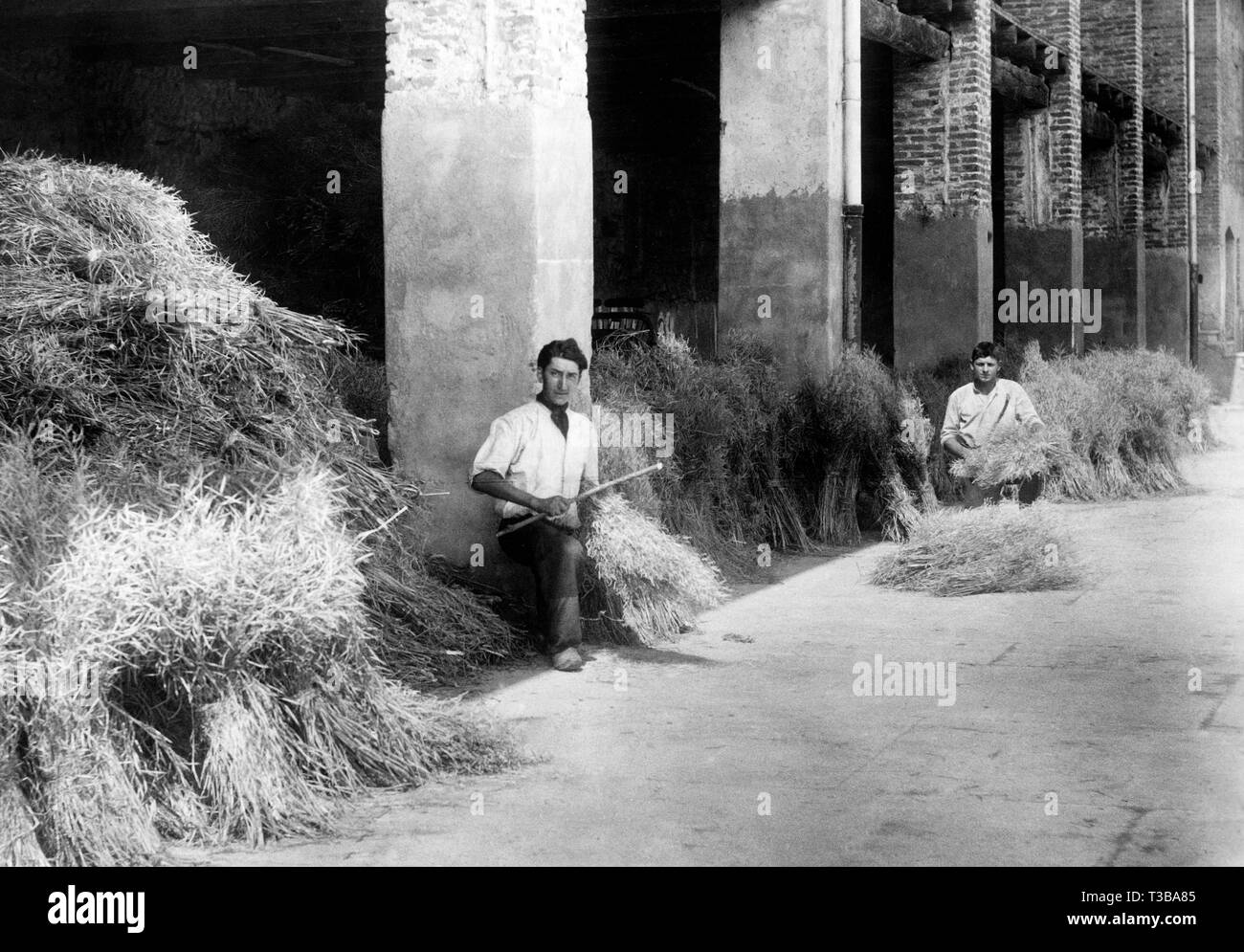 sericulture Stock Photohttps://www.alamy.com/image-license-details/?v=1https://www.alamy.com/sericulture-image243038661.html
sericulture Stock Photohttps://www.alamy.com/image-license-details/?v=1https://www.alamy.com/sericulture-image243038661.htmlRMT3BA85–sericulture
![[ 1900s Japan - Japanese Woman Feeding Silkworms ] — A woman is feeding mulberry leaves to silkworms. 20th century vintage glass slide. Stock Photo [ 1900s Japan - Japanese Woman Feeding Silkworms ] — A woman is feeding mulberry leaves to silkworms. 20th century vintage glass slide. Stock Photo](https://c8.alamy.com/comp/W26NDG/1900s-japan-japanese-woman-feeding-silkworms-a-woman-is-feeding-mulberry-leaves-to-silkworms-20th-century-vintage-glass-slide-W26NDG.jpg) [ 1900s Japan - Japanese Woman Feeding Silkworms ] — A woman is feeding mulberry leaves to silkworms. 20th century vintage glass slide. Stock Photohttps://www.alamy.com/image-license-details/?v=1https://www.alamy.com/1900s-japan-japanese-woman-feeding-silkworms-a-woman-is-feeding-mulberry-leaves-to-silkworms-20th-century-vintage-glass-slide-image259533388.html
[ 1900s Japan - Japanese Woman Feeding Silkworms ] — A woman is feeding mulberry leaves to silkworms. 20th century vintage glass slide. Stock Photohttps://www.alamy.com/image-license-details/?v=1https://www.alamy.com/1900s-japan-japanese-woman-feeding-silkworms-a-woman-is-feeding-mulberry-leaves-to-silkworms-20th-century-vintage-glass-slide-image259533388.htmlRMW26NDG–[ 1900s Japan - Japanese Woman Feeding Silkworms ] — A woman is feeding mulberry leaves to silkworms. 20th century vintage glass slide.
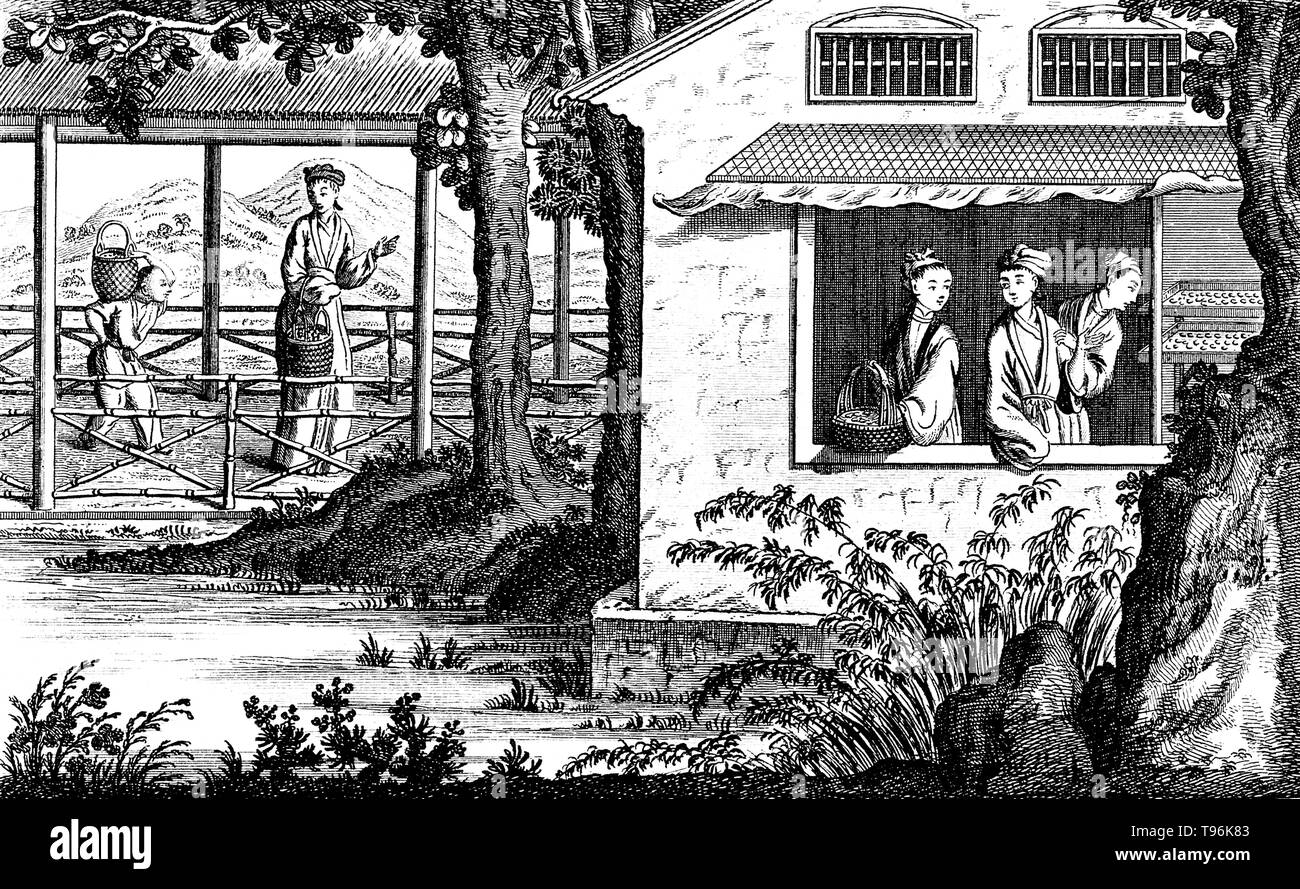 Textiles: silk manufacture in China, gathering the eggs. The production of silk originates in China in prehistoric times. Silk remained confined to China until the Silk Road opened at some point during the later half of the first millennium BC. China maintained its virtual monopoly over silk production for another thousand years. Sericulture, or silk farming, is the cultivation of silkworms to produce silk. Stock Photohttps://www.alamy.com/image-license-details/?v=1https://www.alamy.com/textiles-silk-manufacture-in-china-gathering-the-eggs-the-production-of-silk-originates-in-china-in-prehistoric-times-silk-remained-confined-to-china-until-the-silk-road-opened-at-some-point-during-the-later-half-of-the-first-millennium-bc-china-maintained-its-virtual-monopoly-over-silk-production-for-another-thousand-years-sericulture-or-silk-farming-is-the-cultivation-of-silkworms-to-produce-silk-image246623891.html
Textiles: silk manufacture in China, gathering the eggs. The production of silk originates in China in prehistoric times. Silk remained confined to China until the Silk Road opened at some point during the later half of the first millennium BC. China maintained its virtual monopoly over silk production for another thousand years. Sericulture, or silk farming, is the cultivation of silkworms to produce silk. Stock Photohttps://www.alamy.com/image-license-details/?v=1https://www.alamy.com/textiles-silk-manufacture-in-china-gathering-the-eggs-the-production-of-silk-originates-in-china-in-prehistoric-times-silk-remained-confined-to-china-until-the-silk-road-opened-at-some-point-during-the-later-half-of-the-first-millennium-bc-china-maintained-its-virtual-monopoly-over-silk-production-for-another-thousand-years-sericulture-or-silk-farming-is-the-cultivation-of-silkworms-to-produce-silk-image246623891.htmlRMT96K83–Textiles: silk manufacture in China, gathering the eggs. The production of silk originates in China in prehistoric times. Silk remained confined to China until the Silk Road opened at some point during the later half of the first millennium BC. China maintained its virtual monopoly over silk production for another thousand years. Sericulture, or silk farming, is the cultivation of silkworms to produce silk.
![[ c. 1900s Japan - Silk Industry ] — Separating cocoons from their nests. 20th century vintage glass slide. Stock Photo [ c. 1900s Japan - Silk Industry ] — Separating cocoons from their nests. 20th century vintage glass slide. Stock Photo](https://c8.alamy.com/comp/PGFHNM/c-1900s-japan-silk-industry-separating-cocoons-from-their-nests-20th-century-vintage-glass-slide-PGFHNM.jpg) [ c. 1900s Japan - Silk Industry ] — Separating cocoons from their nests. 20th century vintage glass slide. Stock Photohttps://www.alamy.com/image-license-details/?v=1https://www.alamy.com/c-1900s-japan-silk-industry-separating-cocoons-from-their-nests-20th-century-vintage-glass-slide-image216702128.html
[ c. 1900s Japan - Silk Industry ] — Separating cocoons from their nests. 20th century vintage glass slide. Stock Photohttps://www.alamy.com/image-license-details/?v=1https://www.alamy.com/c-1900s-japan-silk-industry-separating-cocoons-from-their-nests-20th-century-vintage-glass-slide-image216702128.htmlRMPGFHNM–[ c. 1900s Japan - Silk Industry ] — Separating cocoons from their nests. 20th century vintage glass slide.
 Milanówek, 1946. Centralna Doœwiadczalna Stacja Jedwabnicza. Zak³ad zajmowa³ siê hodowl¹ jedwabników i produkcj¹ tkanin. Za³o¿ony w 1924 r. przez Henryka i Stanis³awê Witaczków, po wojnie znacjonalizowany. Nz. hodowla jedwabników. gr PAP/Stanis³aw D¹browiecki Dok³adny miesi¹c i dzieñ wydarzenia nieustalone. Milanowek, 1946. Central Experimental Sericulture Station. The plant was involved in silkworm rearing and silk production. Established in 1924 by Henryk and Stanislawa Witczak, it was nationalised after the war. Pictured: the sericulture. gr PAP/Stanislaw Dabrowiecki Stock Photohttps://www.alamy.com/image-license-details/?v=1https://www.alamy.com/milanwek-1946-centralna-dowiadczalna-stacja-jedwabnicza-zakad-zajmowa-si-hodowl-jedwabnikw-i-produkcj-tkanin-zaoony-w-1924-r-przez-henryka-i-stanisaw-witaczkw-po-wojnie-znacjonalizowany-nz-hodowla-jedwabnikw-gr-papstanisaw-dbrowiecki-dokadny-miesic-i-dzie-wydarzenia-nieustalone-milanowek-1946-central-experimental-sericulture-station-the-plant-was-involved-in-silkworm-rearing-and-silk-production-established-in-1924-by-henryk-and-stanislawa-witczak-it-was-nationalised-after-the-war-pictured-the-sericulture-gr-papstanislaw-dabrowiecki-image452958626.html
Milanówek, 1946. Centralna Doœwiadczalna Stacja Jedwabnicza. Zak³ad zajmowa³ siê hodowl¹ jedwabników i produkcj¹ tkanin. Za³o¿ony w 1924 r. przez Henryka i Stanis³awê Witaczków, po wojnie znacjonalizowany. Nz. hodowla jedwabników. gr PAP/Stanis³aw D¹browiecki Dok³adny miesi¹c i dzieñ wydarzenia nieustalone. Milanowek, 1946. Central Experimental Sericulture Station. The plant was involved in silkworm rearing and silk production. Established in 1924 by Henryk and Stanislawa Witczak, it was nationalised after the war. Pictured: the sericulture. gr PAP/Stanislaw Dabrowiecki Stock Photohttps://www.alamy.com/image-license-details/?v=1https://www.alamy.com/milanwek-1946-centralna-dowiadczalna-stacja-jedwabnicza-zakad-zajmowa-si-hodowl-jedwabnikw-i-produkcj-tkanin-zaoony-w-1924-r-przez-henryka-i-stanisaw-witaczkw-po-wojnie-znacjonalizowany-nz-hodowla-jedwabnikw-gr-papstanisaw-dbrowiecki-dokadny-miesic-i-dzie-wydarzenia-nieustalone-milanowek-1946-central-experimental-sericulture-station-the-plant-was-involved-in-silkworm-rearing-and-silk-production-established-in-1924-by-henryk-and-stanislawa-witczak-it-was-nationalised-after-the-war-pictured-the-sericulture-gr-papstanislaw-dabrowiecki-image452958626.htmlRM2H8X19P–Milanówek, 1946. Centralna Doœwiadczalna Stacja Jedwabnicza. Zak³ad zajmowa³ siê hodowl¹ jedwabników i produkcj¹ tkanin. Za³o¿ony w 1924 r. przez Henryka i Stanis³awê Witaczków, po wojnie znacjonalizowany. Nz. hodowla jedwabników. gr PAP/Stanis³aw D¹browiecki Dok³adny miesi¹c i dzieñ wydarzenia nieustalone. Milanowek, 1946. Central Experimental Sericulture Station. The plant was involved in silkworm rearing and silk production. Established in 1924 by Henryk and Stanislawa Witczak, it was nationalised after the war. Pictured: the sericulture. gr PAP/Stanislaw Dabrowiecki
![[ c. 1900s USA - Silk Industry ] — Opening bales of raw silk at a warehouse in Manchester, Connecticut, USA. Raw silk was imported from Japan, China and Italy. 20th century vintage glass slide. Stock Photo [ c. 1900s USA - Silk Industry ] — Opening bales of raw silk at a warehouse in Manchester, Connecticut, USA. Raw silk was imported from Japan, China and Italy. 20th century vintage glass slide. Stock Photo](https://c8.alamy.com/comp/PGFHNC/c-1900s-usa-silk-industry-opening-bales-of-raw-silk-at-a-warehouse-in-manchester-connecticut-usa-raw-silk-was-imported-from-japan-china-and-italy-20th-century-vintage-glass-slide-PGFHNC.jpg) [ c. 1900s USA - Silk Industry ] — Opening bales of raw silk at a warehouse in Manchester, Connecticut, USA. Raw silk was imported from Japan, China and Italy. 20th century vintage glass slide. Stock Photohttps://www.alamy.com/image-license-details/?v=1https://www.alamy.com/c-1900s-usa-silk-industry-opening-bales-of-raw-silk-at-a-warehouse-in-manchester-connecticut-usa-raw-silk-was-imported-from-japan-china-and-italy-20th-century-vintage-glass-slide-image216702120.html
[ c. 1900s USA - Silk Industry ] — Opening bales of raw silk at a warehouse in Manchester, Connecticut, USA. Raw silk was imported from Japan, China and Italy. 20th century vintage glass slide. Stock Photohttps://www.alamy.com/image-license-details/?v=1https://www.alamy.com/c-1900s-usa-silk-industry-opening-bales-of-raw-silk-at-a-warehouse-in-manchester-connecticut-usa-raw-silk-was-imported-from-japan-china-and-italy-20th-century-vintage-glass-slide-image216702120.htmlRMPGFHNC–[ c. 1900s USA - Silk Industry ] — Opening bales of raw silk at a warehouse in Manchester, Connecticut, USA. Raw silk was imported from Japan, China and Italy. 20th century vintage glass slide.
 Planting mulberry trees for silkworms . 1936 . Stock Photohttps://www.alamy.com/image-license-details/?v=1https://www.alamy.com/planting-mulberry-trees-for-silkworms-1936-image359775162.html
Planting mulberry trees for silkworms . 1936 . Stock Photohttps://www.alamy.com/image-license-details/?v=1https://www.alamy.com/planting-mulberry-trees-for-silkworms-1936-image359775162.htmlRM2BW94TX–Planting mulberry trees for silkworms . 1936 .
![[ 1900s Japan - Japanese Women Feeding Silkworms ] — Two women feed silkworms with mulberry leaves. This glass slide published by the Keystone View Company was photographed by Julian Cochrane in 1904. 20th century vintage glass slide. Stock Photo [ 1900s Japan - Japanese Women Feeding Silkworms ] — Two women feed silkworms with mulberry leaves. This glass slide published by the Keystone View Company was photographed by Julian Cochrane in 1904. 20th century vintage glass slide. Stock Photo](https://c8.alamy.com/comp/W1Y9KR/1900s-japan-japanese-women-feeding-silkworms-two-women-feed-silkworms-with-mulberry-leaves-this-glass-slide-published-by-the-keystone-view-company-was-photographed-by-julian-cochrane-in-1904-20th-century-vintage-glass-slide-W1Y9KR.jpg) [ 1900s Japan - Japanese Women Feeding Silkworms ] — Two women feed silkworms with mulberry leaves. This glass slide published by the Keystone View Company was photographed by Julian Cochrane in 1904. 20th century vintage glass slide. Stock Photohttps://www.alamy.com/image-license-details/?v=1https://www.alamy.com/1900s-japan-japanese-women-feeding-silkworms-two-women-feed-silkworms-with-mulberry-leaves-this-glass-slide-published-by-the-keystone-view-company-was-photographed-by-julian-cochrane-in-1904-20th-century-vintage-glass-slide-image259370491.html
[ 1900s Japan - Japanese Women Feeding Silkworms ] — Two women feed silkworms with mulberry leaves. This glass slide published by the Keystone View Company was photographed by Julian Cochrane in 1904. 20th century vintage glass slide. Stock Photohttps://www.alamy.com/image-license-details/?v=1https://www.alamy.com/1900s-japan-japanese-women-feeding-silkworms-two-women-feed-silkworms-with-mulberry-leaves-this-glass-slide-published-by-the-keystone-view-company-was-photographed-by-julian-cochrane-in-1904-20th-century-vintage-glass-slide-image259370491.htmlRMW1Y9KR–[ 1900s Japan - Japanese Women Feeding Silkworms ] — Two women feed silkworms with mulberry leaves. This glass slide published by the Keystone View Company was photographed by Julian Cochrane in 1904. 20th century vintage glass slide.
 Feeding silkworms, 18th century(?). Artist: Unknown Stock Photohttps://www.alamy.com/image-license-details/?v=1https://www.alamy.com/feeding-silkworms-18th-century-artist-unknown-image262768432.html
Feeding silkworms, 18th century(?). Artist: Unknown Stock Photohttps://www.alamy.com/image-license-details/?v=1https://www.alamy.com/feeding-silkworms-18th-century-artist-unknown-image262768432.htmlRMW7E3PT–Feeding silkworms, 18th century(?). Artist: Unknown
![[ 1900s Japan - Silkworm Incubator ] — A woman and a man work with a silkworm incubator. 20th century vintage glass slide. Stock Photo [ 1900s Japan - Silkworm Incubator ] — A woman and a man work with a silkworm incubator. 20th century vintage glass slide. Stock Photo](https://c8.alamy.com/comp/W140B4/1900s-japan-silkworm-incubator-a-woman-and-a-man-work-with-a-silkworm-incubator-20th-century-vintage-glass-slide-W140B4.jpg) [ 1900s Japan - Silkworm Incubator ] — A woman and a man work with a silkworm incubator. 20th century vintage glass slide. Stock Photohttps://www.alamy.com/image-license-details/?v=1https://www.alamy.com/1900s-japan-silkworm-incubator-a-woman-and-a-man-work-with-a-silkworm-incubator-20th-century-vintage-glass-slide-image258858296.html
[ 1900s Japan - Silkworm Incubator ] — A woman and a man work with a silkworm incubator. 20th century vintage glass slide. Stock Photohttps://www.alamy.com/image-license-details/?v=1https://www.alamy.com/1900s-japan-silkworm-incubator-a-woman-and-a-man-work-with-a-silkworm-incubator-20th-century-vintage-glass-slide-image258858296.htmlRMW140B4–[ 1900s Japan - Silkworm Incubator ] — A woman and a man work with a silkworm incubator. 20th century vintage glass slide.
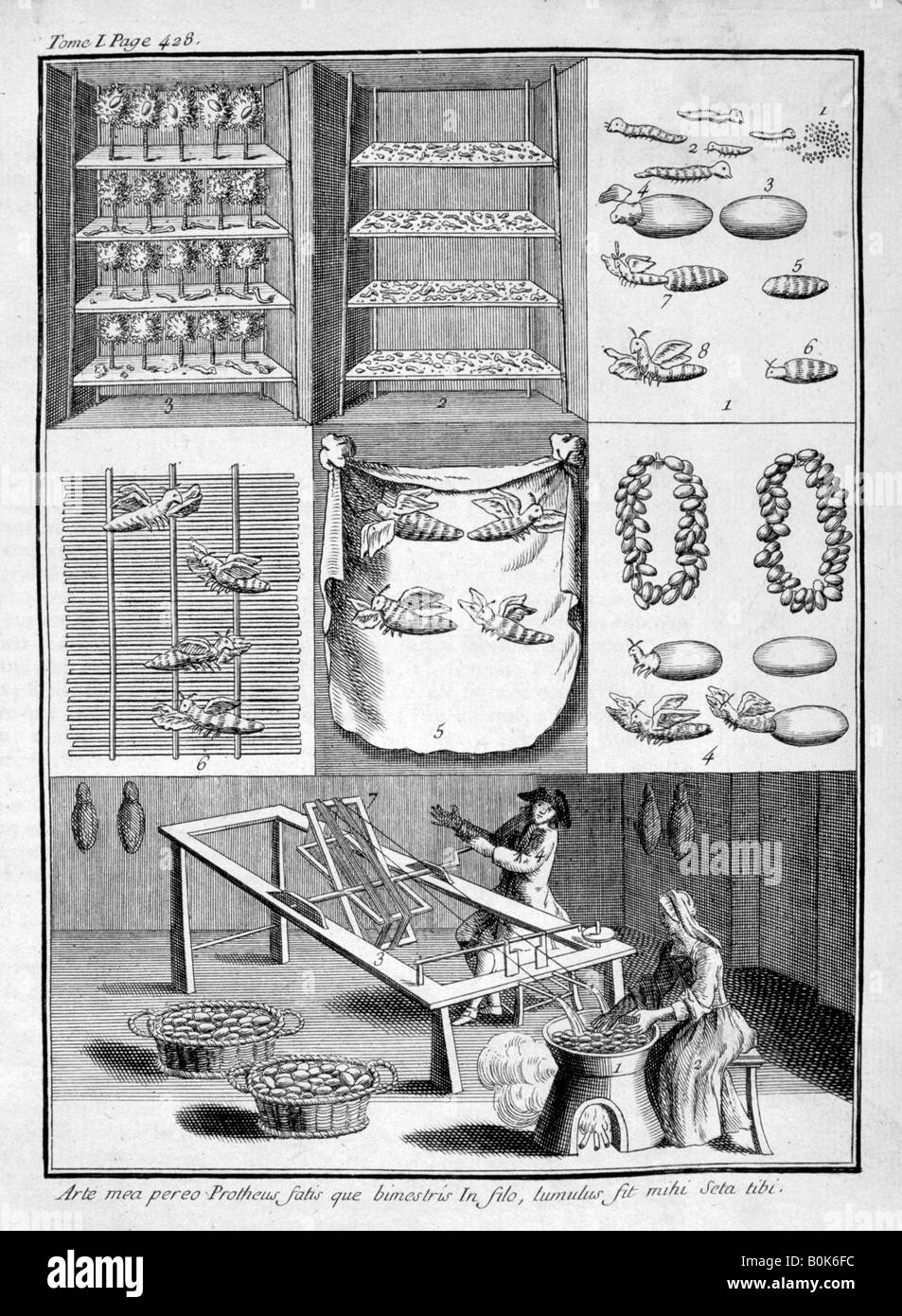 The breeding of silk worms, 1775. Artist: Unknown Stock Photohttps://www.alamy.com/image-license-details/?v=1https://www.alamy.com/stock-photo-the-breeding-of-silk-worms-1775-artist-unknown-17632592.html
The breeding of silk worms, 1775. Artist: Unknown Stock Photohttps://www.alamy.com/image-license-details/?v=1https://www.alamy.com/stock-photo-the-breeding-of-silk-worms-1775-artist-unknown-17632592.htmlRMB0K6FC–The breeding of silk worms, 1775. Artist: Unknown
![Samuel R. Lowery; [Silk culturist], 1897. African-American preacher and lawyer, first black lawyer to argue a case before the Supreme Court of the USA. Worked for African American industrial education and attempted to establish silk farming in Alabama. From 'The white side of a black subject, enlarged and brought down to date; a vindication of the Afro-American race; from the landing of slaves at St. Augustine, Florida, in 1565, to the present time'. Stock Photo Samuel R. Lowery; [Silk culturist], 1897. African-American preacher and lawyer, first black lawyer to argue a case before the Supreme Court of the USA. Worked for African American industrial education and attempted to establish silk farming in Alabama. From 'The white side of a black subject, enlarged and brought down to date; a vindication of the Afro-American race; from the landing of slaves at St. Augustine, Florida, in 1565, to the present time'. Stock Photo](https://c8.alamy.com/comp/2MBH5ER/samuel-r-lowery-silk-culturist-1897-african-american-preacher-and-lawyer-first-black-lawyer-to-argue-a-case-before-the-supreme-court-of-the-usa-worked-for-african-american-industrial-education-and-attempted-to-establish-silk-farming-in-alabama-from-the-white-side-of-a-black-subject-enlarged-and-brought-down-to-date-a-vindication-of-the-afro-american-race-from-the-landing-of-slaves-at-st-augustine-florida-in-1565-to-the-present-time-2MBH5ER.jpg) Samuel R. Lowery; [Silk culturist], 1897. African-American preacher and lawyer, first black lawyer to argue a case before the Supreme Court of the USA. Worked for African American industrial education and attempted to establish silk farming in Alabama. From 'The white side of a black subject, enlarged and brought down to date; a vindication of the Afro-American race; from the landing of slaves at St. Augustine, Florida, in 1565, to the present time'. Stock Photohttps://www.alamy.com/image-license-details/?v=1https://www.alamy.com/samuel-r-lowery-silk-culturist-1897-african-american-preacher-and-lawyer-first-black-lawyer-to-argue-a-case-before-the-supreme-court-of-the-usa-worked-for-african-american-industrial-education-and-attempted-to-establish-silk-farming-in-alabama-from-the-white-side-of-a-black-subject-enlarged-and-brought-down-to-date-a-vindication-of-the-afro-american-race-from-the-landing-of-slaves-at-st-augustine-florida-in-1565-to-the-present-time-image506239407.html
Samuel R. Lowery; [Silk culturist], 1897. African-American preacher and lawyer, first black lawyer to argue a case before the Supreme Court of the USA. Worked for African American industrial education and attempted to establish silk farming in Alabama. From 'The white side of a black subject, enlarged and brought down to date; a vindication of the Afro-American race; from the landing of slaves at St. Augustine, Florida, in 1565, to the present time'. Stock Photohttps://www.alamy.com/image-license-details/?v=1https://www.alamy.com/samuel-r-lowery-silk-culturist-1897-african-american-preacher-and-lawyer-first-black-lawyer-to-argue-a-case-before-the-supreme-court-of-the-usa-worked-for-african-american-industrial-education-and-attempted-to-establish-silk-farming-in-alabama-from-the-white-side-of-a-black-subject-enlarged-and-brought-down-to-date-a-vindication-of-the-afro-american-race-from-the-landing-of-slaves-at-st-augustine-florida-in-1565-to-the-present-time-image506239407.htmlRM2MBH5ER–Samuel R. Lowery; [Silk culturist], 1897. African-American preacher and lawyer, first black lawyer to argue a case before the Supreme Court of the USA. Worked for African American industrial education and attempted to establish silk farming in Alabama. From 'The white side of a black subject, enlarged and brought down to date; a vindication of the Afro-American race; from the landing of slaves at St. Augustine, Florida, in 1565, to the present time'.
RF2JGKTCF–silk cocoon icon .
RF2HCFY06–Sericulture Production Business Icons Set Vector
 Nascent silk worm, vintage engraved illustration. Magasin Pittoresque 1845. Stock Photohttps://www.alamy.com/image-license-details/?v=1https://www.alamy.com/nascent-silk-worm-vintage-engraved-illustration-magasin-pittoresque-1845-image363135574.html
Nascent silk worm, vintage engraved illustration. Magasin Pittoresque 1845. Stock Photohttps://www.alamy.com/image-license-details/?v=1https://www.alamy.com/nascent-silk-worm-vintage-engraved-illustration-magasin-pittoresque-1845-image363135574.htmlRF2C2P73J–Nascent silk worm, vintage engraved illustration. Magasin Pittoresque 1845.
RF2PX31FM–Silkworm black line icon. Farm animals. Pictogram for web page, mobile app, promo.
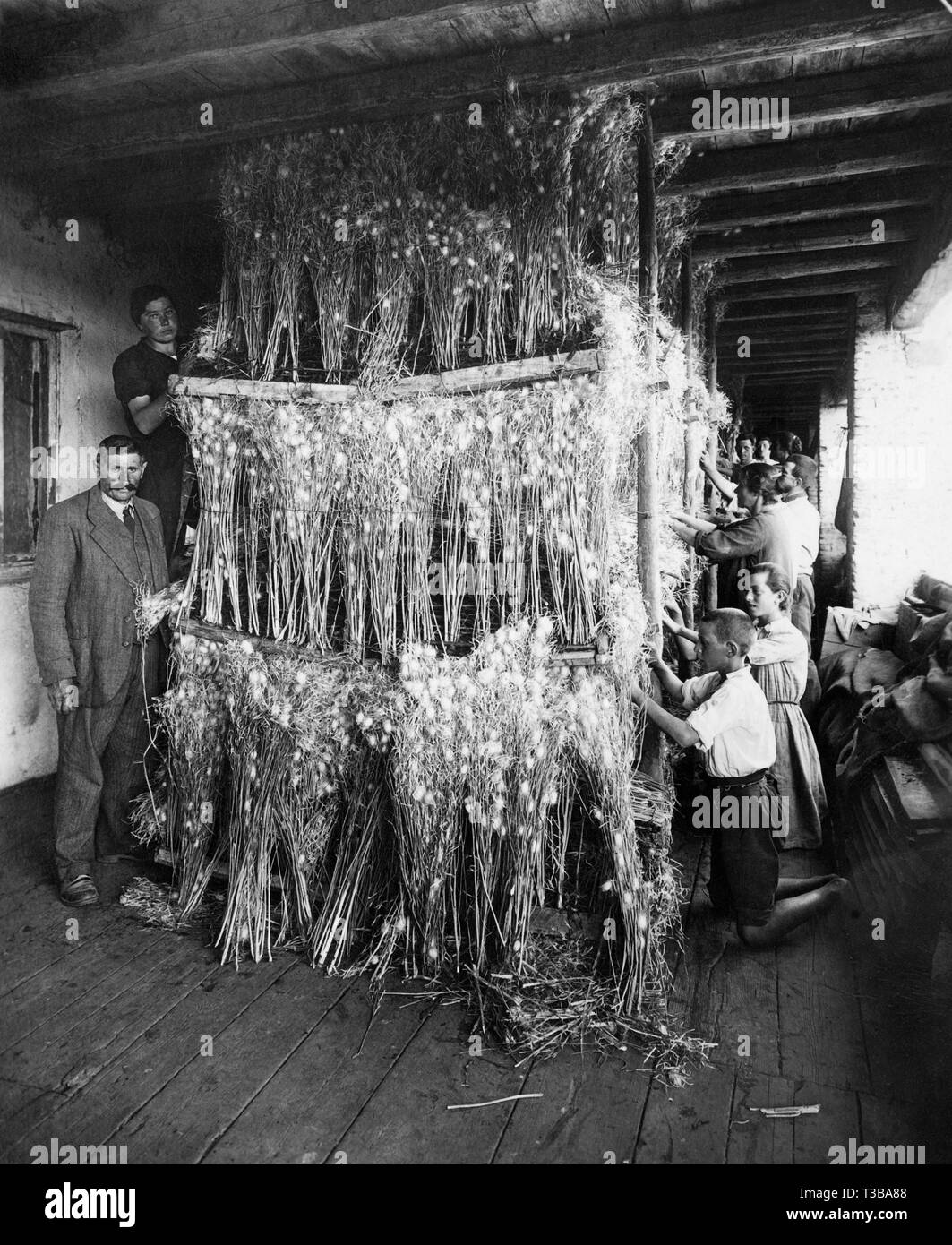 sericulture Stock Photohttps://www.alamy.com/image-license-details/?v=1https://www.alamy.com/sericulture-image243038664.html
sericulture Stock Photohttps://www.alamy.com/image-license-details/?v=1https://www.alamy.com/sericulture-image243038664.htmlRMT3BA88–sericulture
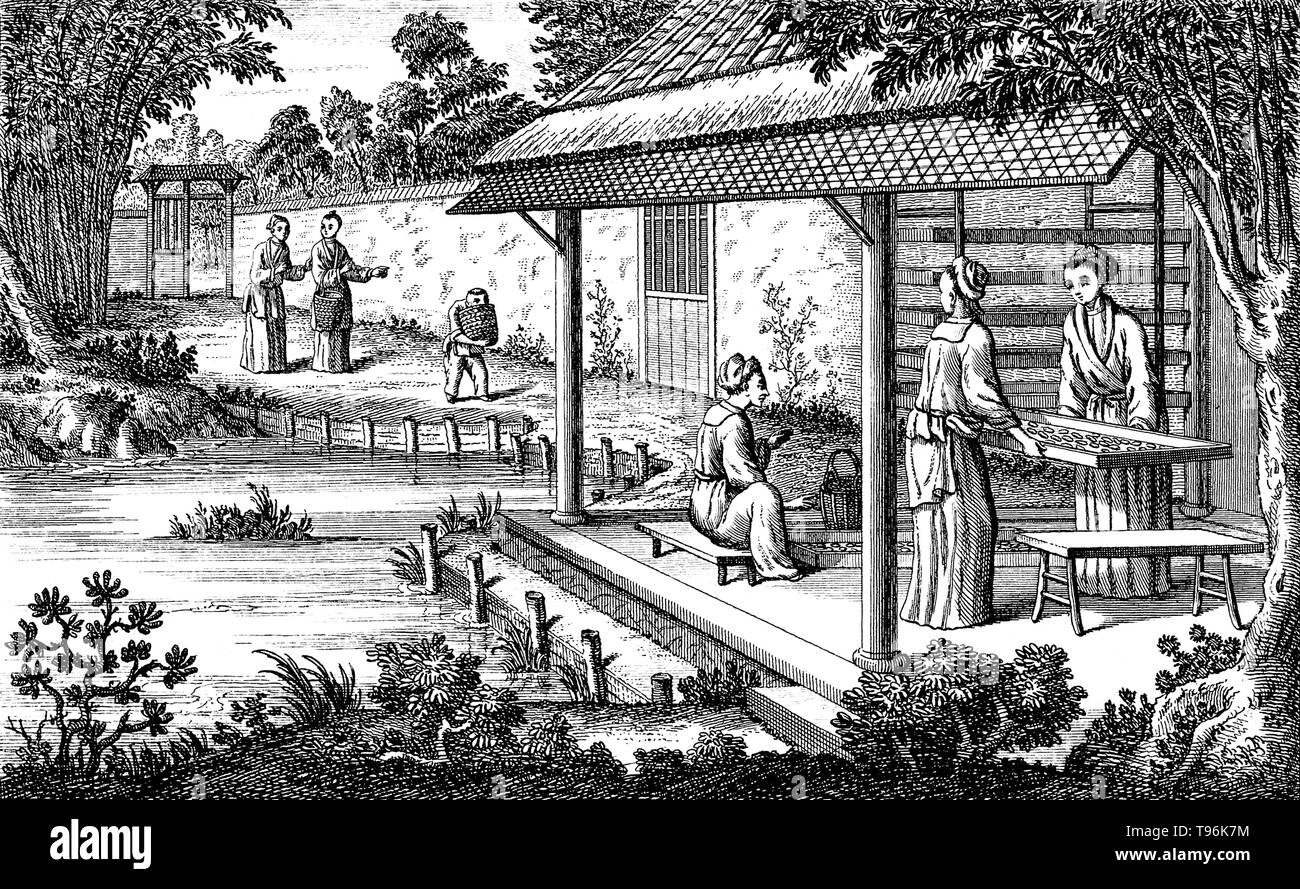 Textiles: silk manufacture in China, feeding the silkworms. The production of silk originates in China in prehistoric times. Silk remained confined to China until the Silk Road opened at some point during the later half of the first millennium BC. China maintained its virtual monopoly over silk production for another thousand years. Sericulture, or silk farming, is the cultivation of silkworms to produce silk. Stock Photohttps://www.alamy.com/image-license-details/?v=1https://www.alamy.com/textiles-silk-manufacture-in-china-feeding-the-silkworms-the-production-of-silk-originates-in-china-in-prehistoric-times-silk-remained-confined-to-china-until-the-silk-road-opened-at-some-point-during-the-later-half-of-the-first-millennium-bc-china-maintained-its-virtual-monopoly-over-silk-production-for-another-thousand-years-sericulture-or-silk-farming-is-the-cultivation-of-silkworms-to-produce-silk-image246623880.html
Textiles: silk manufacture in China, feeding the silkworms. The production of silk originates in China in prehistoric times. Silk remained confined to China until the Silk Road opened at some point during the later half of the first millennium BC. China maintained its virtual monopoly over silk production for another thousand years. Sericulture, or silk farming, is the cultivation of silkworms to produce silk. Stock Photohttps://www.alamy.com/image-license-details/?v=1https://www.alamy.com/textiles-silk-manufacture-in-china-feeding-the-silkworms-the-production-of-silk-originates-in-china-in-prehistoric-times-silk-remained-confined-to-china-until-the-silk-road-opened-at-some-point-during-the-later-half-of-the-first-millennium-bc-china-maintained-its-virtual-monopoly-over-silk-production-for-another-thousand-years-sericulture-or-silk-farming-is-the-cultivation-of-silkworms-to-produce-silk-image246623880.htmlRMT96K7M–Textiles: silk manufacture in China, feeding the silkworms. The production of silk originates in China in prehistoric times. Silk remained confined to China until the Silk Road opened at some point during the later half of the first millennium BC. China maintained its virtual monopoly over silk production for another thousand years. Sericulture, or silk farming, is the cultivation of silkworms to produce silk.
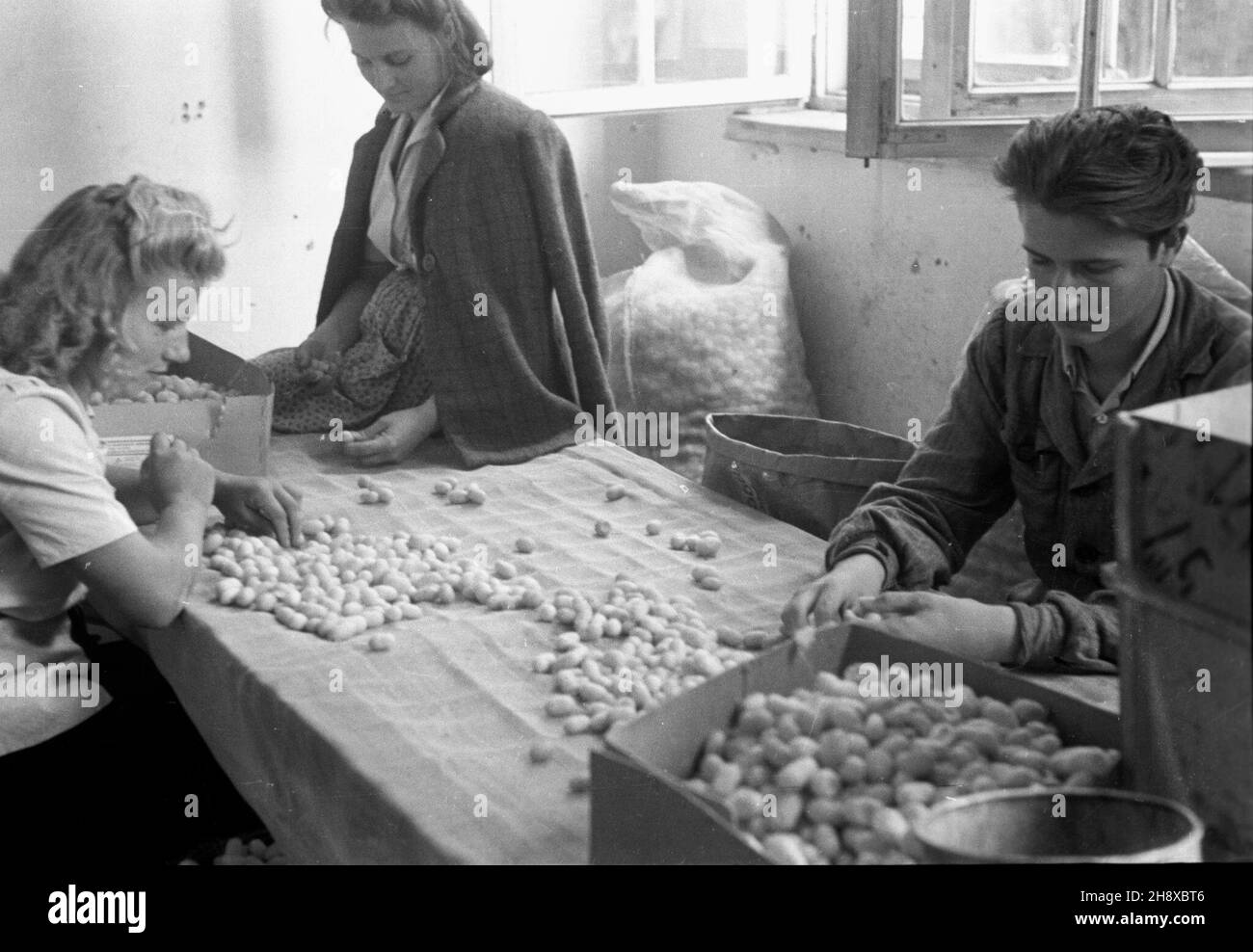 Milanówek, 1946. Centralna Doœwiadczalna Stacja Jedwabnicza. Zak³ad zajmowa³ siê hodowl¹ jedwabników i produkcj¹ tkanin. Za³o¿ony w 1924 r. przez Henryka i Stanis³awê Witaczków, po wojnie znacjonalizowany.Nz. sortowanie kokonów-k³êbuszków czyli jedwabnych oprzêdów. gr PAP/Stanis³aw D¹browiecki Dok³adny miesi¹c i dzieñ wydarzenia nieustalone. Milanowek, 1946. Central Experimental Sericulture Station. The plant was involved in silkworm rearing and silk production. Established in 1924 by Henryk and Stanislawa Witczak, it was nationalised after the war. Pictured: cocoon sorting. gr PAP/ Stock Photohttps://www.alamy.com/image-license-details/?v=1https://www.alamy.com/milanwek-1946-centralna-dowiadczalna-stacja-jedwabnicza-zakad-zajmowa-si-hodowl-jedwabnikw-i-produkcj-tkanin-zaoony-w-1924-r-przez-henryka-i-stanisaw-witaczkw-po-wojnie-znacjonalizowanynz-sortowanie-kokonw-kbuszkw-czyli-jedwabnych-oprzdw-gr-papstanisaw-dbrowiecki-dokadny-miesic-i-dzie-wydarzenia-nieustalone-milanowek-1946-central-experimental-sericulture-station-the-plant-was-involved-in-silkworm-rearing-and-silk-production-established-in-1924-by-henryk-and-stanislawa-witczak-it-was-nationalised-after-the-war-pictured-cocoon-sorting-gr-pap-image452966870.html
Milanówek, 1946. Centralna Doœwiadczalna Stacja Jedwabnicza. Zak³ad zajmowa³ siê hodowl¹ jedwabników i produkcj¹ tkanin. Za³o¿ony w 1924 r. przez Henryka i Stanis³awê Witaczków, po wojnie znacjonalizowany.Nz. sortowanie kokonów-k³êbuszków czyli jedwabnych oprzêdów. gr PAP/Stanis³aw D¹browiecki Dok³adny miesi¹c i dzieñ wydarzenia nieustalone. Milanowek, 1946. Central Experimental Sericulture Station. The plant was involved in silkworm rearing and silk production. Established in 1924 by Henryk and Stanislawa Witczak, it was nationalised after the war. Pictured: cocoon sorting. gr PAP/ Stock Photohttps://www.alamy.com/image-license-details/?v=1https://www.alamy.com/milanwek-1946-centralna-dowiadczalna-stacja-jedwabnicza-zakad-zajmowa-si-hodowl-jedwabnikw-i-produkcj-tkanin-zaoony-w-1924-r-przez-henryka-i-stanisaw-witaczkw-po-wojnie-znacjonalizowanynz-sortowanie-kokonw-kbuszkw-czyli-jedwabnych-oprzdw-gr-papstanisaw-dbrowiecki-dokadny-miesic-i-dzie-wydarzenia-nieustalone-milanowek-1946-central-experimental-sericulture-station-the-plant-was-involved-in-silkworm-rearing-and-silk-production-established-in-1924-by-henryk-and-stanislawa-witczak-it-was-nationalised-after-the-war-pictured-cocoon-sorting-gr-pap-image452966870.htmlRM2H8XBT6–Milanówek, 1946. Centralna Doœwiadczalna Stacja Jedwabnicza. Zak³ad zajmowa³ siê hodowl¹ jedwabników i produkcj¹ tkanin. Za³o¿ony w 1924 r. przez Henryka i Stanis³awê Witaczków, po wojnie znacjonalizowany.Nz. sortowanie kokonów-k³êbuszków czyli jedwabnych oprzêdów. gr PAP/Stanis³aw D¹browiecki Dok³adny miesi¹c i dzieñ wydarzenia nieustalone. Milanowek, 1946. Central Experimental Sericulture Station. The plant was involved in silkworm rearing and silk production. Established in 1924 by Henryk and Stanislawa Witczak, it was nationalised after the war. Pictured: cocoon sorting. gr PAP/
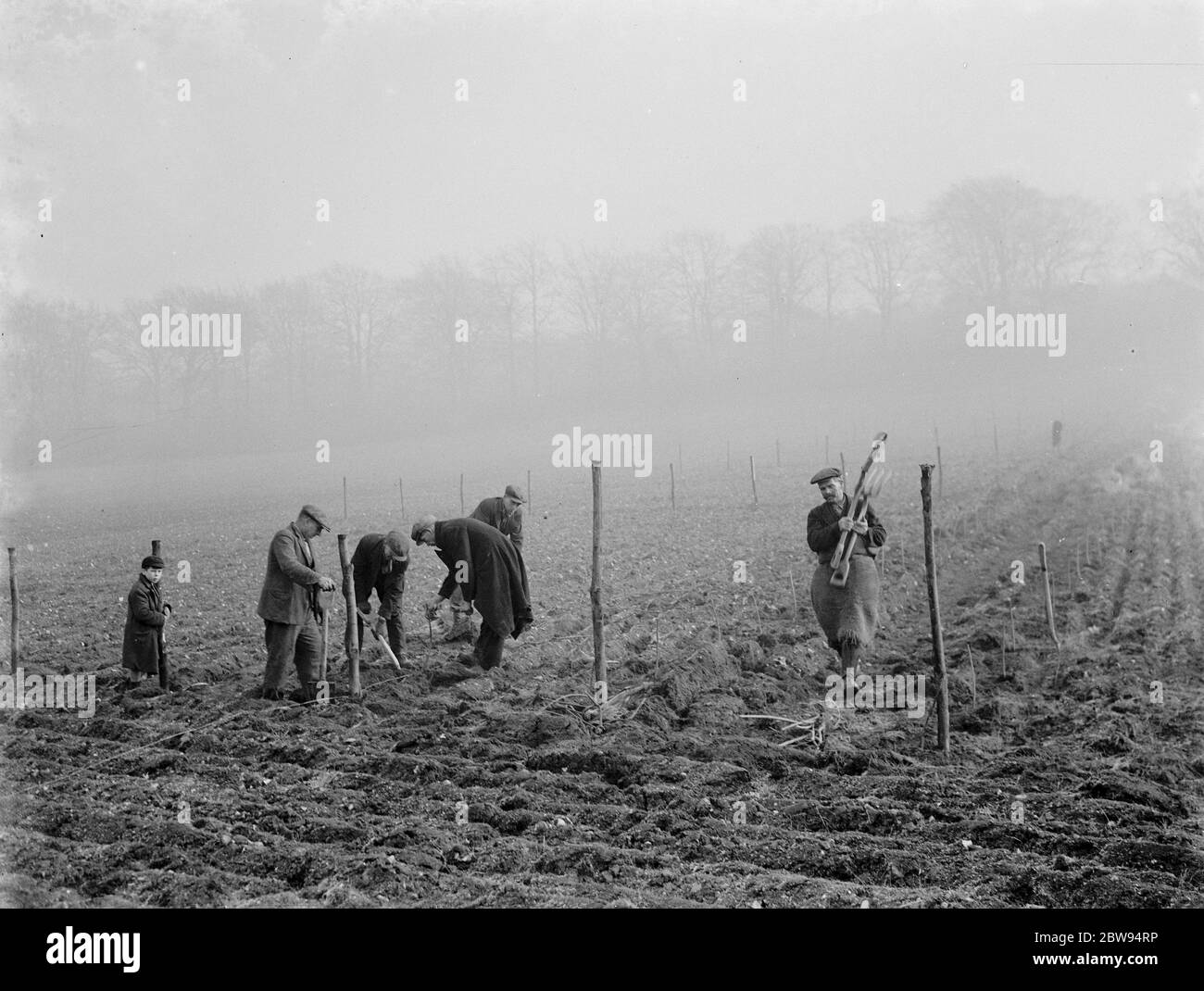 Planting mulberry trees for silkworms . 1936 . Stock Photohttps://www.alamy.com/image-license-details/?v=1https://www.alamy.com/planting-mulberry-trees-for-silkworms-1936-image359775130.html
Planting mulberry trees for silkworms . 1936 . Stock Photohttps://www.alamy.com/image-license-details/?v=1https://www.alamy.com/planting-mulberry-trees-for-silkworms-1936-image359775130.htmlRM2BW94RP–Planting mulberry trees for silkworms . 1936 .
![[ 1900s Japan - Woman Reeling Silk ] — A woman in yukata and traditional hairstyle is hand reeling silk from cocoons. 20th century vintage glass slide Stock Photo [ 1900s Japan - Woman Reeling Silk ] — A woman in yukata and traditional hairstyle is hand reeling silk from cocoons. 20th century vintage glass slide Stock Photo](https://c8.alamy.com/comp/PH0FD4/1900s-japan-woman-reeling-silk-a-woman-in-yukata-and-traditional-hairstyle-is-hand-reeling-silk-from-cocoons-20th-century-vintage-glass-slide-PH0FD4.jpg) [ 1900s Japan - Woman Reeling Silk ] — A woman in yukata and traditional hairstyle is hand reeling silk from cocoons. 20th century vintage glass slide Stock Photohttps://www.alamy.com/image-license-details/?v=1https://www.alamy.com/1900s-japan-woman-reeling-silk-a-woman-in-yukata-and-traditional-hairstyle-is-hand-reeling-silk-from-cocoons-20th-century-vintage-glass-slide-image216985696.html
[ 1900s Japan - Woman Reeling Silk ] — A woman in yukata and traditional hairstyle is hand reeling silk from cocoons. 20th century vintage glass slide Stock Photohttps://www.alamy.com/image-license-details/?v=1https://www.alamy.com/1900s-japan-woman-reeling-silk-a-woman-in-yukata-and-traditional-hairstyle-is-hand-reeling-silk-from-cocoons-20th-century-vintage-glass-slide-image216985696.htmlRMPH0FD4–[ 1900s Japan - Woman Reeling Silk ] — A woman in yukata and traditional hairstyle is hand reeling silk from cocoons. 20th century vintage glass slide
 Sericulture Production Business Vector Seamless Pattern Stock Vectorhttps://www.alamy.com/image-license-details/?v=1https://www.alamy.com/sericulture-production-business-vector-seamless-pattern-image464764915.html
Sericulture Production Business Vector Seamless Pattern Stock Vectorhttps://www.alamy.com/image-license-details/?v=1https://www.alamy.com/sericulture-production-business-vector-seamless-pattern-image464764915.htmlRF2J03TAY–Sericulture Production Business Vector Seamless Pattern
 Worm at the end of the fourth age, vintage engraved illustration. Magasin Pittoresque 1845. Stock Photohttps://www.alamy.com/image-license-details/?v=1https://www.alamy.com/worm-at-the-end-of-the-fourth-age-vintage-engraved-illustration-magasin-pittoresque-1845-image363145772.html
Worm at the end of the fourth age, vintage engraved illustration. Magasin Pittoresque 1845. Stock Photohttps://www.alamy.com/image-license-details/?v=1https://www.alamy.com/worm-at-the-end-of-the-fourth-age-vintage-engraved-illustration-magasin-pittoresque-1845-image363145772.htmlRF2C2PM3T–Worm at the end of the fourth age, vintage engraved illustration. Magasin Pittoresque 1845.
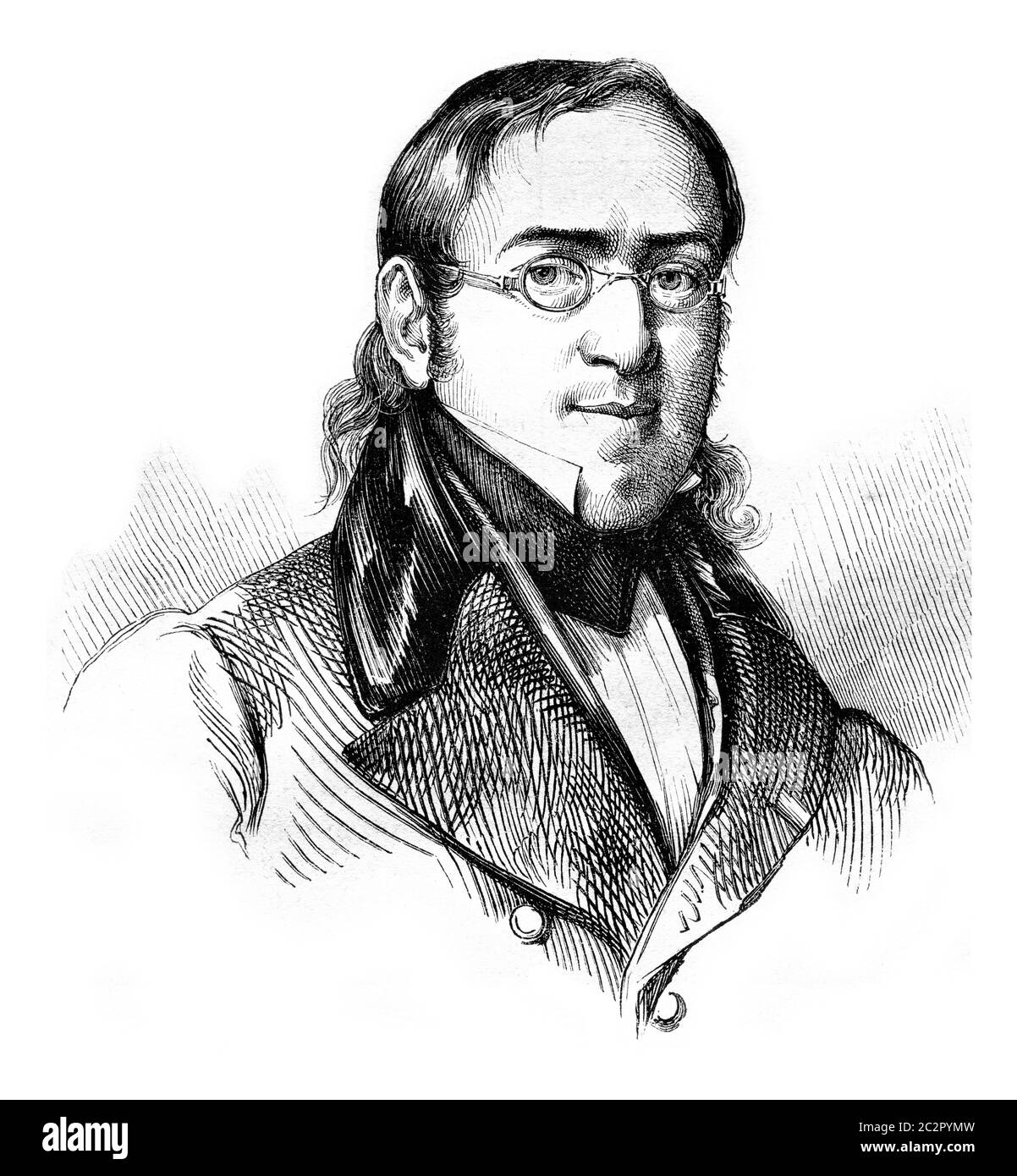 Matthew Bonafous, vintage engraved illustration. Magasin Pittoresque 1857. Stock Photohttps://www.alamy.com/image-license-details/?v=1https://www.alamy.com/matthew-bonafous-vintage-engraved-illustration-magasin-pittoresque-1857-image363151737.html
Matthew Bonafous, vintage engraved illustration. Magasin Pittoresque 1857. Stock Photohttps://www.alamy.com/image-license-details/?v=1https://www.alamy.com/matthew-bonafous-vintage-engraved-illustration-magasin-pittoresque-1857-image363151737.htmlRF2C2PYMW–Matthew Bonafous, vintage engraved illustration. Magasin Pittoresque 1857.
 Worm at the end of the second age, vintage engraved illustration. Magasin Pittoresque 1845. Stock Photohttps://www.alamy.com/image-license-details/?v=1https://www.alamy.com/worm-at-the-end-of-the-second-age-vintage-engraved-illustration-magasin-pittoresque-1845-image363135450.html
Worm at the end of the second age, vintage engraved illustration. Magasin Pittoresque 1845. Stock Photohttps://www.alamy.com/image-license-details/?v=1https://www.alamy.com/worm-at-the-end-of-the-second-age-vintage-engraved-illustration-magasin-pittoresque-1845-image363135450.htmlRF2C2P6Y6–Worm at the end of the second age, vintage engraved illustration. Magasin Pittoresque 1845.
 leaves, preparation for silkworm Stock Photohttps://www.alamy.com/image-license-details/?v=1https://www.alamy.com/leaves-preparation-for-silkworm-image243038646.html
leaves, preparation for silkworm Stock Photohttps://www.alamy.com/image-license-details/?v=1https://www.alamy.com/leaves-preparation-for-silkworm-image243038646.htmlRMT3BA7J–leaves, preparation for silkworm
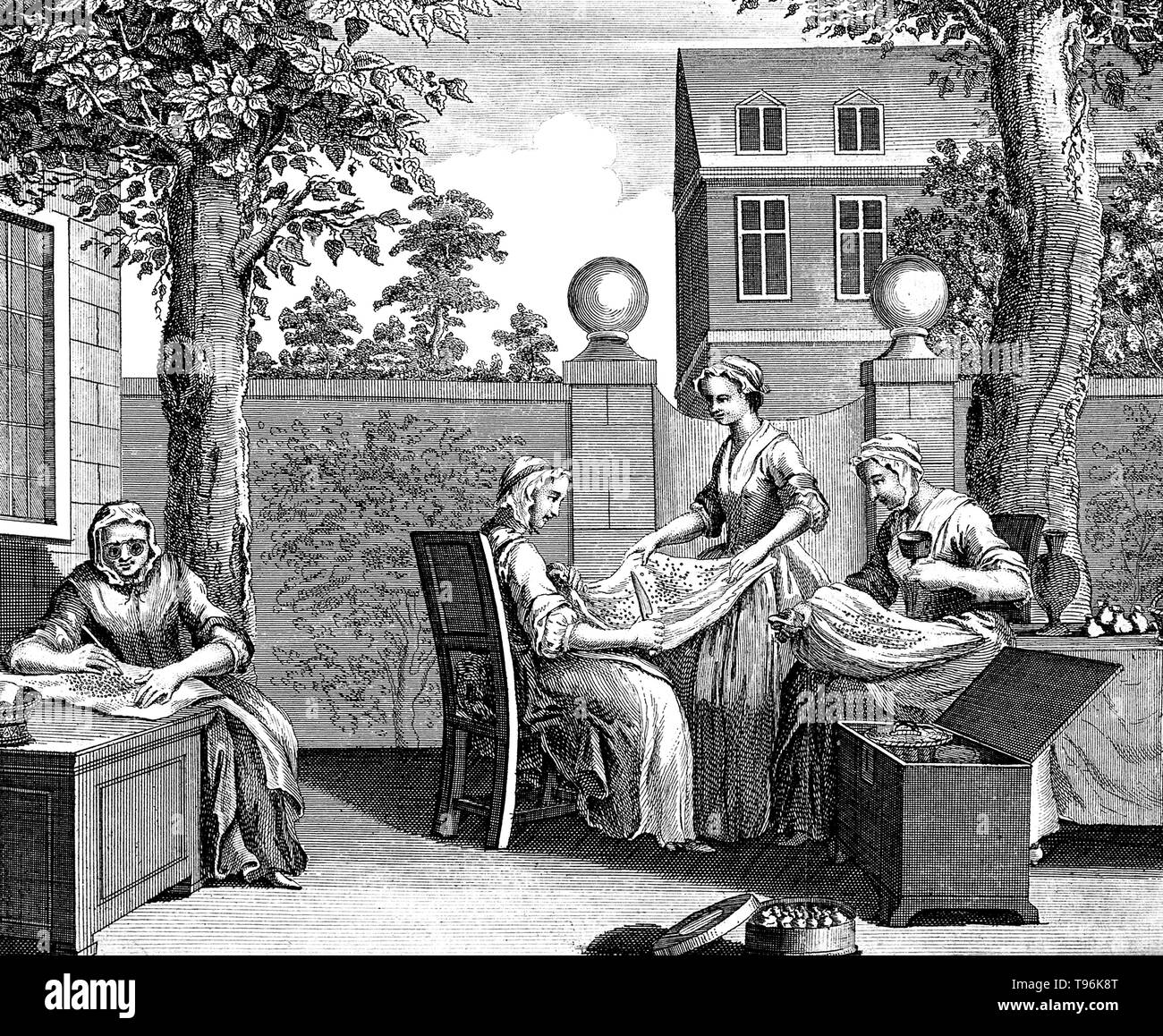 Textiles: women in a garden sorting silkworm eggs for incubation. The production of silk originates in China in prehistoric times. Silk remained confined to China until the Silk Road opened at some point during the later half of the first millennium BC. China maintained its virtual monopoly over silk production for another thousand years. Sericulture, or silk farming, is the cultivation of silkworms to produce silk. Stock Photohttps://www.alamy.com/image-license-details/?v=1https://www.alamy.com/textiles-women-in-a-garden-sorting-silkworm-eggs-for-incubation-the-production-of-silk-originates-in-china-in-prehistoric-times-silk-remained-confined-to-china-until-the-silk-road-opened-at-some-point-during-the-later-half-of-the-first-millennium-bc-china-maintained-its-virtual-monopoly-over-silk-production-for-another-thousand-years-sericulture-or-silk-farming-is-the-cultivation-of-silkworms-to-produce-silk-image246623912.html
Textiles: women in a garden sorting silkworm eggs for incubation. The production of silk originates in China in prehistoric times. Silk remained confined to China until the Silk Road opened at some point during the later half of the first millennium BC. China maintained its virtual monopoly over silk production for another thousand years. Sericulture, or silk farming, is the cultivation of silkworms to produce silk. Stock Photohttps://www.alamy.com/image-license-details/?v=1https://www.alamy.com/textiles-women-in-a-garden-sorting-silkworm-eggs-for-incubation-the-production-of-silk-originates-in-china-in-prehistoric-times-silk-remained-confined-to-china-until-the-silk-road-opened-at-some-point-during-the-later-half-of-the-first-millennium-bc-china-maintained-its-virtual-monopoly-over-silk-production-for-another-thousand-years-sericulture-or-silk-farming-is-the-cultivation-of-silkworms-to-produce-silk-image246623912.htmlRMT96K8T–Textiles: women in a garden sorting silkworm eggs for incubation. The production of silk originates in China in prehistoric times. Silk remained confined to China until the Silk Road opened at some point during the later half of the first millennium BC. China maintained its virtual monopoly over silk production for another thousand years. Sericulture, or silk farming, is the cultivation of silkworms to produce silk.
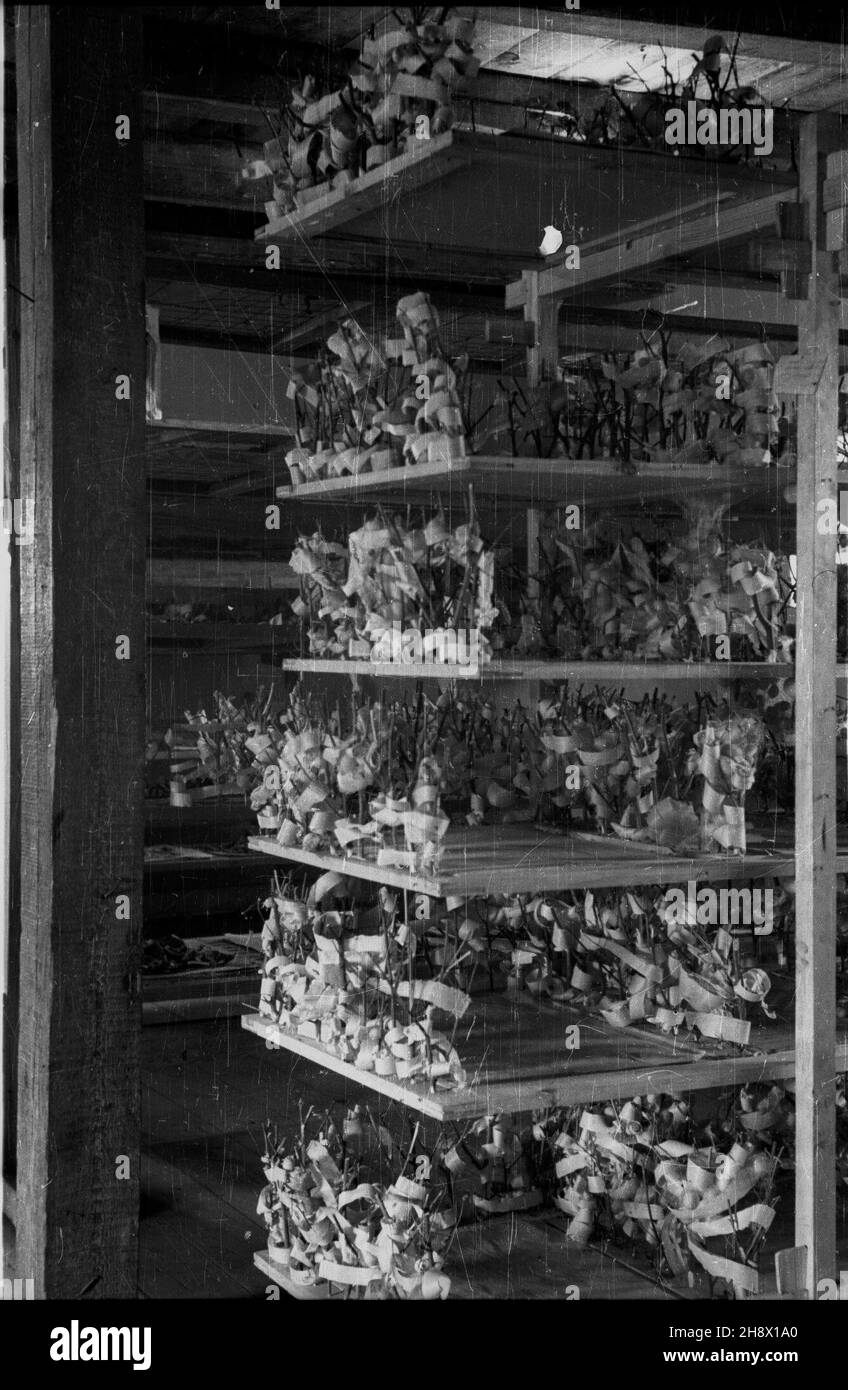 Milanówek, 1946. Centralna Doœwiadczalna Stacja Jedwabnicza. Zak³ad zajmowa³ siê hodowl¹ jedwabników i produkcj¹ tkanin. Za³o¿ony w 1924 r. przez Henryka i Stanis³awê Witaczków, po wojnie znacjonalizowany. Nz. hodowla jedwabników. gr PAP/Stanis³aw D¹browiecki Dok³adny miesi¹c i dzieñ wydarzenia nieustalone. Milanowek, 1946. Central Experimental Sericulture Station. The plant was involved in silkworm rearing and silk production. Established in 1924 by Henryk and Stanislawa Witczak, it was nationalised after the war. Pictured: the sericulture. gr PAP/Stanislaw Dabrowiecki Stock Photohttps://www.alamy.com/image-license-details/?v=1https://www.alamy.com/milanwek-1946-centralna-dowiadczalna-stacja-jedwabnicza-zakad-zajmowa-si-hodowl-jedwabnikw-i-produkcj-tkanin-zaoony-w-1924-r-przez-henryka-i-stanisaw-witaczkw-po-wojnie-znacjonalizowany-nz-hodowla-jedwabnikw-gr-papstanisaw-dbrowiecki-dokadny-miesic-i-dzie-wydarzenia-nieustalone-milanowek-1946-central-experimental-sericulture-station-the-plant-was-involved-in-silkworm-rearing-and-silk-production-established-in-1924-by-henryk-and-stanislawa-witczak-it-was-nationalised-after-the-war-pictured-the-sericulture-gr-papstanislaw-dabrowiecki-image452958632.html
Milanówek, 1946. Centralna Doœwiadczalna Stacja Jedwabnicza. Zak³ad zajmowa³ siê hodowl¹ jedwabników i produkcj¹ tkanin. Za³o¿ony w 1924 r. przez Henryka i Stanis³awê Witaczków, po wojnie znacjonalizowany. Nz. hodowla jedwabników. gr PAP/Stanis³aw D¹browiecki Dok³adny miesi¹c i dzieñ wydarzenia nieustalone. Milanowek, 1946. Central Experimental Sericulture Station. The plant was involved in silkworm rearing and silk production. Established in 1924 by Henryk and Stanislawa Witczak, it was nationalised after the war. Pictured: the sericulture. gr PAP/Stanislaw Dabrowiecki Stock Photohttps://www.alamy.com/image-license-details/?v=1https://www.alamy.com/milanwek-1946-centralna-dowiadczalna-stacja-jedwabnicza-zakad-zajmowa-si-hodowl-jedwabnikw-i-produkcj-tkanin-zaoony-w-1924-r-przez-henryka-i-stanisaw-witaczkw-po-wojnie-znacjonalizowany-nz-hodowla-jedwabnikw-gr-papstanisaw-dbrowiecki-dokadny-miesic-i-dzie-wydarzenia-nieustalone-milanowek-1946-central-experimental-sericulture-station-the-plant-was-involved-in-silkworm-rearing-and-silk-production-established-in-1924-by-henryk-and-stanislawa-witczak-it-was-nationalised-after-the-war-pictured-the-sericulture-gr-papstanislaw-dabrowiecki-image452958632.htmlRM2H8X1A0–Milanówek, 1946. Centralna Doœwiadczalna Stacja Jedwabnicza. Zak³ad zajmowa³ siê hodowl¹ jedwabników i produkcj¹ tkanin. Za³o¿ony w 1924 r. przez Henryka i Stanis³awê Witaczków, po wojnie znacjonalizowany. Nz. hodowla jedwabników. gr PAP/Stanis³aw D¹browiecki Dok³adny miesi¹c i dzieñ wydarzenia nieustalone. Milanowek, 1946. Central Experimental Sericulture Station. The plant was involved in silkworm rearing and silk production. Established in 1924 by Henryk and Stanislawa Witczak, it was nationalised after the war. Pictured: the sericulture. gr PAP/Stanislaw Dabrowiecki
![[ 1900s Japan - Japanese Farmers Loading Mulberry Leaves ] — Farmers load branches of mulberry leaves on a horse. The leaves were fed to silkworms. 20th century vintage glass slide. Stock Photo [ 1900s Japan - Japanese Farmers Loading Mulberry Leaves ] — Farmers load branches of mulberry leaves on a horse. The leaves were fed to silkworms. 20th century vintage glass slide. Stock Photo](https://c8.alamy.com/comp/W26NCE/1900s-japan-japanese-farmers-loading-mulberry-leaves-farmers-load-branches-of-mulberry-leaves-on-a-horse-the-leaves-were-fed-to-silkworms-20th-century-vintage-glass-slide-W26NCE.jpg) [ 1900s Japan - Japanese Farmers Loading Mulberry Leaves ] — Farmers load branches of mulberry leaves on a horse. The leaves were fed to silkworms. 20th century vintage glass slide. Stock Photohttps://www.alamy.com/image-license-details/?v=1https://www.alamy.com/1900s-japan-japanese-farmers-loading-mulberry-leaves-farmers-load-branches-of-mulberry-leaves-on-a-horse-the-leaves-were-fed-to-silkworms-20th-century-vintage-glass-slide-image259533358.html
[ 1900s Japan - Japanese Farmers Loading Mulberry Leaves ] — Farmers load branches of mulberry leaves on a horse. The leaves were fed to silkworms. 20th century vintage glass slide. Stock Photohttps://www.alamy.com/image-license-details/?v=1https://www.alamy.com/1900s-japan-japanese-farmers-loading-mulberry-leaves-farmers-load-branches-of-mulberry-leaves-on-a-horse-the-leaves-were-fed-to-silkworms-20th-century-vintage-glass-slide-image259533358.htmlRMW26NCE–[ 1900s Japan - Japanese Farmers Loading Mulberry Leaves ] — Farmers load branches of mulberry leaves on a horse. The leaves were fed to silkworms. 20th century vintage glass slide.
RF2HP4NFA–Sericulture Production Business Icons Set Vector .
 Worm at the end of the Third Age, vintage engraved illustration. Magasin Pittoresque 1845. Stock Photohttps://www.alamy.com/image-license-details/?v=1https://www.alamy.com/worm-at-the-end-of-the-third-age-vintage-engraved-illustration-magasin-pittoresque-1845-image363135449.html
Worm at the end of the Third Age, vintage engraved illustration. Magasin Pittoresque 1845. Stock Photohttps://www.alamy.com/image-license-details/?v=1https://www.alamy.com/worm-at-the-end-of-the-third-age-vintage-engraved-illustration-magasin-pittoresque-1845-image363135449.htmlRF2C2P6Y5–Worm at the end of the Third Age, vintage engraved illustration. Magasin Pittoresque 1845.
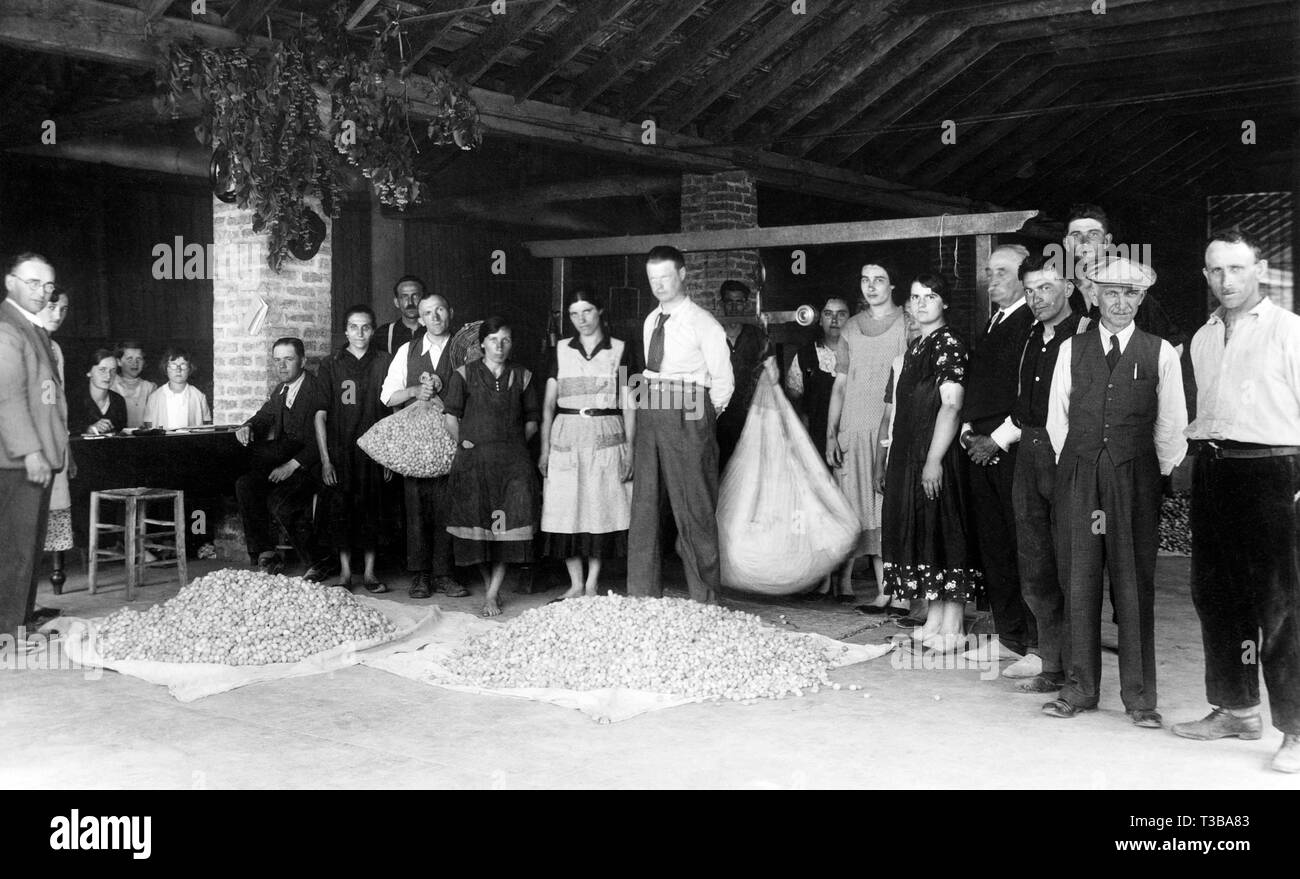 sericulture Stock Photohttps://www.alamy.com/image-license-details/?v=1https://www.alamy.com/sericulture-image243038659.html
sericulture Stock Photohttps://www.alamy.com/image-license-details/?v=1https://www.alamy.com/sericulture-image243038659.htmlRMT3BA83–sericulture
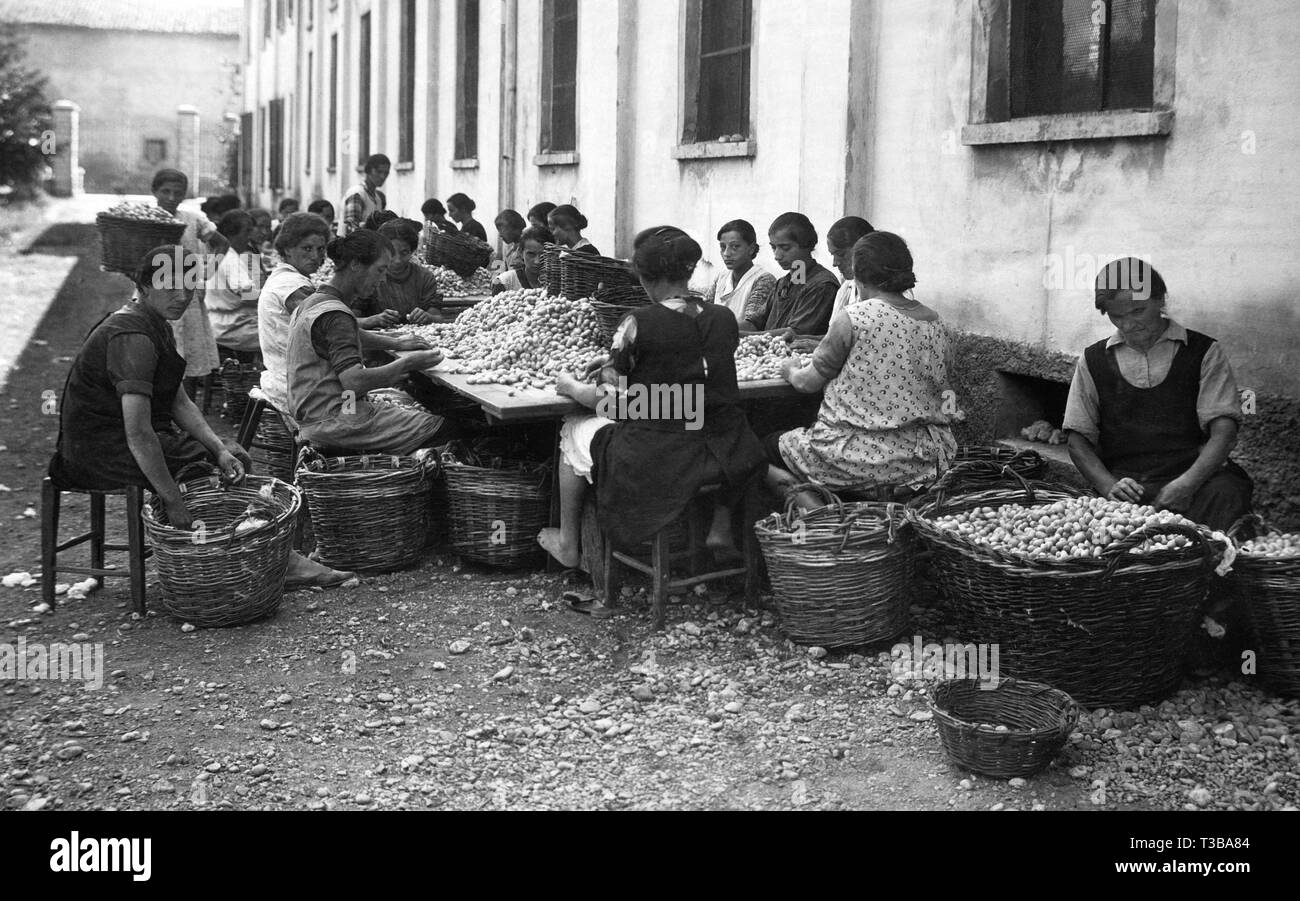 sericulture, 1939 Stock Photohttps://www.alamy.com/image-license-details/?v=1https://www.alamy.com/sericulture-1939-image243038660.html
sericulture, 1939 Stock Photohttps://www.alamy.com/image-license-details/?v=1https://www.alamy.com/sericulture-1939-image243038660.htmlRMT3BA84–sericulture, 1939
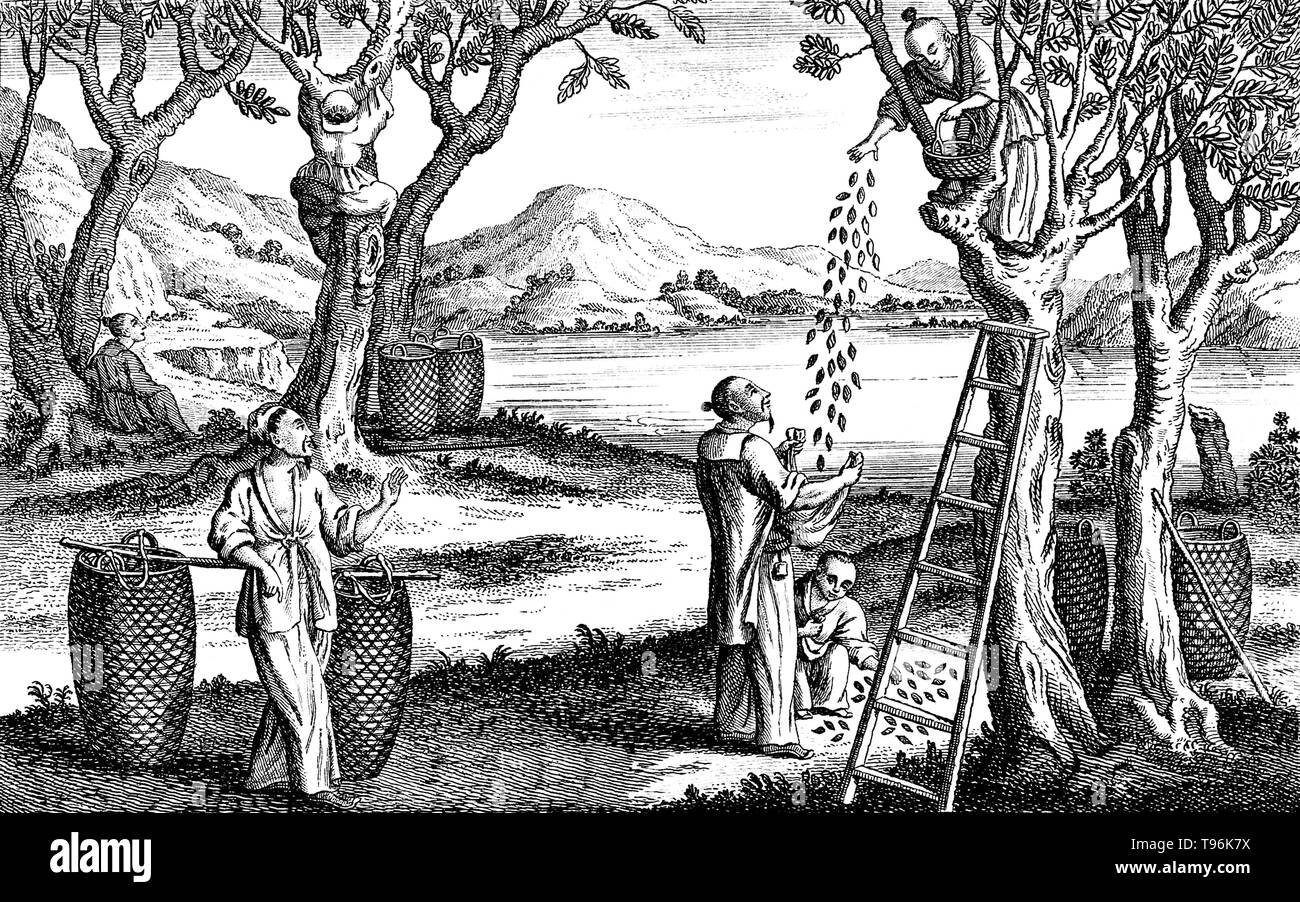 Textiles: silk manufacture in China, gathering mulberry leaves. The production of silk originates in China in prehistoric times. Silk remained confined to China until the Silk Road opened at some point during the later half of the first millennium BC. China maintained its virtual monopoly over silk production for another thousand years. Sericulture, or silk farming, is the cultivation of silkworms to produce silk. Stock Photohttps://www.alamy.com/image-license-details/?v=1https://www.alamy.com/textiles-silk-manufacture-in-china-gathering-mulberry-leaves-the-production-of-silk-originates-in-china-in-prehistoric-times-silk-remained-confined-to-china-until-the-silk-road-opened-at-some-point-during-the-later-half-of-the-first-millennium-bc-china-maintained-its-virtual-monopoly-over-silk-production-for-another-thousand-years-sericulture-or-silk-farming-is-the-cultivation-of-silkworms-to-produce-silk-image246623886.html
Textiles: silk manufacture in China, gathering mulberry leaves. The production of silk originates in China in prehistoric times. Silk remained confined to China until the Silk Road opened at some point during the later half of the first millennium BC. China maintained its virtual monopoly over silk production for another thousand years. Sericulture, or silk farming, is the cultivation of silkworms to produce silk. Stock Photohttps://www.alamy.com/image-license-details/?v=1https://www.alamy.com/textiles-silk-manufacture-in-china-gathering-mulberry-leaves-the-production-of-silk-originates-in-china-in-prehistoric-times-silk-remained-confined-to-china-until-the-silk-road-opened-at-some-point-during-the-later-half-of-the-first-millennium-bc-china-maintained-its-virtual-monopoly-over-silk-production-for-another-thousand-years-sericulture-or-silk-farming-is-the-cultivation-of-silkworms-to-produce-silk-image246623886.htmlRMT96K7X–Textiles: silk manufacture in China, gathering mulberry leaves. The production of silk originates in China in prehistoric times. Silk remained confined to China until the Silk Road opened at some point during the later half of the first millennium BC. China maintained its virtual monopoly over silk production for another thousand years. Sericulture, or silk farming, is the cultivation of silkworms to produce silk.
 italy, laveno, sericulture, 1900-1910 Stock Photohttps://www.alamy.com/image-license-details/?v=1https://www.alamy.com/italy-laveno-sericulture-1900-1910-image243038643.html
italy, laveno, sericulture, 1900-1910 Stock Photohttps://www.alamy.com/image-license-details/?v=1https://www.alamy.com/italy-laveno-sericulture-1900-1910-image243038643.htmlRMT3BA7F–italy, laveno, sericulture, 1900-1910
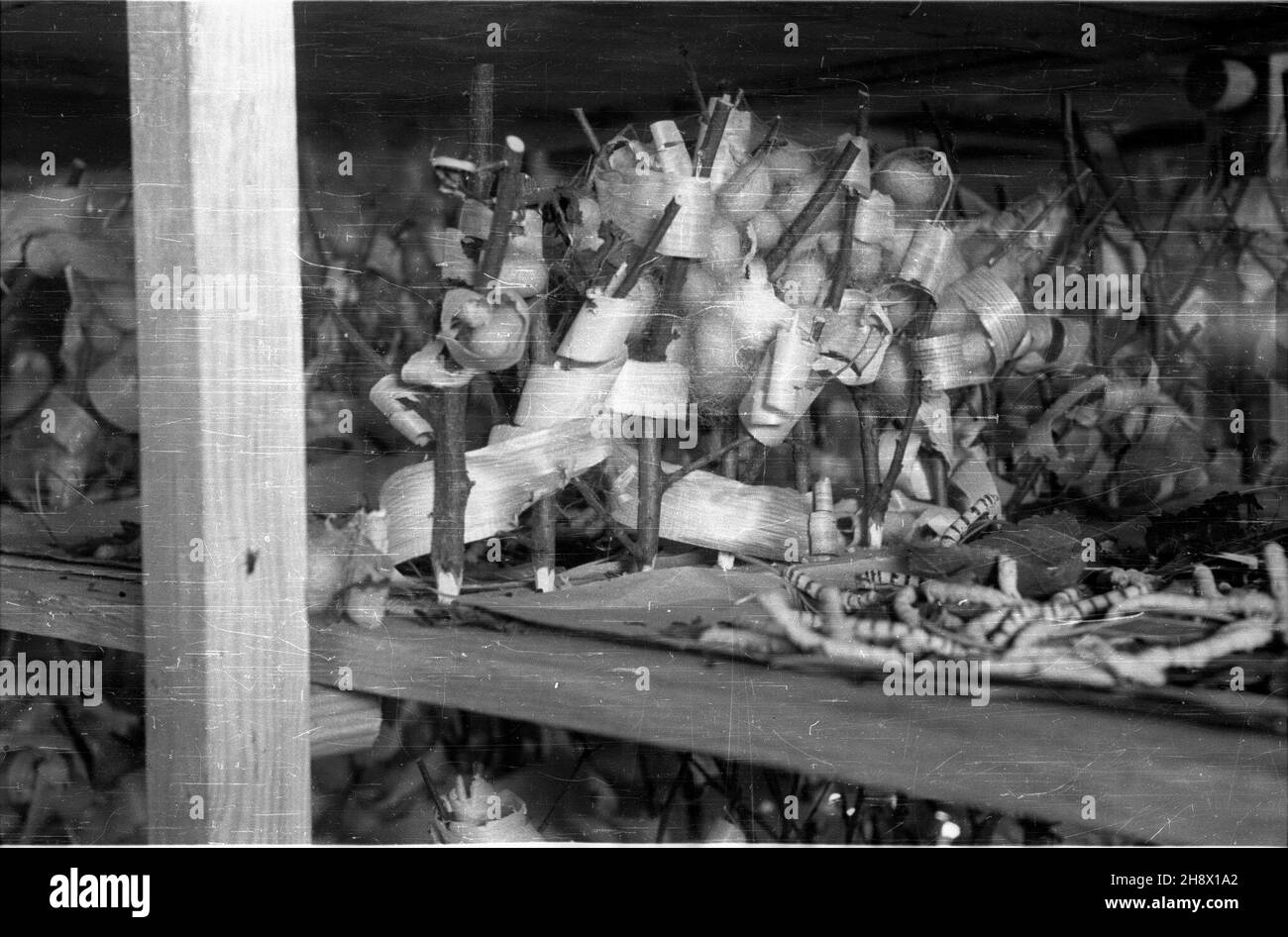 Milanówek, 1946. Centralna Doœwiadczalna Stacja Jedwabnicza. Zak³ad zajmowa³ siê hodowl¹ jedwabników i produkcj¹ tkanin. Za³o¿ony w 1924 r. przez Henryka i Stanis³awê Witaczków, po wojnie znacjonalizowany. Nz. hodowla jedwabników. gr PAP/Stanis³aw D¹browiecki Dok³adny miesi¹c i dzieñ wydarzenia nieustalone. Milanowek, 1946. Central Experimental Sericulture Station. The plant was involved in silkworm rearing and silk production. Established in 1924 by Henryk and Stanislawa Witczak, it was nationalised after the war. Pictured: the sericulture. gr PAP/Stanislaw Dabrowiecki Stock Photohttps://www.alamy.com/image-license-details/?v=1https://www.alamy.com/milanwek-1946-centralna-dowiadczalna-stacja-jedwabnicza-zakad-zajmowa-si-hodowl-jedwabnikw-i-produkcj-tkanin-zaoony-w-1924-r-przez-henryka-i-stanisaw-witaczkw-po-wojnie-znacjonalizowany-nz-hodowla-jedwabnikw-gr-papstanisaw-dbrowiecki-dokadny-miesic-i-dzie-wydarzenia-nieustalone-milanowek-1946-central-experimental-sericulture-station-the-plant-was-involved-in-silkworm-rearing-and-silk-production-established-in-1924-by-henryk-and-stanislawa-witczak-it-was-nationalised-after-the-war-pictured-the-sericulture-gr-papstanislaw-dabrowiecki-image452958634.html
Milanówek, 1946. Centralna Doœwiadczalna Stacja Jedwabnicza. Zak³ad zajmowa³ siê hodowl¹ jedwabników i produkcj¹ tkanin. Za³o¿ony w 1924 r. przez Henryka i Stanis³awê Witaczków, po wojnie znacjonalizowany. Nz. hodowla jedwabników. gr PAP/Stanis³aw D¹browiecki Dok³adny miesi¹c i dzieñ wydarzenia nieustalone. Milanowek, 1946. Central Experimental Sericulture Station. The plant was involved in silkworm rearing and silk production. Established in 1924 by Henryk and Stanislawa Witczak, it was nationalised after the war. Pictured: the sericulture. gr PAP/Stanislaw Dabrowiecki Stock Photohttps://www.alamy.com/image-license-details/?v=1https://www.alamy.com/milanwek-1946-centralna-dowiadczalna-stacja-jedwabnicza-zakad-zajmowa-si-hodowl-jedwabnikw-i-produkcj-tkanin-zaoony-w-1924-r-przez-henryka-i-stanisaw-witaczkw-po-wojnie-znacjonalizowany-nz-hodowla-jedwabnikw-gr-papstanisaw-dbrowiecki-dokadny-miesic-i-dzie-wydarzenia-nieustalone-milanowek-1946-central-experimental-sericulture-station-the-plant-was-involved-in-silkworm-rearing-and-silk-production-established-in-1924-by-henryk-and-stanislawa-witczak-it-was-nationalised-after-the-war-pictured-the-sericulture-gr-papstanislaw-dabrowiecki-image452958634.htmlRM2H8X1A2–Milanówek, 1946. Centralna Doœwiadczalna Stacja Jedwabnicza. Zak³ad zajmowa³ siê hodowl¹ jedwabników i produkcj¹ tkanin. Za³o¿ony w 1924 r. przez Henryka i Stanis³awê Witaczków, po wojnie znacjonalizowany. Nz. hodowla jedwabników. gr PAP/Stanis³aw D¹browiecki Dok³adny miesi¹c i dzieñ wydarzenia nieustalone. Milanowek, 1946. Central Experimental Sericulture Station. The plant was involved in silkworm rearing and silk production. Established in 1924 by Henryk and Stanislawa Witczak, it was nationalised after the war. Pictured: the sericulture. gr PAP/Stanislaw Dabrowiecki
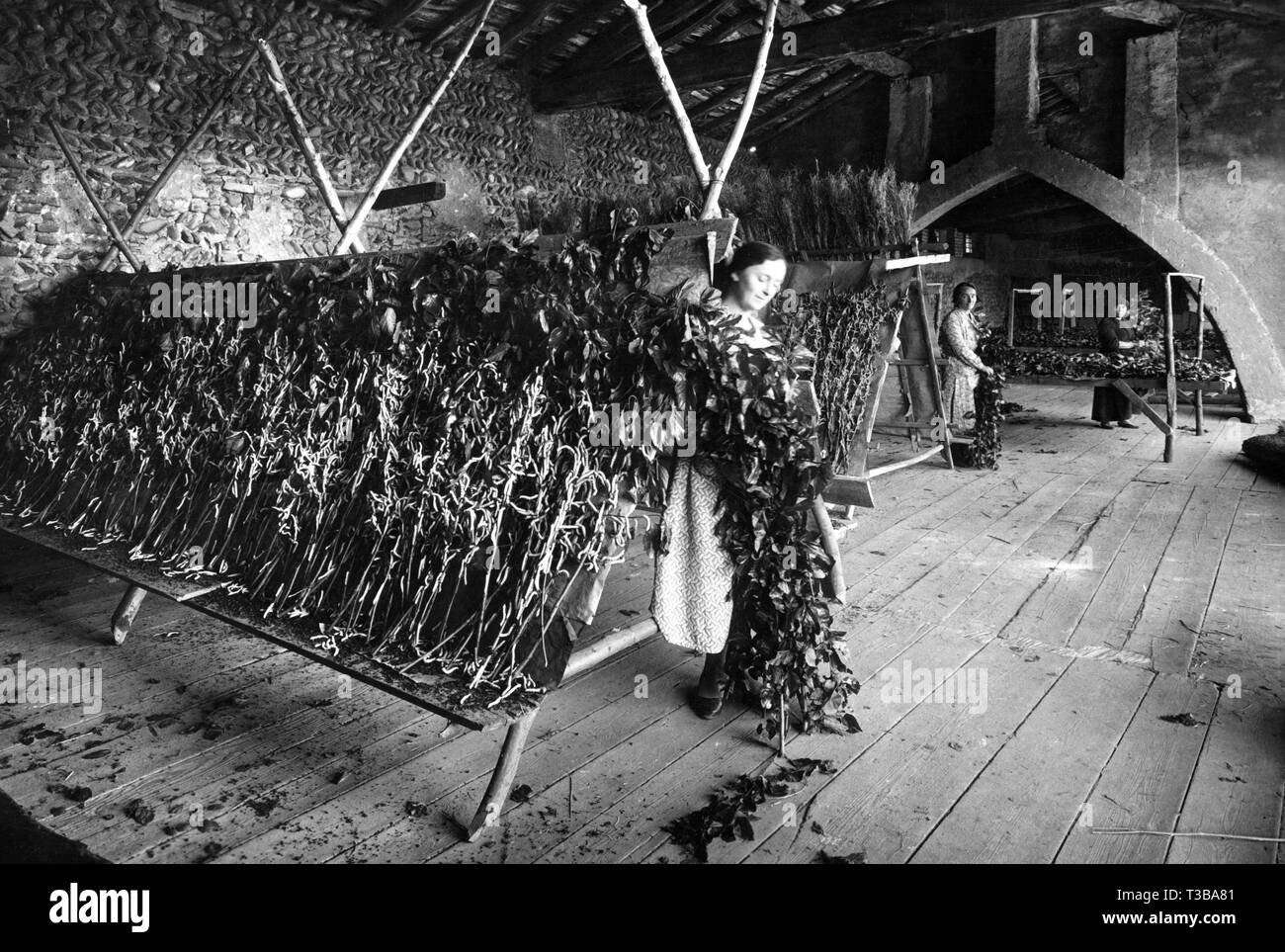 wood for silkworms Stock Photohttps://www.alamy.com/image-license-details/?v=1https://www.alamy.com/wood-for-silkworms-image243038657.html
wood for silkworms Stock Photohttps://www.alamy.com/image-license-details/?v=1https://www.alamy.com/wood-for-silkworms-image243038657.htmlRMT3BA81–wood for silkworms
![[ 1900s Japan - Women Working With Silk ] — Two women and a girl dressed in kimono and yukata work with silk in front of a home in Kanbara in Shizuoka Prefecture. The city was was the fifteenth of the fifty-three stations of the Tokaido highway. On March 31, 2006 Kanbara ceased to exist as it became part of Shimizu-ku of Shizuoka City. 20th century vintage glass slide Stock Photo [ 1900s Japan - Women Working With Silk ] — Two women and a girl dressed in kimono and yukata work with silk in front of a home in Kanbara in Shizuoka Prefecture. The city was was the fifteenth of the fifty-three stations of the Tokaido highway. On March 31, 2006 Kanbara ceased to exist as it became part of Shimizu-ku of Shizuoka City. 20th century vintage glass slide Stock Photo](https://c8.alamy.com/comp/PH0FD0/1900s-japan-women-working-with-silk-two-women-and-a-girl-dressed-in-kimono-and-yukata-work-with-silk-in-front-of-a-home-in-kanbara-in-shizuoka-prefecture-the-city-was-was-the-fifteenth-of-the-fifty-three-stations-of-the-tokaido-highway-on-march-31-2006-kanbara-ceased-to-exist-as-it-became-part-of-shimizu-ku-of-shizuoka-city-20th-century-vintage-glass-slide-PH0FD0.jpg) [ 1900s Japan - Women Working With Silk ] — Two women and a girl dressed in kimono and yukata work with silk in front of a home in Kanbara in Shizuoka Prefecture. The city was was the fifteenth of the fifty-three stations of the Tokaido highway. On March 31, 2006 Kanbara ceased to exist as it became part of Shimizu-ku of Shizuoka City. 20th century vintage glass slide Stock Photohttps://www.alamy.com/image-license-details/?v=1https://www.alamy.com/1900s-japan-women-working-with-silk-two-women-and-a-girl-dressed-in-kimono-and-yukata-work-with-silk-in-front-of-a-home-in-kanbara-in-shizuoka-prefecture-the-city-was-was-the-fifteenth-of-the-fifty-three-stations-of-the-tokaido-highway-on-march-31-2006-kanbara-ceased-to-exist-as-it-became-part-of-shimizu-ku-of-shizuoka-city-20th-century-vintage-glass-slide-image216985692.html
[ 1900s Japan - Women Working With Silk ] — Two women and a girl dressed in kimono and yukata work with silk in front of a home in Kanbara in Shizuoka Prefecture. The city was was the fifteenth of the fifty-three stations of the Tokaido highway. On March 31, 2006 Kanbara ceased to exist as it became part of Shimizu-ku of Shizuoka City. 20th century vintage glass slide Stock Photohttps://www.alamy.com/image-license-details/?v=1https://www.alamy.com/1900s-japan-women-working-with-silk-two-women-and-a-girl-dressed-in-kimono-and-yukata-work-with-silk-in-front-of-a-home-in-kanbara-in-shizuoka-prefecture-the-city-was-was-the-fifteenth-of-the-fifty-three-stations-of-the-tokaido-highway-on-march-31-2006-kanbara-ceased-to-exist-as-it-became-part-of-shimizu-ku-of-shizuoka-city-20th-century-vintage-glass-slide-image216985692.htmlRMPH0FD0–[ 1900s Japan - Women Working With Silk ] — Two women and a girl dressed in kimono and yukata work with silk in front of a home in Kanbara in Shizuoka Prefecture. The city was was the fifteenth of the fifty-three stations of the Tokaido highway. On March 31, 2006 Kanbara ceased to exist as it became part of Shimizu-ku of Shizuoka City. 20th century vintage glass slide
![[ c. 1900s Japan - Silk Factory ] — Drying room at the Kiryu Orimono KK (Kiryu Textile Company Ltd.), a Japanese silk factory in Kiryu, Gunma Prefecture. The company was launched as the Nihon Orimono KK (Japan Textile Company, Ltd.) in 1887 (Meiji 20). At the time it was Japan's largest and most modern silk factory where the complete production process was done by machinery. 20th century vintage glass slide. Stock Photo [ c. 1900s Japan - Silk Factory ] — Drying room at the Kiryu Orimono KK (Kiryu Textile Company Ltd.), a Japanese silk factory in Kiryu, Gunma Prefecture. The company was launched as the Nihon Orimono KK (Japan Textile Company, Ltd.) in 1887 (Meiji 20). At the time it was Japan's largest and most modern silk factory where the complete production process was done by machinery. 20th century vintage glass slide. Stock Photo](https://c8.alamy.com/comp/PGFHPG/c-1900s-japan-silk-factory-drying-room-at-the-kiryu-orimono-kk-kiryu-textile-company-ltd-a-japanese-silk-factory-in-kiryu-gunma-prefecture-the-company-was-launched-as-the-nihon-orimono-kk-japan-textile-company-ltd-in-1887-meiji-20-at-the-time-it-was-japans-largest-and-most-modern-silk-factory-where-the-complete-production-process-was-done-by-machinery-20th-century-vintage-glass-slide-PGFHPG.jpg) [ c. 1900s Japan - Silk Factory ] — Drying room at the Kiryu Orimono KK (Kiryu Textile Company Ltd.), a Japanese silk factory in Kiryu, Gunma Prefecture. The company was launched as the Nihon Orimono KK (Japan Textile Company, Ltd.) in 1887 (Meiji 20). At the time it was Japan's largest and most modern silk factory where the complete production process was done by machinery. 20th century vintage glass slide. Stock Photohttps://www.alamy.com/image-license-details/?v=1https://www.alamy.com/c-1900s-japan-silk-factory-drying-room-at-the-kiryu-orimono-kk-kiryu-textile-company-ltd-a-japanese-silk-factory-in-kiryu-gunma-prefecture-the-company-was-launched-as-the-nihon-orimono-kk-japan-textile-company-ltd-in-1887-meiji-20-at-the-time-it-was-japans-largest-and-most-modern-silk-factory-where-the-complete-production-process-was-done-by-machinery-20th-century-vintage-glass-slide-image216702152.html
[ c. 1900s Japan - Silk Factory ] — Drying room at the Kiryu Orimono KK (Kiryu Textile Company Ltd.), a Japanese silk factory in Kiryu, Gunma Prefecture. The company was launched as the Nihon Orimono KK (Japan Textile Company, Ltd.) in 1887 (Meiji 20). At the time it was Japan's largest and most modern silk factory where the complete production process was done by machinery. 20th century vintage glass slide. Stock Photohttps://www.alamy.com/image-license-details/?v=1https://www.alamy.com/c-1900s-japan-silk-factory-drying-room-at-the-kiryu-orimono-kk-kiryu-textile-company-ltd-a-japanese-silk-factory-in-kiryu-gunma-prefecture-the-company-was-launched-as-the-nihon-orimono-kk-japan-textile-company-ltd-in-1887-meiji-20-at-the-time-it-was-japans-largest-and-most-modern-silk-factory-where-the-complete-production-process-was-done-by-machinery-20th-century-vintage-glass-slide-image216702152.htmlRMPGFHPG–[ c. 1900s Japan - Silk Factory ] — Drying room at the Kiryu Orimono KK (Kiryu Textile Company Ltd.), a Japanese silk factory in Kiryu, Gunma Prefecture. The company was launched as the Nihon Orimono KK (Japan Textile Company, Ltd.) in 1887 (Meiji 20). At the time it was Japan's largest and most modern silk factory where the complete production process was done by machinery. 20th century vintage glass slide.
 Sericulture Production Business Vector Seamless Pattern Stock Vectorhttps://www.alamy.com/image-license-details/?v=1https://www.alamy.com/sericulture-production-business-vector-seamless-pattern-image464765395.html
Sericulture Production Business Vector Seamless Pattern Stock Vectorhttps://www.alamy.com/image-license-details/?v=1https://www.alamy.com/sericulture-production-business-vector-seamless-pattern-image464765395.htmlRF2J03W03–Sericulture Production Business Vector Seamless Pattern
 Worm at the end of the fifth age, vintage engraved illustration. Magasin Pittoresque 1845. Stock Photohttps://www.alamy.com/image-license-details/?v=1https://www.alamy.com/worm-at-the-end-of-the-fifth-age-vintage-engraved-illustration-magasin-pittoresque-1845-image363145757.html
Worm at the end of the fifth age, vintage engraved illustration. Magasin Pittoresque 1845. Stock Photohttps://www.alamy.com/image-license-details/?v=1https://www.alamy.com/worm-at-the-end-of-the-fifth-age-vintage-engraved-illustration-magasin-pittoresque-1845-image363145757.htmlRF2C2PM39–Worm at the end of the fifth age, vintage engraved illustration. Magasin Pittoresque 1845.
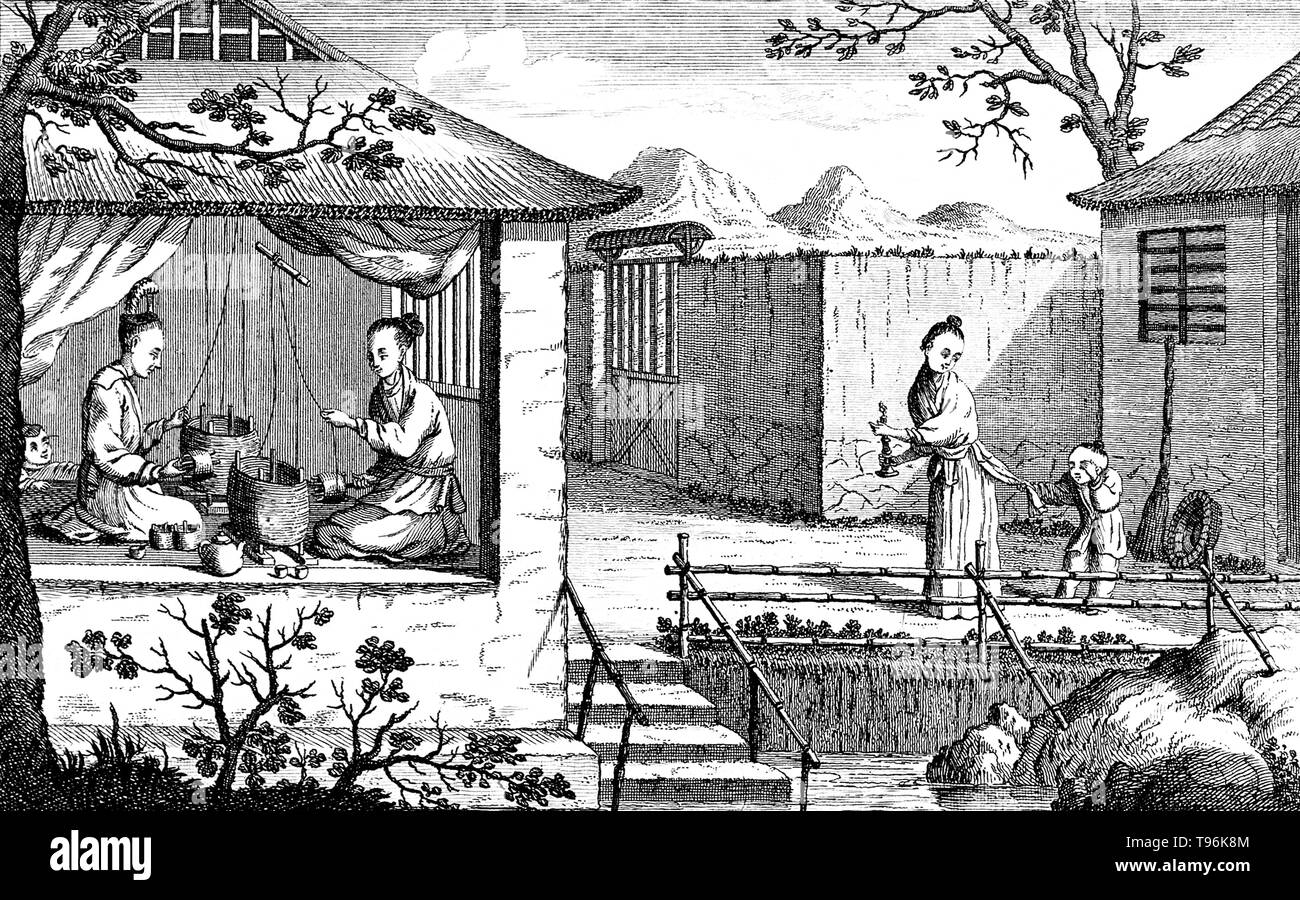 Textiles: silk manufacture in China, spinning the threads. The Chinese art of twisting silk threads. The production of silk originates in China in prehistoric times. Silk remained confined to China until the Silk Road opened at some point during the later half of the first millennium BC. China maintained its virtual monopoly over silk production for another thousand years. Sericulture, or silk farming, is the cultivation of silkworms to produce silk. Stock Photohttps://www.alamy.com/image-license-details/?v=1https://www.alamy.com/textiles-silk-manufacture-in-china-spinning-the-threads-the-chinese-art-of-twisting-silk-threads-the-production-of-silk-originates-in-china-in-prehistoric-times-silk-remained-confined-to-china-until-the-silk-road-opened-at-some-point-during-the-later-half-of-the-first-millennium-bc-china-maintained-its-virtual-monopoly-over-silk-production-for-another-thousand-years-sericulture-or-silk-farming-is-the-cultivation-of-silkworms-to-produce-silk-image246623908.html
Textiles: silk manufacture in China, spinning the threads. The Chinese art of twisting silk threads. The production of silk originates in China in prehistoric times. Silk remained confined to China until the Silk Road opened at some point during the later half of the first millennium BC. China maintained its virtual monopoly over silk production for another thousand years. Sericulture, or silk farming, is the cultivation of silkworms to produce silk. Stock Photohttps://www.alamy.com/image-license-details/?v=1https://www.alamy.com/textiles-silk-manufacture-in-china-spinning-the-threads-the-chinese-art-of-twisting-silk-threads-the-production-of-silk-originates-in-china-in-prehistoric-times-silk-remained-confined-to-china-until-the-silk-road-opened-at-some-point-during-the-later-half-of-the-first-millennium-bc-china-maintained-its-virtual-monopoly-over-silk-production-for-another-thousand-years-sericulture-or-silk-farming-is-the-cultivation-of-silkworms-to-produce-silk-image246623908.htmlRMT96K8M–Textiles: silk manufacture in China, spinning the threads. The Chinese art of twisting silk threads. The production of silk originates in China in prehistoric times. Silk remained confined to China until the Silk Road opened at some point during the later half of the first millennium BC. China maintained its virtual monopoly over silk production for another thousand years. Sericulture, or silk farming, is the cultivation of silkworms to produce silk.
 Milanówek, 1946. Centralna Doœwiadczalna Stacja Jedwabnicza. Zak³ad zajmowa³ siê hodowl¹ jedwabników i produkcj¹ tkanin. Za³o¿ony w 1924 r. przez Henryka i Stanis³awê Witaczków, po wojnie znacjonalizowany.Nz. farbowanie jedwabiu naturalnego. gr PAP/Stanis³aw D¹browiecki Dok³adny miesi¹c i dzieñ wydarzenia nieustalone. Milanowek, 1946. Central Experimental Sericulture Station. The plant was involved in silkworm rearing and silk production. Established in 1924 by Henryk and Stanislawa Witczak, it was nationalised after the war. Pictured: the dyeing of natural silk. gr PAP/Stanislaw Da Stock Photohttps://www.alamy.com/image-license-details/?v=1https://www.alamy.com/milanwek-1946-centralna-dowiadczalna-stacja-jedwabnicza-zakad-zajmowa-si-hodowl-jedwabnikw-i-produkcj-tkanin-zaoony-w-1924-r-przez-henryka-i-stanisaw-witaczkw-po-wojnie-znacjonalizowanynz-farbowanie-jedwabiu-naturalnego-gr-papstanisaw-dbrowiecki-dokadny-miesic-i-dzie-wydarzenia-nieustalone-milanowek-1946-central-experimental-sericulture-station-the-plant-was-involved-in-silkworm-rearing-and-silk-production-established-in-1924-by-henryk-and-stanislawa-witczak-it-was-nationalised-after-the-war-pictured-the-dyeing-of-natural-silk-gr-papstanislaw-da-image452967114.html
Milanówek, 1946. Centralna Doœwiadczalna Stacja Jedwabnicza. Zak³ad zajmowa³ siê hodowl¹ jedwabników i produkcj¹ tkanin. Za³o¿ony w 1924 r. przez Henryka i Stanis³awê Witaczków, po wojnie znacjonalizowany.Nz. farbowanie jedwabiu naturalnego. gr PAP/Stanis³aw D¹browiecki Dok³adny miesi¹c i dzieñ wydarzenia nieustalone. Milanowek, 1946. Central Experimental Sericulture Station. The plant was involved in silkworm rearing and silk production. Established in 1924 by Henryk and Stanislawa Witczak, it was nationalised after the war. Pictured: the dyeing of natural silk. gr PAP/Stanislaw Da Stock Photohttps://www.alamy.com/image-license-details/?v=1https://www.alamy.com/milanwek-1946-centralna-dowiadczalna-stacja-jedwabnicza-zakad-zajmowa-si-hodowl-jedwabnikw-i-produkcj-tkanin-zaoony-w-1924-r-przez-henryka-i-stanisaw-witaczkw-po-wojnie-znacjonalizowanynz-farbowanie-jedwabiu-naturalnego-gr-papstanisaw-dbrowiecki-dokadny-miesic-i-dzie-wydarzenia-nieustalone-milanowek-1946-central-experimental-sericulture-station-the-plant-was-involved-in-silkworm-rearing-and-silk-production-established-in-1924-by-henryk-and-stanislawa-witczak-it-was-nationalised-after-the-war-pictured-the-dyeing-of-natural-silk-gr-papstanislaw-da-image452967114.htmlRM2H8XC4X–Milanówek, 1946. Centralna Doœwiadczalna Stacja Jedwabnicza. Zak³ad zajmowa³ siê hodowl¹ jedwabników i produkcj¹ tkanin. Za³o¿ony w 1924 r. przez Henryka i Stanis³awê Witaczków, po wojnie znacjonalizowany.Nz. farbowanie jedwabiu naturalnego. gr PAP/Stanis³aw D¹browiecki Dok³adny miesi¹c i dzieñ wydarzenia nieustalone. Milanowek, 1946. Central Experimental Sericulture Station. The plant was involved in silkworm rearing and silk production. Established in 1924 by Henryk and Stanislawa Witczak, it was nationalised after the war. Pictured: the dyeing of natural silk. gr PAP/Stanislaw Da
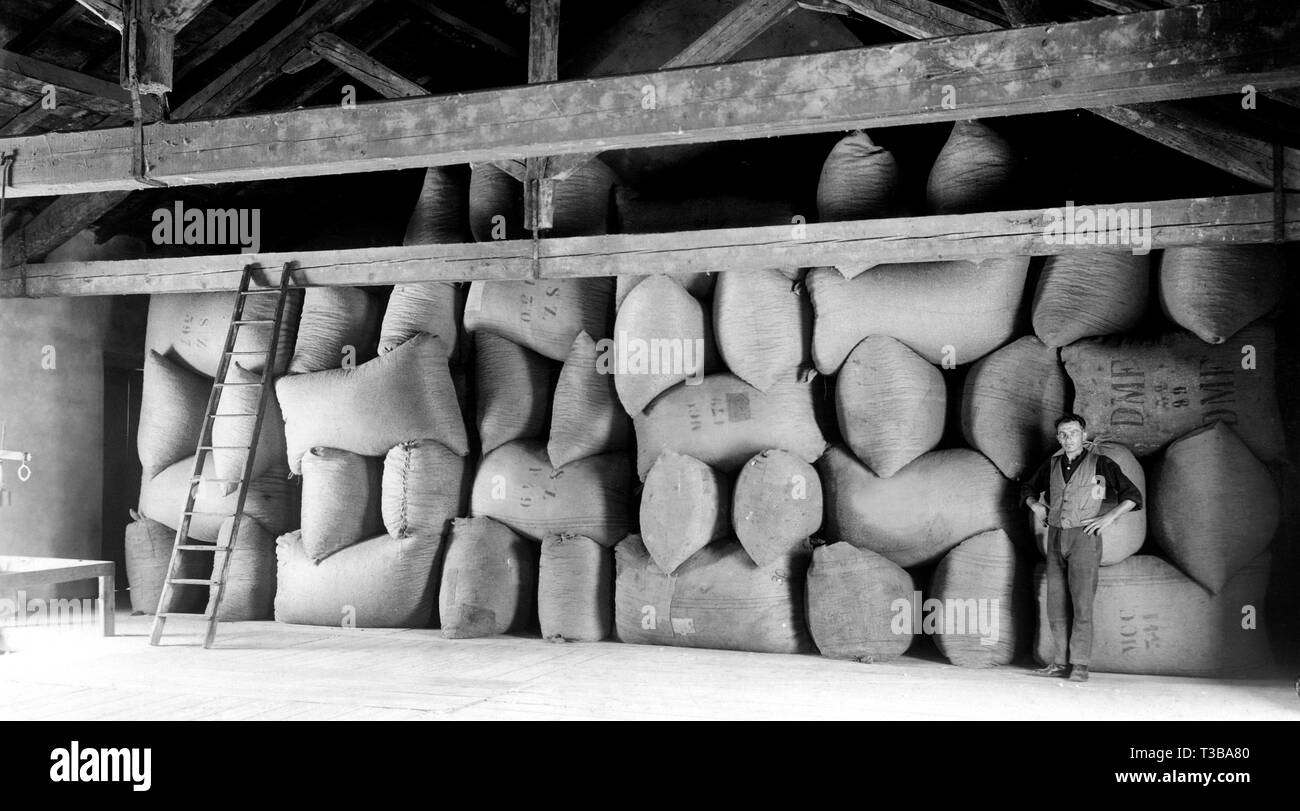 sacks of silkworms Stock Photohttps://www.alamy.com/image-license-details/?v=1https://www.alamy.com/sacks-of-silkworms-image243038656.html
sacks of silkworms Stock Photohttps://www.alamy.com/image-license-details/?v=1https://www.alamy.com/sacks-of-silkworms-image243038656.htmlRMT3BA80–sacks of silkworms
![[ c. 1900s Japan - Silk Factory ] — Boiling cocoons and reeling silk at a silk factory in Maebashi, Gunma Prefecture. 20th century vintage glass slide. Stock Photo [ c. 1900s Japan - Silk Factory ] — Boiling cocoons and reeling silk at a silk factory in Maebashi, Gunma Prefecture. 20th century vintage glass slide. Stock Photo](https://c8.alamy.com/comp/PGFHP0/c-1900s-japan-silk-factory-boiling-cocoons-and-reeling-silk-at-a-silk-factory-in-maebashi-gunma-prefecture-20th-century-vintage-glass-slide-PGFHP0.jpg) [ c. 1900s Japan - Silk Factory ] — Boiling cocoons and reeling silk at a silk factory in Maebashi, Gunma Prefecture. 20th century vintage glass slide. Stock Photohttps://www.alamy.com/image-license-details/?v=1https://www.alamy.com/c-1900s-japan-silk-factory-boiling-cocoons-and-reeling-silk-at-a-silk-factory-in-maebashi-gunma-prefecture-20th-century-vintage-glass-slide-image216702136.html
[ c. 1900s Japan - Silk Factory ] — Boiling cocoons and reeling silk at a silk factory in Maebashi, Gunma Prefecture. 20th century vintage glass slide. Stock Photohttps://www.alamy.com/image-license-details/?v=1https://www.alamy.com/c-1900s-japan-silk-factory-boiling-cocoons-and-reeling-silk-at-a-silk-factory-in-maebashi-gunma-prefecture-20th-century-vintage-glass-slide-image216702136.htmlRMPGFHP0–[ c. 1900s Japan - Silk Factory ] — Boiling cocoons and reeling silk at a silk factory in Maebashi, Gunma Prefecture. 20th century vintage glass slide.
RF2HCF91R–Sericulture Production Business Icons Set Vector
 Textiles: silk manufacture in China, gathering the silk threads. The Chinese method of winding the silk off the bags in warm water. The production of silk originates in China in prehistoric times. Silk remained confined to China until the Silk Road opened at some point during the later half of the first millennium BC. China maintained its virtual monopoly over silk production for another thousand years. Sericulture, or silk farming, is the cultivation of silkworms to produce silk. Stock Photohttps://www.alamy.com/image-license-details/?v=1https://www.alamy.com/textiles-silk-manufacture-in-china-gathering-the-silk-threads-the-chinese-method-of-winding-the-silk-off-the-bags-in-warm-water-the-production-of-silk-originates-in-china-in-prehistoric-times-silk-remained-confined-to-china-until-the-silk-road-opened-at-some-point-during-the-later-half-of-the-first-millennium-bc-china-maintained-its-virtual-monopoly-over-silk-production-for-another-thousand-years-sericulture-or-silk-farming-is-the-cultivation-of-silkworms-to-produce-silk-image246623894.html
Textiles: silk manufacture in China, gathering the silk threads. The Chinese method of winding the silk off the bags in warm water. The production of silk originates in China in prehistoric times. Silk remained confined to China until the Silk Road opened at some point during the later half of the first millennium BC. China maintained its virtual monopoly over silk production for another thousand years. Sericulture, or silk farming, is the cultivation of silkworms to produce silk. Stock Photohttps://www.alamy.com/image-license-details/?v=1https://www.alamy.com/textiles-silk-manufacture-in-china-gathering-the-silk-threads-the-chinese-method-of-winding-the-silk-off-the-bags-in-warm-water-the-production-of-silk-originates-in-china-in-prehistoric-times-silk-remained-confined-to-china-until-the-silk-road-opened-at-some-point-during-the-later-half-of-the-first-millennium-bc-china-maintained-its-virtual-monopoly-over-silk-production-for-another-thousand-years-sericulture-or-silk-farming-is-the-cultivation-of-silkworms-to-produce-silk-image246623894.htmlRMT96K86–Textiles: silk manufacture in China, gathering the silk threads. The Chinese method of winding the silk off the bags in warm water. The production of silk originates in China in prehistoric times. Silk remained confined to China until the Silk Road opened at some point during the later half of the first millennium BC. China maintained its virtual monopoly over silk production for another thousand years. Sericulture, or silk farming, is the cultivation of silkworms to produce silk.
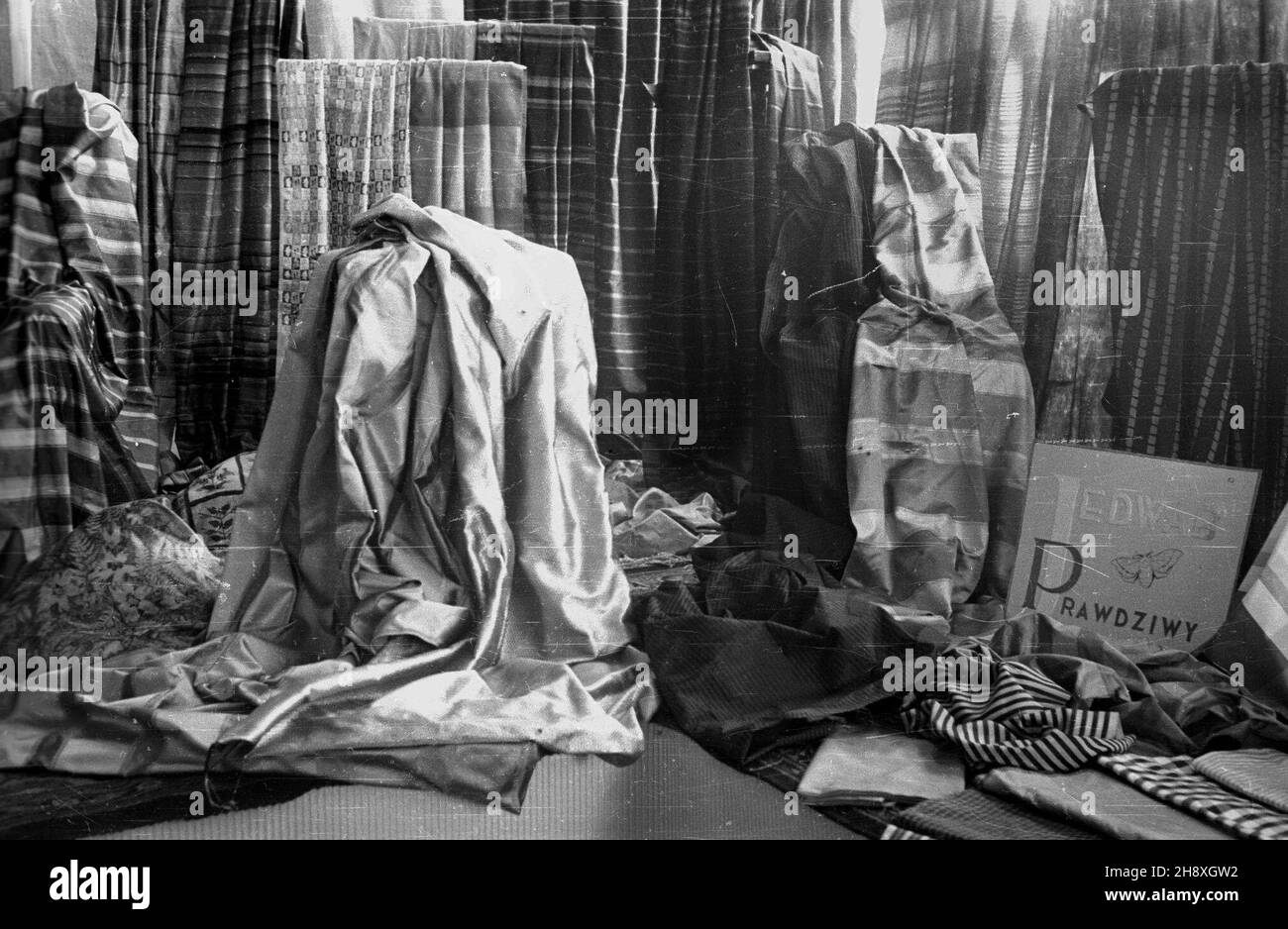 Milanówek, 1946. Centralna Doœwiadczalna Stacja Jedwabnicza. Zak³ad zajmowa³ siê hodowl¹ jedwabników i produkcj¹ tkanin. Za³o¿ony w 1924 r. przez Henryka i Stanis³awê Witaczków, po wojnie znacjonalizowany.Nz. wystawa artyku³ów z jedwabiu prawdziwego. gr PAP/Stanis³aw D¹browiecki Dok³adny miesi¹c i dzieñ wydarzenia nieustalone. Milanowek, 1946. Central Experimental Sericulture Station. The plant was engaged in silkworm breeding and silk production. Established in 1924 by Henryk and Stanislawa Witczak, it was nationalised after the war. Pictured: a silk product display. gr PAP/Stanisl Stock Photohttps://www.alamy.com/image-license-details/?v=1https://www.alamy.com/milanwek-1946-centralna-dowiadczalna-stacja-jedwabnicza-zakad-zajmowa-si-hodowl-jedwabnikw-i-produkcj-tkanin-zaoony-w-1924-r-przez-henryka-i-stanisaw-witaczkw-po-wojnie-znacjonalizowanynz-wystawa-artykuw-z-jedwabiu-prawdziwego-gr-papstanisaw-dbrowiecki-dokadny-miesic-i-dzie-wydarzenia-nieustalone-milanowek-1946-central-experimental-sericulture-station-the-plant-was-engaged-in-silkworm-breeding-and-silk-production-established-in-1924-by-henryk-and-stanislawa-witczak-it-was-nationalised-after-the-war-pictured-a-silk-product-display-gr-papstanisl-image452970814.html
Milanówek, 1946. Centralna Doœwiadczalna Stacja Jedwabnicza. Zak³ad zajmowa³ siê hodowl¹ jedwabników i produkcj¹ tkanin. Za³o¿ony w 1924 r. przez Henryka i Stanis³awê Witaczków, po wojnie znacjonalizowany.Nz. wystawa artyku³ów z jedwabiu prawdziwego. gr PAP/Stanis³aw D¹browiecki Dok³adny miesi¹c i dzieñ wydarzenia nieustalone. Milanowek, 1946. Central Experimental Sericulture Station. The plant was engaged in silkworm breeding and silk production. Established in 1924 by Henryk and Stanislawa Witczak, it was nationalised after the war. Pictured: a silk product display. gr PAP/Stanisl Stock Photohttps://www.alamy.com/image-license-details/?v=1https://www.alamy.com/milanwek-1946-centralna-dowiadczalna-stacja-jedwabnicza-zakad-zajmowa-si-hodowl-jedwabnikw-i-produkcj-tkanin-zaoony-w-1924-r-przez-henryka-i-stanisaw-witaczkw-po-wojnie-znacjonalizowanynz-wystawa-artykuw-z-jedwabiu-prawdziwego-gr-papstanisaw-dbrowiecki-dokadny-miesic-i-dzie-wydarzenia-nieustalone-milanowek-1946-central-experimental-sericulture-station-the-plant-was-engaged-in-silkworm-breeding-and-silk-production-established-in-1924-by-henryk-and-stanislawa-witczak-it-was-nationalised-after-the-war-pictured-a-silk-product-display-gr-papstanisl-image452970814.htmlRM2H8XGW2–Milanówek, 1946. Centralna Doœwiadczalna Stacja Jedwabnicza. Zak³ad zajmowa³ siê hodowl¹ jedwabników i produkcj¹ tkanin. Za³o¿ony w 1924 r. przez Henryka i Stanis³awê Witaczków, po wojnie znacjonalizowany.Nz. wystawa artyku³ów z jedwabiu prawdziwego. gr PAP/Stanis³aw D¹browiecki Dok³adny miesi¹c i dzieñ wydarzenia nieustalone. Milanowek, 1946. Central Experimental Sericulture Station. The plant was engaged in silkworm breeding and silk production. Established in 1924 by Henryk and Stanislawa Witczak, it was nationalised after the war. Pictured: a silk product display. gr PAP/Stanisl
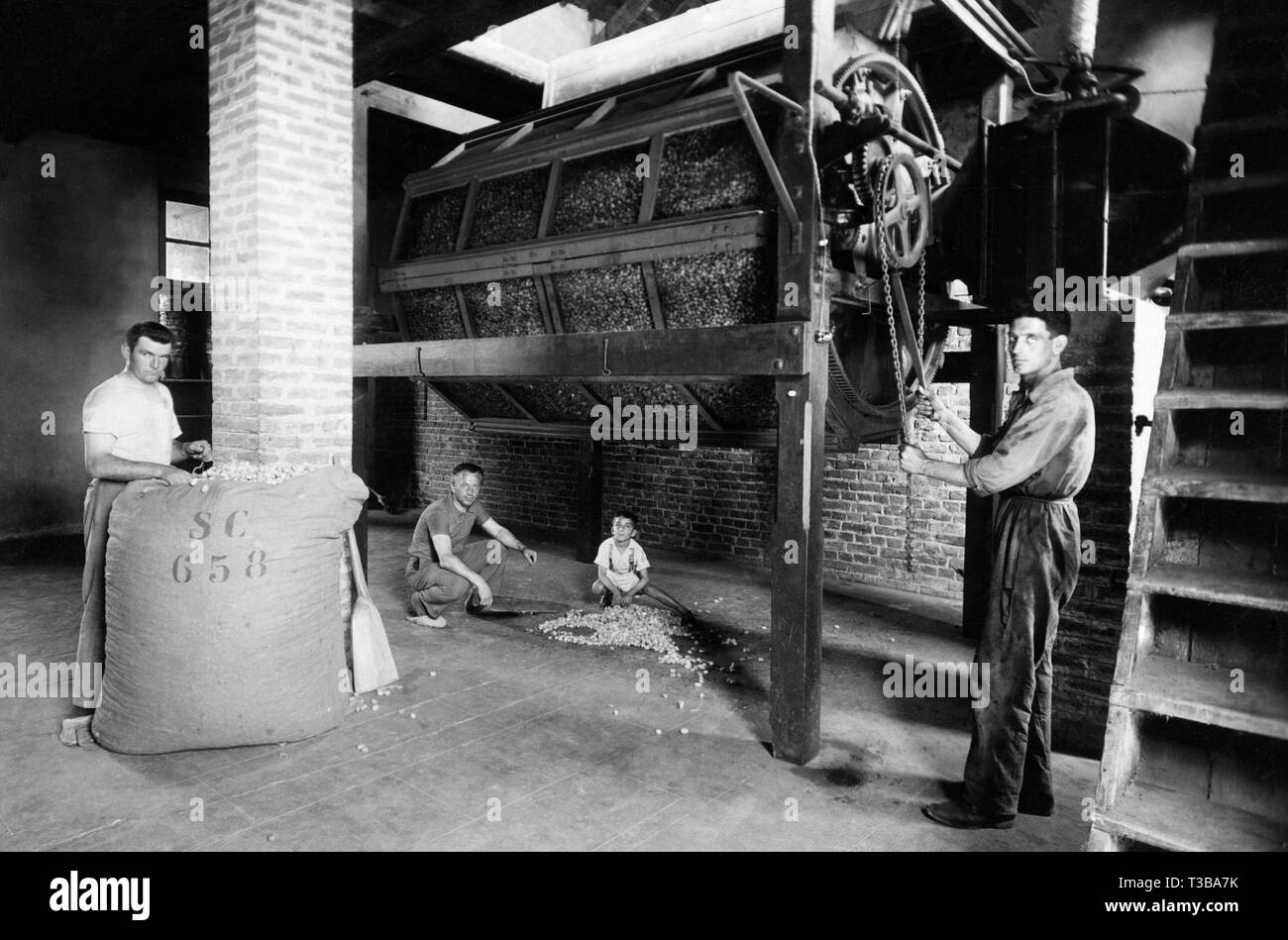 silkworms Stock Photohttps://www.alamy.com/image-license-details/?v=1https://www.alamy.com/silkworms-image243038647.html
silkworms Stock Photohttps://www.alamy.com/image-license-details/?v=1https://www.alamy.com/silkworms-image243038647.htmlRMT3BA7K–silkworms
 Sericulture, 1955 Stock Photohttps://www.alamy.com/image-license-details/?v=1https://www.alamy.com/sericulture-1955-image243051758.html
Sericulture, 1955 Stock Photohttps://www.alamy.com/image-license-details/?v=1https://www.alamy.com/sericulture-1955-image243051758.htmlRMT3BXYX–Sericulture, 1955
![[ c. 1900s Japan - Silk Factory ] — Reeling silk at a silk factory in Maebashi, Gunma Prefecture. 20th century vintage glass slide. Stock Photo [ c. 1900s Japan - Silk Factory ] — Reeling silk at a silk factory in Maebashi, Gunma Prefecture. 20th century vintage glass slide. Stock Photo](https://c8.alamy.com/comp/PGFHP8/c-1900s-japan-silk-factory-reeling-silk-at-a-silk-factory-in-maebashi-gunma-prefecture-20th-century-vintage-glass-slide-PGFHP8.jpg) [ c. 1900s Japan - Silk Factory ] — Reeling silk at a silk factory in Maebashi, Gunma Prefecture. 20th century vintage glass slide. Stock Photohttps://www.alamy.com/image-license-details/?v=1https://www.alamy.com/c-1900s-japan-silk-factory-reeling-silk-at-a-silk-factory-in-maebashi-gunma-prefecture-20th-century-vintage-glass-slide-image216702144.html
[ c. 1900s Japan - Silk Factory ] — Reeling silk at a silk factory in Maebashi, Gunma Prefecture. 20th century vintage glass slide. Stock Photohttps://www.alamy.com/image-license-details/?v=1https://www.alamy.com/c-1900s-japan-silk-factory-reeling-silk-at-a-silk-factory-in-maebashi-gunma-prefecture-20th-century-vintage-glass-slide-image216702144.htmlRMPGFHP8–[ c. 1900s Japan - Silk Factory ] — Reeling silk at a silk factory in Maebashi, Gunma Prefecture. 20th century vintage glass slide.
RF2HPA89W–Sericulture Production Business Icons Set Vector .
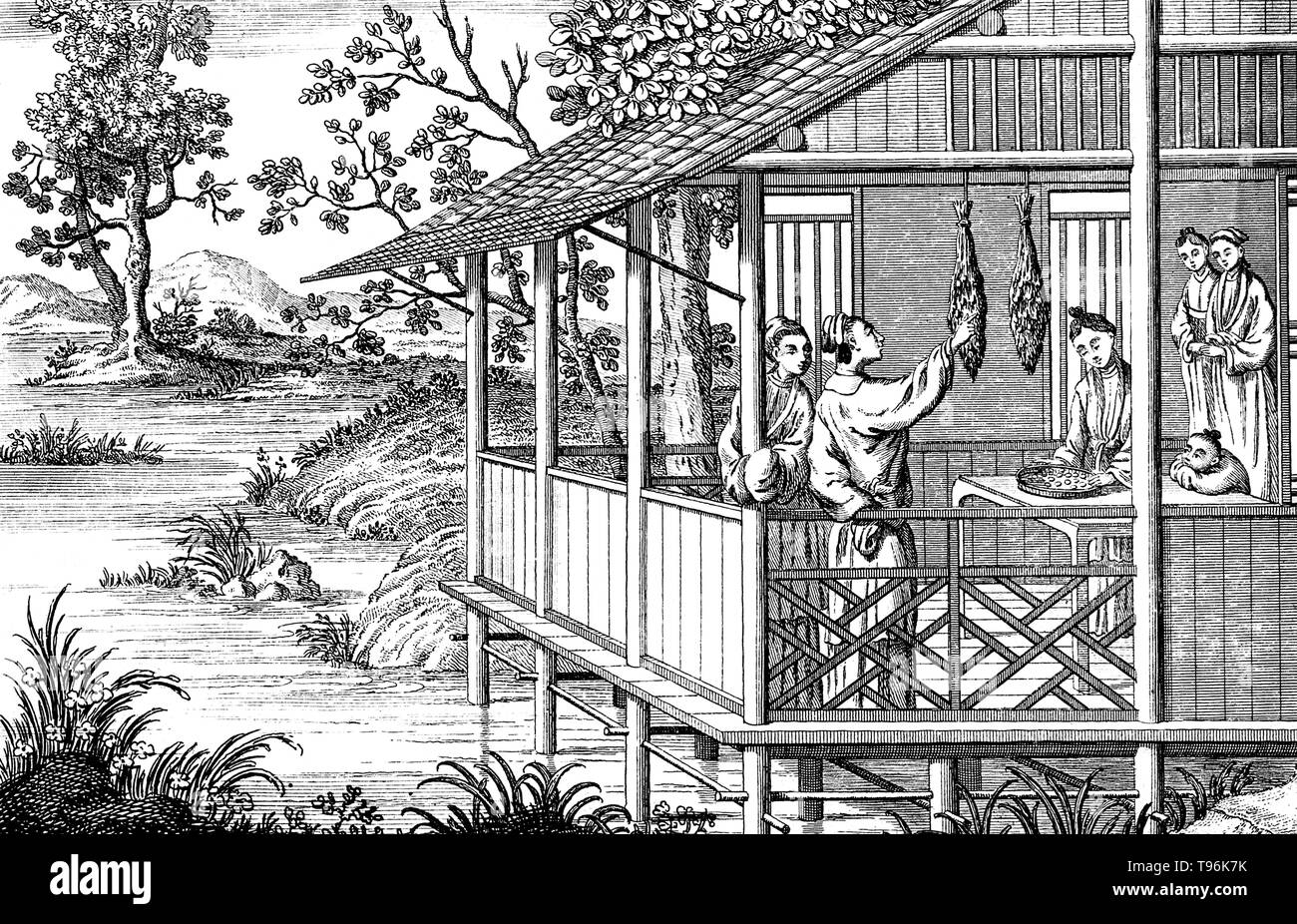 Textiles: silk manufacture in China, gathering the empty silk cocoons. The Chinese method of taking the silk worm bags from the whisk. The production of silk originates in China in prehistoric times. Silk remained confined to China until the Silk Road opened at some point during the later half of the first millennium BC. China maintained its virtual monopoly over silk production for another thousand years. Sericulture, or silk farming, is the cultivation of silkworms to produce silk. Stock Photohttps://www.alamy.com/image-license-details/?v=1https://www.alamy.com/textiles-silk-manufacture-in-china-gathering-the-empty-silk-cocoons-the-chinese-method-of-taking-the-silk-worm-bags-from-the-whisk-the-production-of-silk-originates-in-china-in-prehistoric-times-silk-remained-confined-to-china-until-the-silk-road-opened-at-some-point-during-the-later-half-of-the-first-millennium-bc-china-maintained-its-virtual-monopoly-over-silk-production-for-another-thousand-years-sericulture-or-silk-farming-is-the-cultivation-of-silkworms-to-produce-silk-image246623879.html
Textiles: silk manufacture in China, gathering the empty silk cocoons. The Chinese method of taking the silk worm bags from the whisk. The production of silk originates in China in prehistoric times. Silk remained confined to China until the Silk Road opened at some point during the later half of the first millennium BC. China maintained its virtual monopoly over silk production for another thousand years. Sericulture, or silk farming, is the cultivation of silkworms to produce silk. Stock Photohttps://www.alamy.com/image-license-details/?v=1https://www.alamy.com/textiles-silk-manufacture-in-china-gathering-the-empty-silk-cocoons-the-chinese-method-of-taking-the-silk-worm-bags-from-the-whisk-the-production-of-silk-originates-in-china-in-prehistoric-times-silk-remained-confined-to-china-until-the-silk-road-opened-at-some-point-during-the-later-half-of-the-first-millennium-bc-china-maintained-its-virtual-monopoly-over-silk-production-for-another-thousand-years-sericulture-or-silk-farming-is-the-cultivation-of-silkworms-to-produce-silk-image246623879.htmlRMT96K7K–Textiles: silk manufacture in China, gathering the empty silk cocoons. The Chinese method of taking the silk worm bags from the whisk. The production of silk originates in China in prehistoric times. Silk remained confined to China until the Silk Road opened at some point during the later half of the first millennium BC. China maintained its virtual monopoly over silk production for another thousand years. Sericulture, or silk farming, is the cultivation of silkworms to produce silk.
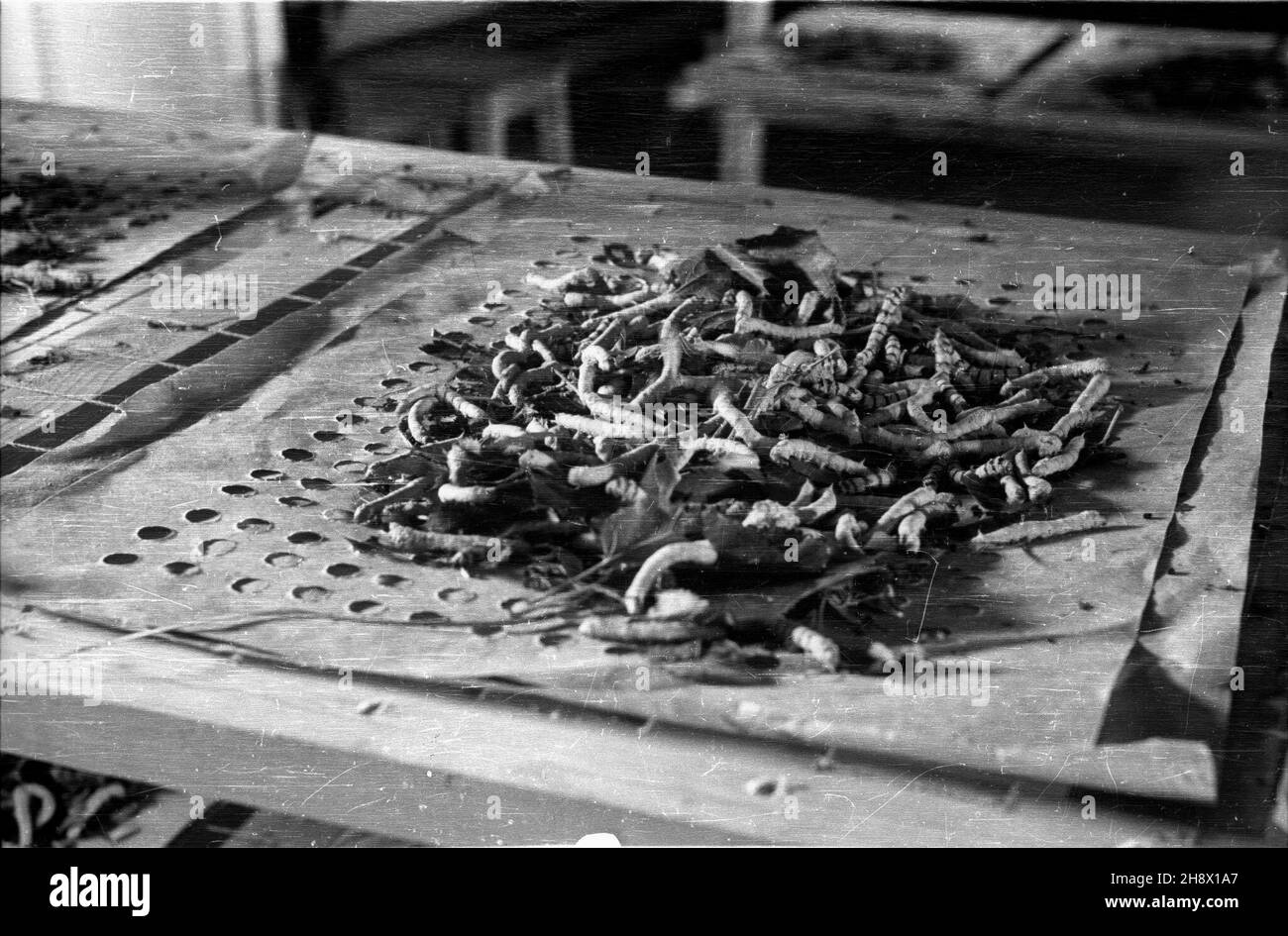 Milanówek, 1946. Centralna Doœwiadczalna Stacja Jedwabnicza. Zak³ad zajmowa³ siê hodowl¹ jedwabników i produkcj¹ tkanin. Za³o¿ony w 1924 r. przez Henryka i Stanis³awê Witaczków, po wojnie znacjonalizowany. Nz. g¹sienice ¿ywi¹ce siê liœæmi morwy. gr PAP/Stanis³aw D¹browiecki Dok³adny miesi¹c i dzieñ wydarzenia nieustalone. Milanowek, 1946. Central Experimental Sericulture Station. The plant was involved in silkworm rearing and silk production. Established in 1924 by Henryk and Stanislawa Witczak, it was nationalised after the war. Pictured: silkworm larvae feeding on mulberry leaves. Stock Photohttps://www.alamy.com/image-license-details/?v=1https://www.alamy.com/milanwek-1946-centralna-dowiadczalna-stacja-jedwabnicza-zakad-zajmowa-si-hodowl-jedwabnikw-i-produkcj-tkanin-zaoony-w-1924-r-przez-henryka-i-stanisaw-witaczkw-po-wojnie-znacjonalizowany-nz-gsienice-ywice-si-limi-morwy-gr-papstanisaw-dbrowiecki-dokadny-miesic-i-dzie-wydarzenia-nieustalone-milanowek-1946-central-experimental-sericulture-station-the-plant-was-involved-in-silkworm-rearing-and-silk-production-established-in-1924-by-henryk-and-stanislawa-witczak-it-was-nationalised-after-the-war-pictured-silkworm-larvae-feeding-on-mulberry-leaves-image452958639.html
Milanówek, 1946. Centralna Doœwiadczalna Stacja Jedwabnicza. Zak³ad zajmowa³ siê hodowl¹ jedwabników i produkcj¹ tkanin. Za³o¿ony w 1924 r. przez Henryka i Stanis³awê Witaczków, po wojnie znacjonalizowany. Nz. g¹sienice ¿ywi¹ce siê liœæmi morwy. gr PAP/Stanis³aw D¹browiecki Dok³adny miesi¹c i dzieñ wydarzenia nieustalone. Milanowek, 1946. Central Experimental Sericulture Station. The plant was involved in silkworm rearing and silk production. Established in 1924 by Henryk and Stanislawa Witczak, it was nationalised after the war. Pictured: silkworm larvae feeding on mulberry leaves. Stock Photohttps://www.alamy.com/image-license-details/?v=1https://www.alamy.com/milanwek-1946-centralna-dowiadczalna-stacja-jedwabnicza-zakad-zajmowa-si-hodowl-jedwabnikw-i-produkcj-tkanin-zaoony-w-1924-r-przez-henryka-i-stanisaw-witaczkw-po-wojnie-znacjonalizowany-nz-gsienice-ywice-si-limi-morwy-gr-papstanisaw-dbrowiecki-dokadny-miesic-i-dzie-wydarzenia-nieustalone-milanowek-1946-central-experimental-sericulture-station-the-plant-was-involved-in-silkworm-rearing-and-silk-production-established-in-1924-by-henryk-and-stanislawa-witczak-it-was-nationalised-after-the-war-pictured-silkworm-larvae-feeding-on-mulberry-leaves-image452958639.htmlRM2H8X1A7–Milanówek, 1946. Centralna Doœwiadczalna Stacja Jedwabnicza. Zak³ad zajmowa³ siê hodowl¹ jedwabników i produkcj¹ tkanin. Za³o¿ony w 1924 r. przez Henryka i Stanis³awê Witaczków, po wojnie znacjonalizowany. Nz. g¹sienice ¿ywi¹ce siê liœæmi morwy. gr PAP/Stanis³aw D¹browiecki Dok³adny miesi¹c i dzieñ wydarzenia nieustalone. Milanowek, 1946. Central Experimental Sericulture Station. The plant was involved in silkworm rearing and silk production. Established in 1924 by Henryk and Stanislawa Witczak, it was nationalised after the war. Pictured: silkworm larvae feeding on mulberry leaves.
 Sericulture Production Business Vector Seamless Pattern Stock Vectorhttps://www.alamy.com/image-license-details/?v=1https://www.alamy.com/sericulture-production-business-vector-seamless-pattern-image464765588.html
Sericulture Production Business Vector Seamless Pattern Stock Vectorhttps://www.alamy.com/image-license-details/?v=1https://www.alamy.com/sericulture-production-business-vector-seamless-pattern-image464765588.htmlRF2J03W70–Sericulture Production Business Vector Seamless Pattern
 Dyeing and winding silk. The production of silk originates in China in prehistoric times. Silk remained confined to China until the Silk Road opened at some point during the later half of the first millennium BC. China maintained its virtual monopoly over silk production for another thousand years. Sericulture, or silk farming, is the cultivation of silkworms to produce silk. Stock Photohttps://www.alamy.com/image-license-details/?v=1https://www.alamy.com/dyeing-and-winding-silk-the-production-of-silk-originates-in-china-in-prehistoric-times-silk-remained-confined-to-china-until-the-silk-road-opened-at-some-point-during-the-later-half-of-the-first-millennium-bc-china-maintained-its-virtual-monopoly-over-silk-production-for-another-thousand-years-sericulture-or-silk-farming-is-the-cultivation-of-silkworms-to-produce-silk-image246623904.html
Dyeing and winding silk. The production of silk originates in China in prehistoric times. Silk remained confined to China until the Silk Road opened at some point during the later half of the first millennium BC. China maintained its virtual monopoly over silk production for another thousand years. Sericulture, or silk farming, is the cultivation of silkworms to produce silk. Stock Photohttps://www.alamy.com/image-license-details/?v=1https://www.alamy.com/dyeing-and-winding-silk-the-production-of-silk-originates-in-china-in-prehistoric-times-silk-remained-confined-to-china-until-the-silk-road-opened-at-some-point-during-the-later-half-of-the-first-millennium-bc-china-maintained-its-virtual-monopoly-over-silk-production-for-another-thousand-years-sericulture-or-silk-farming-is-the-cultivation-of-silkworms-to-produce-silk-image246623904.htmlRMT96K8G–Dyeing and winding silk. The production of silk originates in China in prehistoric times. Silk remained confined to China until the Silk Road opened at some point during the later half of the first millennium BC. China maintained its virtual monopoly over silk production for another thousand years. Sericulture, or silk farming, is the cultivation of silkworms to produce silk.
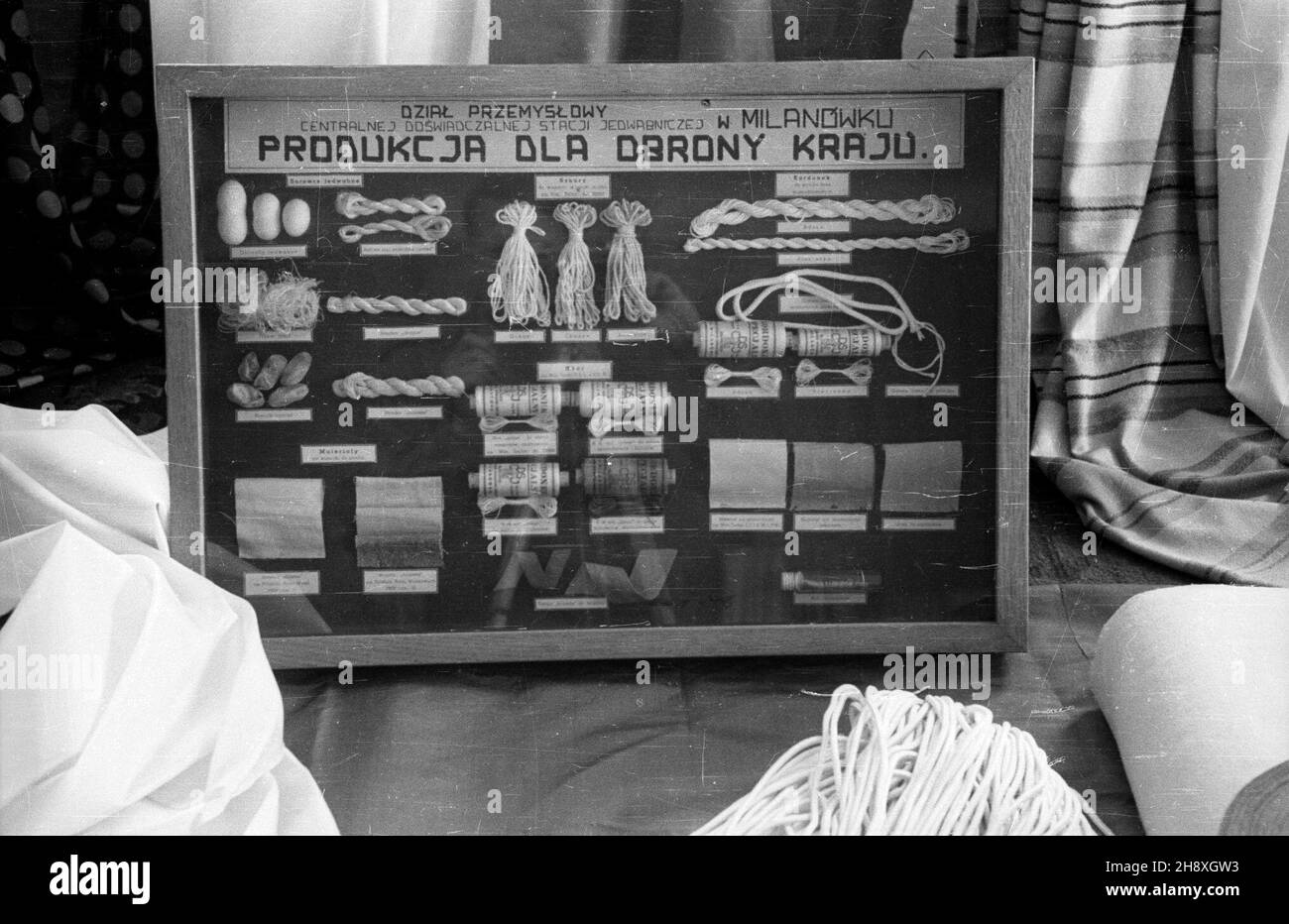 Milanówek, 1946. Centralna Doœwiadczalna Stacja Jedwabnicza. Zak³ad zajmowa³ siê hodowl¹ jedwabników i produkcj¹ tkanin. Za³o¿ony w 1924 r. przez Henryka i Stanis³awê Witaczków, po wojnie znacjonalizowany.Nz. wystawa artyku³ów z jedwabiu prawdziwego Dzia³u Przemys³owego. gr PAP/Stanis³aw D¹browiecki Dok³adny miesi¹c i dzieñ wydarzenia nieustalone. Milanowek, 1946. Central Experimental Sericulture Station. The plant was engaged in silkworm breeding and silk production. Established in 1924 by Henryk and Stanislawa Witczak, it was nationalised after the war. Pictured: a silk product disp Stock Photohttps://www.alamy.com/image-license-details/?v=1https://www.alamy.com/milanwek-1946-centralna-dowiadczalna-stacja-jedwabnicza-zakad-zajmowa-si-hodowl-jedwabnikw-i-produkcj-tkanin-zaoony-w-1924-r-przez-henryka-i-stanisaw-witaczkw-po-wojnie-znacjonalizowanynz-wystawa-artykuw-z-jedwabiu-prawdziwego-dziau-przemysowego-gr-papstanisaw-dbrowiecki-dokadny-miesic-i-dzie-wydarzenia-nieustalone-milanowek-1946-central-experimental-sericulture-station-the-plant-was-engaged-in-silkworm-breeding-and-silk-production-established-in-1924-by-henryk-and-stanislawa-witczak-it-was-nationalised-after-the-war-pictured-a-silk-product-disp-image452970815.html
Milanówek, 1946. Centralna Doœwiadczalna Stacja Jedwabnicza. Zak³ad zajmowa³ siê hodowl¹ jedwabników i produkcj¹ tkanin. Za³o¿ony w 1924 r. przez Henryka i Stanis³awê Witaczków, po wojnie znacjonalizowany.Nz. wystawa artyku³ów z jedwabiu prawdziwego Dzia³u Przemys³owego. gr PAP/Stanis³aw D¹browiecki Dok³adny miesi¹c i dzieñ wydarzenia nieustalone. Milanowek, 1946. Central Experimental Sericulture Station. The plant was engaged in silkworm breeding and silk production. Established in 1924 by Henryk and Stanislawa Witczak, it was nationalised after the war. Pictured: a silk product disp Stock Photohttps://www.alamy.com/image-license-details/?v=1https://www.alamy.com/milanwek-1946-centralna-dowiadczalna-stacja-jedwabnicza-zakad-zajmowa-si-hodowl-jedwabnikw-i-produkcj-tkanin-zaoony-w-1924-r-przez-henryka-i-stanisaw-witaczkw-po-wojnie-znacjonalizowanynz-wystawa-artykuw-z-jedwabiu-prawdziwego-dziau-przemysowego-gr-papstanisaw-dbrowiecki-dokadny-miesic-i-dzie-wydarzenia-nieustalone-milanowek-1946-central-experimental-sericulture-station-the-plant-was-engaged-in-silkworm-breeding-and-silk-production-established-in-1924-by-henryk-and-stanislawa-witczak-it-was-nationalised-after-the-war-pictured-a-silk-product-disp-image452970815.htmlRM2H8XGW3–Milanówek, 1946. Centralna Doœwiadczalna Stacja Jedwabnicza. Zak³ad zajmowa³ siê hodowl¹ jedwabników i produkcj¹ tkanin. Za³o¿ony w 1924 r. przez Henryka i Stanis³awê Witaczków, po wojnie znacjonalizowany.Nz. wystawa artyku³ów z jedwabiu prawdziwego Dzia³u Przemys³owego. gr PAP/Stanis³aw D¹browiecki Dok³adny miesi¹c i dzieñ wydarzenia nieustalone. Milanowek, 1946. Central Experimental Sericulture Station. The plant was engaged in silkworm breeding and silk production. Established in 1924 by Henryk and Stanislawa Witczak, it was nationalised after the war. Pictured: a silk product disp
 Sericulture Production Business Vector Seamless Pattern Stock Vectorhttps://www.alamy.com/image-license-details/?v=1https://www.alamy.com/sericulture-production-business-vector-seamless-pattern-image464765112.html
Sericulture Production Business Vector Seamless Pattern Stock Vectorhttps://www.alamy.com/image-license-details/?v=1https://www.alamy.com/sericulture-production-business-vector-seamless-pattern-image464765112.htmlRF2J03TJ0–Sericulture Production Business Vector Seamless Pattern
 Textiles: six scenes of silk manufacture in China. The production of silk originates in China in prehistoric times. Silk remained confined to China until the Silk Road opened at some point during the later half of the first millennium BC. China maintained its virtual monopoly over silk production for another thousand years. Sericulture, or silk farming, is the cultivation of silkworms to produce silk. Stock Photohttps://www.alamy.com/image-license-details/?v=1https://www.alamy.com/textiles-six-scenes-of-silk-manufacture-in-china-the-production-of-silk-originates-in-china-in-prehistoric-times-silk-remained-confined-to-china-until-the-silk-road-opened-at-some-point-during-the-later-half-of-the-first-millennium-bc-china-maintained-its-virtual-monopoly-over-silk-production-for-another-thousand-years-sericulture-or-silk-farming-is-the-cultivation-of-silkworms-to-produce-silk-image246623888.html
Textiles: six scenes of silk manufacture in China. The production of silk originates in China in prehistoric times. Silk remained confined to China until the Silk Road opened at some point during the later half of the first millennium BC. China maintained its virtual monopoly over silk production for another thousand years. Sericulture, or silk farming, is the cultivation of silkworms to produce silk. Stock Photohttps://www.alamy.com/image-license-details/?v=1https://www.alamy.com/textiles-six-scenes-of-silk-manufacture-in-china-the-production-of-silk-originates-in-china-in-prehistoric-times-silk-remained-confined-to-china-until-the-silk-road-opened-at-some-point-during-the-later-half-of-the-first-millennium-bc-china-maintained-its-virtual-monopoly-over-silk-production-for-another-thousand-years-sericulture-or-silk-farming-is-the-cultivation-of-silkworms-to-produce-silk-image246623888.htmlRMT96K80–Textiles: six scenes of silk manufacture in China. The production of silk originates in China in prehistoric times. Silk remained confined to China until the Silk Road opened at some point during the later half of the first millennium BC. China maintained its virtual monopoly over silk production for another thousand years. Sericulture, or silk farming, is the cultivation of silkworms to produce silk.
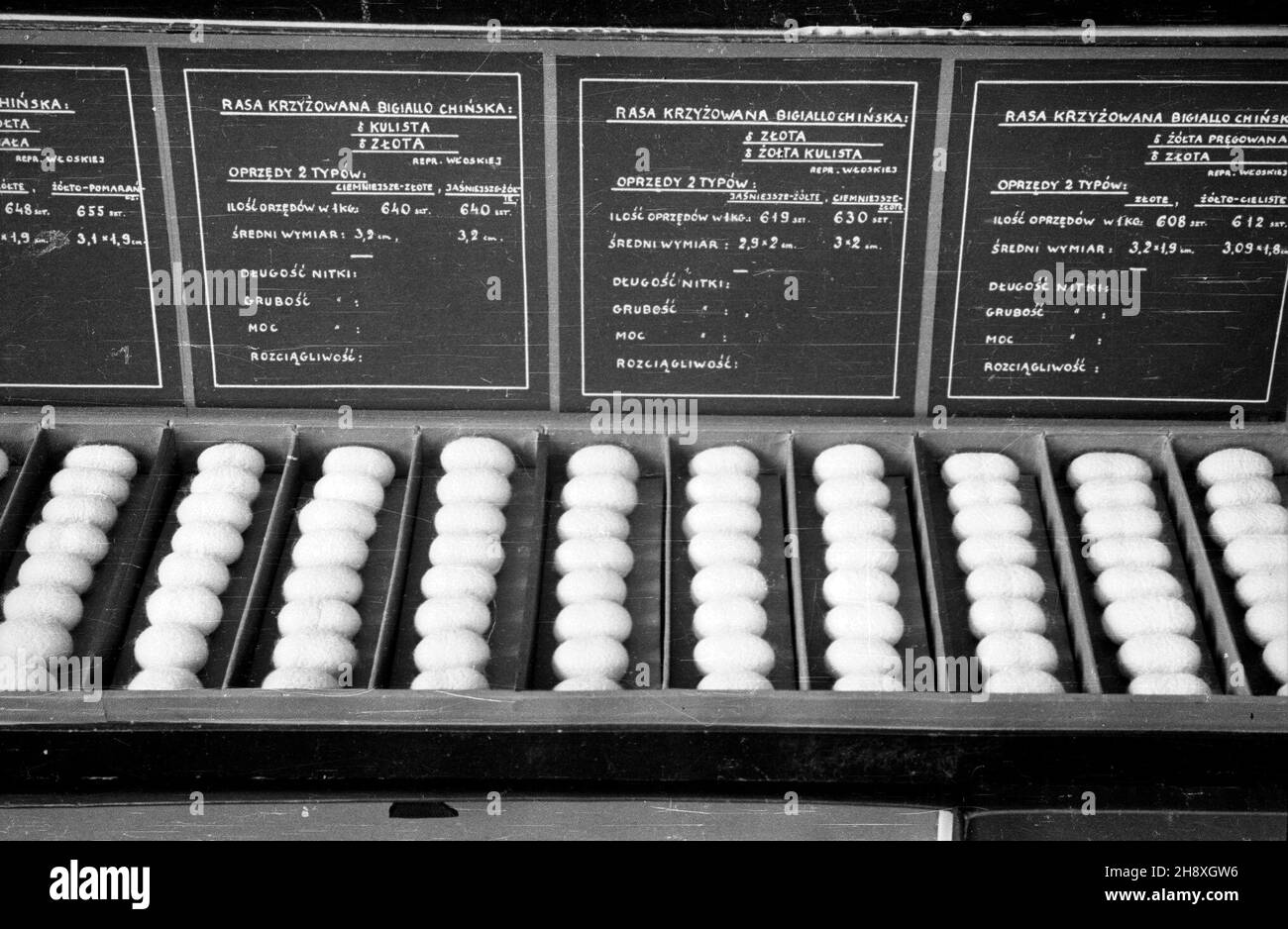 Milanówek, 1946. Centralna Doœwiadczalna Stacja Jedwabnicza. Zak³ad zajmowa³ siê hodowl¹ jedwabników i produkcj¹ tkanin. Za³o¿ony w 1924 r. przez Henryka i Stanis³awê Witaczków, po wojnie znacjonalizowany.Nz. wystawa kokonów-k³êbuszków czyli jedwabnych oprzêdów. gr PAP/Stanis³aw D¹browiecki Dok³adny miesi¹c i dzieñ wydarzenia nieustalone. Milanowek, 1946. Central Experimental Sericulture Station. The plant was engaged in silkworm breeding and silk production. Established in 1924 by Henryk and Stanislawa Witczak, it was nationalised after the war. Pictured: a cocoon display. gr PAP/S Stock Photohttps://www.alamy.com/image-license-details/?v=1https://www.alamy.com/milanwek-1946-centralna-dowiadczalna-stacja-jedwabnicza-zakad-zajmowa-si-hodowl-jedwabnikw-i-produkcj-tkanin-zaoony-w-1924-r-przez-henryka-i-stanisaw-witaczkw-po-wojnie-znacjonalizowanynz-wystawa-kokonw-kbuszkw-czyli-jedwabnych-oprzdw-gr-papstanisaw-dbrowiecki-dokadny-miesic-i-dzie-wydarzenia-nieustalone-milanowek-1946-central-experimental-sericulture-station-the-plant-was-engaged-in-silkworm-breeding-and-silk-production-established-in-1924-by-henryk-and-stanislawa-witczak-it-was-nationalised-after-the-war-pictured-a-cocoon-display-gr-paps-image452970818.html
Milanówek, 1946. Centralna Doœwiadczalna Stacja Jedwabnicza. Zak³ad zajmowa³ siê hodowl¹ jedwabników i produkcj¹ tkanin. Za³o¿ony w 1924 r. przez Henryka i Stanis³awê Witaczków, po wojnie znacjonalizowany.Nz. wystawa kokonów-k³êbuszków czyli jedwabnych oprzêdów. gr PAP/Stanis³aw D¹browiecki Dok³adny miesi¹c i dzieñ wydarzenia nieustalone. Milanowek, 1946. Central Experimental Sericulture Station. The plant was engaged in silkworm breeding and silk production. Established in 1924 by Henryk and Stanislawa Witczak, it was nationalised after the war. Pictured: a cocoon display. gr PAP/S Stock Photohttps://www.alamy.com/image-license-details/?v=1https://www.alamy.com/milanwek-1946-centralna-dowiadczalna-stacja-jedwabnicza-zakad-zajmowa-si-hodowl-jedwabnikw-i-produkcj-tkanin-zaoony-w-1924-r-przez-henryka-i-stanisaw-witaczkw-po-wojnie-znacjonalizowanynz-wystawa-kokonw-kbuszkw-czyli-jedwabnych-oprzdw-gr-papstanisaw-dbrowiecki-dokadny-miesic-i-dzie-wydarzenia-nieustalone-milanowek-1946-central-experimental-sericulture-station-the-plant-was-engaged-in-silkworm-breeding-and-silk-production-established-in-1924-by-henryk-and-stanislawa-witczak-it-was-nationalised-after-the-war-pictured-a-cocoon-display-gr-paps-image452970818.htmlRM2H8XGW6–Milanówek, 1946. Centralna Doœwiadczalna Stacja Jedwabnicza. Zak³ad zajmowa³ siê hodowl¹ jedwabników i produkcj¹ tkanin. Za³o¿ony w 1924 r. przez Henryka i Stanis³awê Witaczków, po wojnie znacjonalizowany.Nz. wystawa kokonów-k³êbuszków czyli jedwabnych oprzêdów. gr PAP/Stanis³aw D¹browiecki Dok³adny miesi¹c i dzieñ wydarzenia nieustalone. Milanowek, 1946. Central Experimental Sericulture Station. The plant was engaged in silkworm breeding and silk production. Established in 1924 by Henryk and Stanislawa Witczak, it was nationalised after the war. Pictured: a cocoon display. gr PAP/S
RF2WK26AN–Sericulture Production Business isometric icons set vector
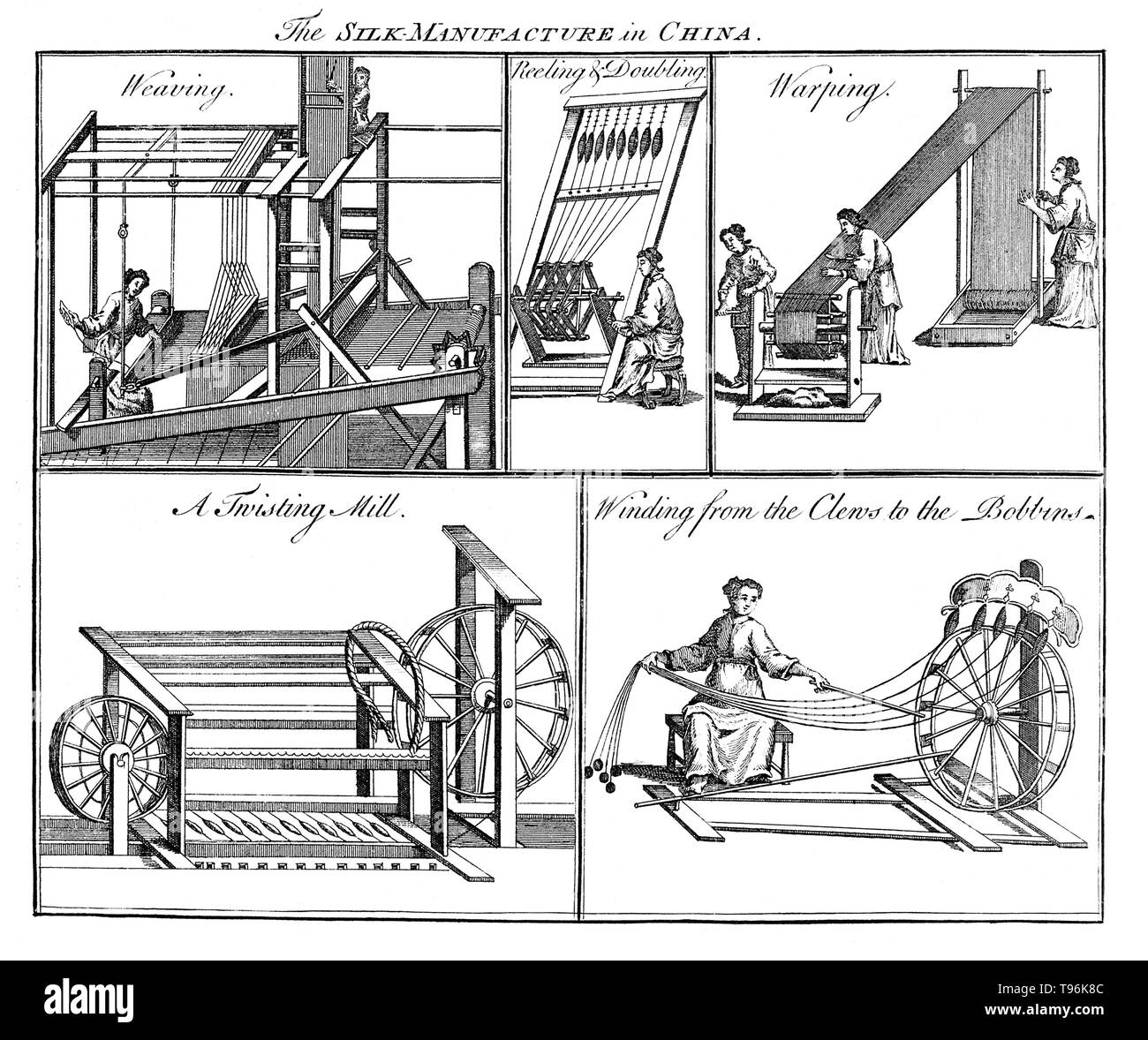 Textiles: five scenes of silk manufacture in China. The production of silk originates in China in prehistoric times. Silk remained confined to China until the Silk Road opened at some point during the later half of the first millennium BC. China maintained its virtual monopoly over silk production for another thousand years. Sericulture, or silk farming, is the cultivation of silkworms to produce silk. Stock Photohttps://www.alamy.com/image-license-details/?v=1https://www.alamy.com/textiles-five-scenes-of-silk-manufacture-in-china-the-production-of-silk-originates-in-china-in-prehistoric-times-silk-remained-confined-to-china-until-the-silk-road-opened-at-some-point-during-the-later-half-of-the-first-millennium-bc-china-maintained-its-virtual-monopoly-over-silk-production-for-another-thousand-years-sericulture-or-silk-farming-is-the-cultivation-of-silkworms-to-produce-silk-image246623900.html
Textiles: five scenes of silk manufacture in China. The production of silk originates in China in prehistoric times. Silk remained confined to China until the Silk Road opened at some point during the later half of the first millennium BC. China maintained its virtual monopoly over silk production for another thousand years. Sericulture, or silk farming, is the cultivation of silkworms to produce silk. Stock Photohttps://www.alamy.com/image-license-details/?v=1https://www.alamy.com/textiles-five-scenes-of-silk-manufacture-in-china-the-production-of-silk-originates-in-china-in-prehistoric-times-silk-remained-confined-to-china-until-the-silk-road-opened-at-some-point-during-the-later-half-of-the-first-millennium-bc-china-maintained-its-virtual-monopoly-over-silk-production-for-another-thousand-years-sericulture-or-silk-farming-is-the-cultivation-of-silkworms-to-produce-silk-image246623900.htmlRMT96K8C–Textiles: five scenes of silk manufacture in China. The production of silk originates in China in prehistoric times. Silk remained confined to China until the Silk Road opened at some point during the later half of the first millennium BC. China maintained its virtual monopoly over silk production for another thousand years. Sericulture, or silk farming, is the cultivation of silkworms to produce silk.
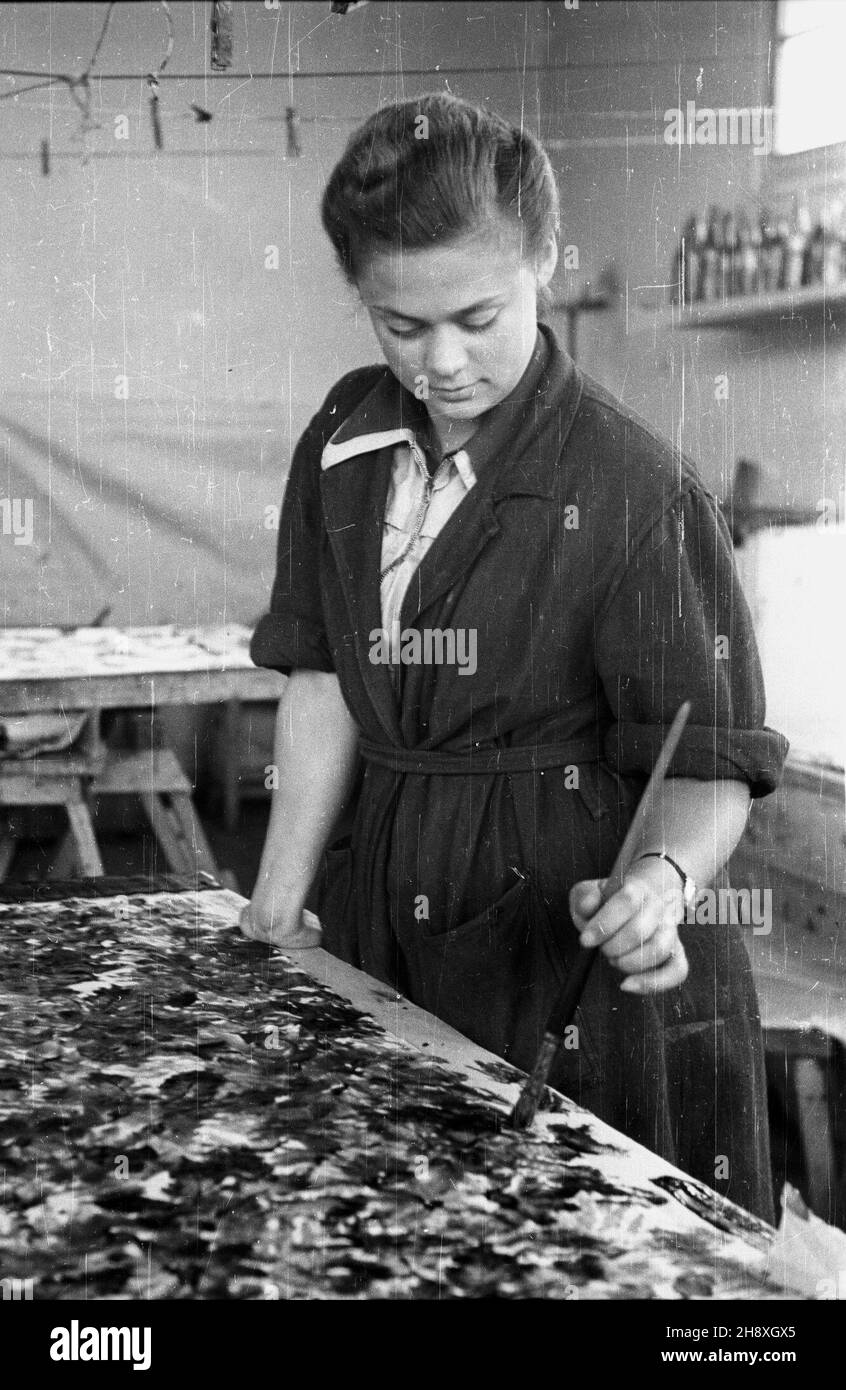 Milanówek, 1946. Centralna Doœwiadczalna Stacja Jedwabnicza. Zak³ad zajmowa³ siê hodowl¹ jedwabników i produkcj¹ tkanin. Za³o¿ony w 1924 r. przez Henryka i Stanis³awê Witaczków, po wojnie znacjonalizowany.Nz. rêczne malowanie na jedwabiu naturalnym. gr PAP/Stanis³aw D¹browiecki Dok³adny miesi¹c i dzieñ wydarzenia nieustalone. Milanowek, 1946. Central Experimental Sericulture Station. The plant was engaged in silkworm breeding and silk production. Established in 1924 by Henryk and Stanislawa Witczak, it was nationalised after the war. Pictured: hand painting on silk. gr PAP/Stanislaw Stock Photohttps://www.alamy.com/image-license-details/?v=1https://www.alamy.com/milanwek-1946-centralna-dowiadczalna-stacja-jedwabnicza-zakad-zajmowa-si-hodowl-jedwabnikw-i-produkcj-tkanin-zaoony-w-1924-r-przez-henryka-i-stanisaw-witaczkw-po-wojnie-znacjonalizowanynz-rczne-malowanie-na-jedwabiu-naturalnym-gr-papstanisaw-dbrowiecki-dokadny-miesic-i-dzie-wydarzenia-nieustalone-milanowek-1946-central-experimental-sericulture-station-the-plant-was-engaged-in-silkworm-breeding-and-silk-production-established-in-1924-by-henryk-and-stanislawa-witczak-it-was-nationalised-after-the-war-pictured-hand-painting-on-silk-gr-papstanislaw-image452970845.html
Milanówek, 1946. Centralna Doœwiadczalna Stacja Jedwabnicza. Zak³ad zajmowa³ siê hodowl¹ jedwabników i produkcj¹ tkanin. Za³o¿ony w 1924 r. przez Henryka i Stanis³awê Witaczków, po wojnie znacjonalizowany.Nz. rêczne malowanie na jedwabiu naturalnym. gr PAP/Stanis³aw D¹browiecki Dok³adny miesi¹c i dzieñ wydarzenia nieustalone. Milanowek, 1946. Central Experimental Sericulture Station. The plant was engaged in silkworm breeding and silk production. Established in 1924 by Henryk and Stanislawa Witczak, it was nationalised after the war. Pictured: hand painting on silk. gr PAP/Stanislaw Stock Photohttps://www.alamy.com/image-license-details/?v=1https://www.alamy.com/milanwek-1946-centralna-dowiadczalna-stacja-jedwabnicza-zakad-zajmowa-si-hodowl-jedwabnikw-i-produkcj-tkanin-zaoony-w-1924-r-przez-henryka-i-stanisaw-witaczkw-po-wojnie-znacjonalizowanynz-rczne-malowanie-na-jedwabiu-naturalnym-gr-papstanisaw-dbrowiecki-dokadny-miesic-i-dzie-wydarzenia-nieustalone-milanowek-1946-central-experimental-sericulture-station-the-plant-was-engaged-in-silkworm-breeding-and-silk-production-established-in-1924-by-henryk-and-stanislawa-witczak-it-was-nationalised-after-the-war-pictured-hand-painting-on-silk-gr-papstanislaw-image452970845.htmlRM2H8XGX5–Milanówek, 1946. Centralna Doœwiadczalna Stacja Jedwabnicza. Zak³ad zajmowa³ siê hodowl¹ jedwabników i produkcj¹ tkanin. Za³o¿ony w 1924 r. przez Henryka i Stanis³awê Witaczków, po wojnie znacjonalizowany.Nz. rêczne malowanie na jedwabiu naturalnym. gr PAP/Stanis³aw D¹browiecki Dok³adny miesi¹c i dzieñ wydarzenia nieustalone. Milanowek, 1946. Central Experimental Sericulture Station. The plant was engaged in silkworm breeding and silk production. Established in 1924 by Henryk and Stanislawa Witczak, it was nationalised after the war. Pictured: hand painting on silk. gr PAP/Stanislaw
 Sorting Silkworm Cocoons, Silk Making in China Stock Photohttps://www.alamy.com/image-license-details/?v=1https://www.alamy.com/sorting-silkworm-cocoons-silk-making-in-china-image245870238.html
Sorting Silkworm Cocoons, Silk Making in China Stock Photohttps://www.alamy.com/image-license-details/?v=1https://www.alamy.com/sorting-silkworm-cocoons-silk-making-in-china-image245870238.htmlRMT809YX–Sorting Silkworm Cocoons, Silk Making in China
RF2HTM8N0–waste silk color icon vector illustration
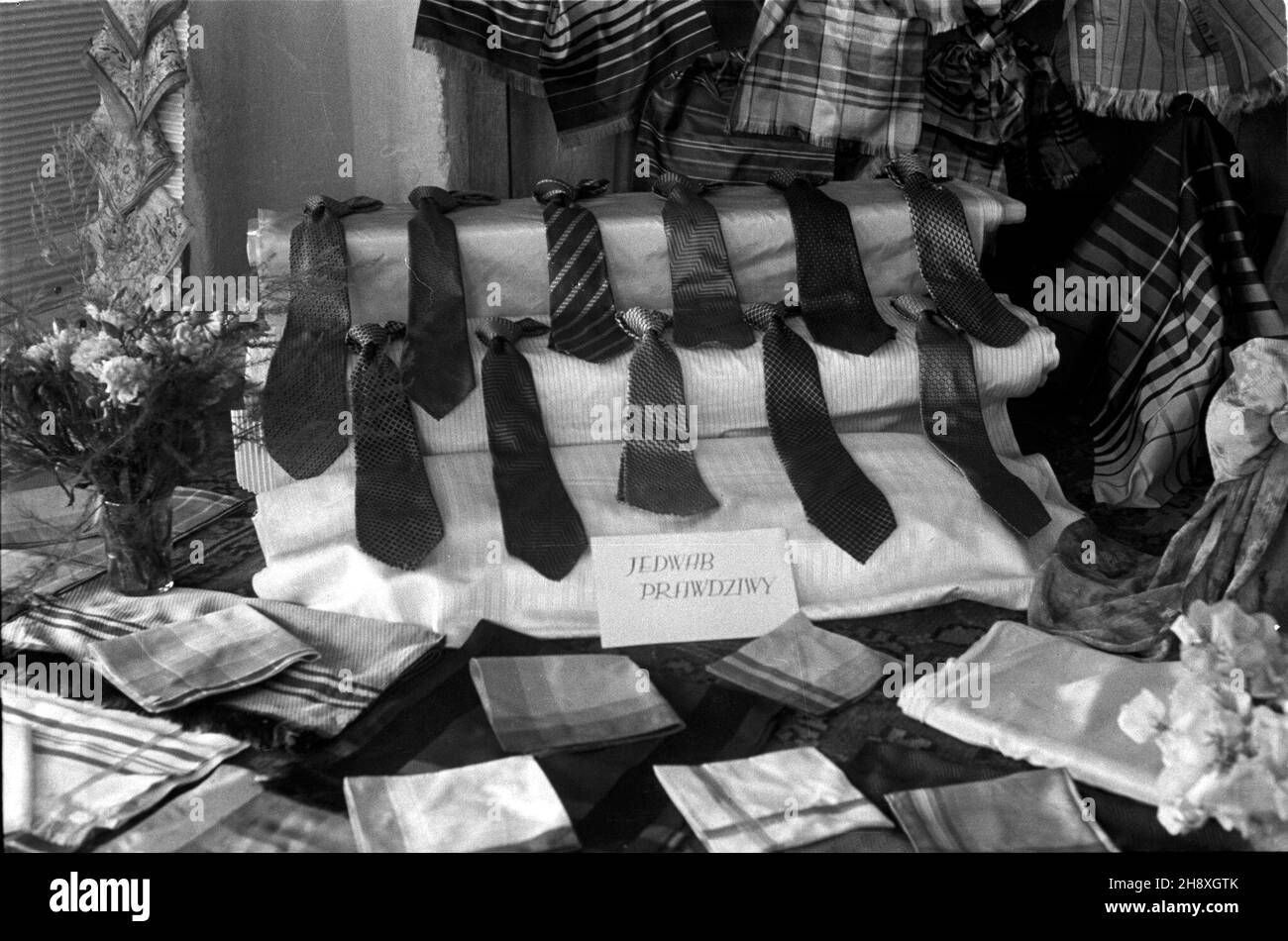 Milanówek, 1946. Centralna Doœwiadczalna Stacja Jedwabnicza. Zak³ad zajmowa³ siê hodowl¹ jedwabników i produkcj¹ tkanin. Za³o¿ony w 1924 r. przez Henryka i Stanis³awê Witaczków, po wojnie znacjonalizowany.Nz. wystawa artyku³ów z jedwabiu prawdziwego. gr PAP/Stanis³aw D¹browiecki Dok³adny miesi¹c i dzieñ wydarzenia nieustalone. Milanowek, 1946. Central Experimental Sericulture Station. The plant was engaged in silkworm breeding and silk production. Established in 1924 by Henryk and Stanislawa Witczak, it was nationalised after the war. Pictured: a silk product display. gr PAP/Stanisl Stock Photohttps://www.alamy.com/image-license-details/?v=1https://www.alamy.com/milanwek-1946-centralna-dowiadczalna-stacja-jedwabnicza-zakad-zajmowa-si-hodowl-jedwabnikw-i-produkcj-tkanin-zaoony-w-1924-r-przez-henryka-i-stanisaw-witaczkw-po-wojnie-znacjonalizowanynz-wystawa-artykuw-z-jedwabiu-prawdziwego-gr-papstanisaw-dbrowiecki-dokadny-miesic-i-dzie-wydarzenia-nieustalone-milanowek-1946-central-experimental-sericulture-station-the-plant-was-engaged-in-silkworm-breeding-and-silk-production-established-in-1924-by-henryk-and-stanislawa-witczak-it-was-nationalised-after-the-war-pictured-a-silk-product-display-gr-papstanisl-image452970803.html
Milanówek, 1946. Centralna Doœwiadczalna Stacja Jedwabnicza. Zak³ad zajmowa³ siê hodowl¹ jedwabników i produkcj¹ tkanin. Za³o¿ony w 1924 r. przez Henryka i Stanis³awê Witaczków, po wojnie znacjonalizowany.Nz. wystawa artyku³ów z jedwabiu prawdziwego. gr PAP/Stanis³aw D¹browiecki Dok³adny miesi¹c i dzieñ wydarzenia nieustalone. Milanowek, 1946. Central Experimental Sericulture Station. The plant was engaged in silkworm breeding and silk production. Established in 1924 by Henryk and Stanislawa Witczak, it was nationalised after the war. Pictured: a silk product display. gr PAP/Stanisl Stock Photohttps://www.alamy.com/image-license-details/?v=1https://www.alamy.com/milanwek-1946-centralna-dowiadczalna-stacja-jedwabnicza-zakad-zajmowa-si-hodowl-jedwabnikw-i-produkcj-tkanin-zaoony-w-1924-r-przez-henryka-i-stanisaw-witaczkw-po-wojnie-znacjonalizowanynz-wystawa-artykuw-z-jedwabiu-prawdziwego-gr-papstanisaw-dbrowiecki-dokadny-miesic-i-dzie-wydarzenia-nieustalone-milanowek-1946-central-experimental-sericulture-station-the-plant-was-engaged-in-silkworm-breeding-and-silk-production-established-in-1924-by-henryk-and-stanislawa-witczak-it-was-nationalised-after-the-war-pictured-a-silk-product-display-gr-papstanisl-image452970803.htmlRM2H8XGTK–Milanówek, 1946. Centralna Doœwiadczalna Stacja Jedwabnicza. Zak³ad zajmowa³ siê hodowl¹ jedwabników i produkcj¹ tkanin. Za³o¿ony w 1924 r. przez Henryka i Stanis³awê Witaczków, po wojnie znacjonalizowany.Nz. wystawa artyku³ów z jedwabiu prawdziwego. gr PAP/Stanis³aw D¹browiecki Dok³adny miesi¹c i dzieñ wydarzenia nieustalone. Milanowek, 1946. Central Experimental Sericulture Station. The plant was engaged in silkworm breeding and silk production. Established in 1924 by Henryk and Stanislawa Witczak, it was nationalised after the war. Pictured: a silk product display. gr PAP/Stanisl
 Soaking Cocoons, Silk Making in China Stock Photohttps://www.alamy.com/image-license-details/?v=1https://www.alamy.com/soaking-cocoons-silk-making-in-china-image245870233.html
Soaking Cocoons, Silk Making in China Stock Photohttps://www.alamy.com/image-license-details/?v=1https://www.alamy.com/soaking-cocoons-silk-making-in-china-image245870233.htmlRMT809YN–Soaking Cocoons, Silk Making in China
RF2WKBCB7–ribbon silk isometric icon vector illustration
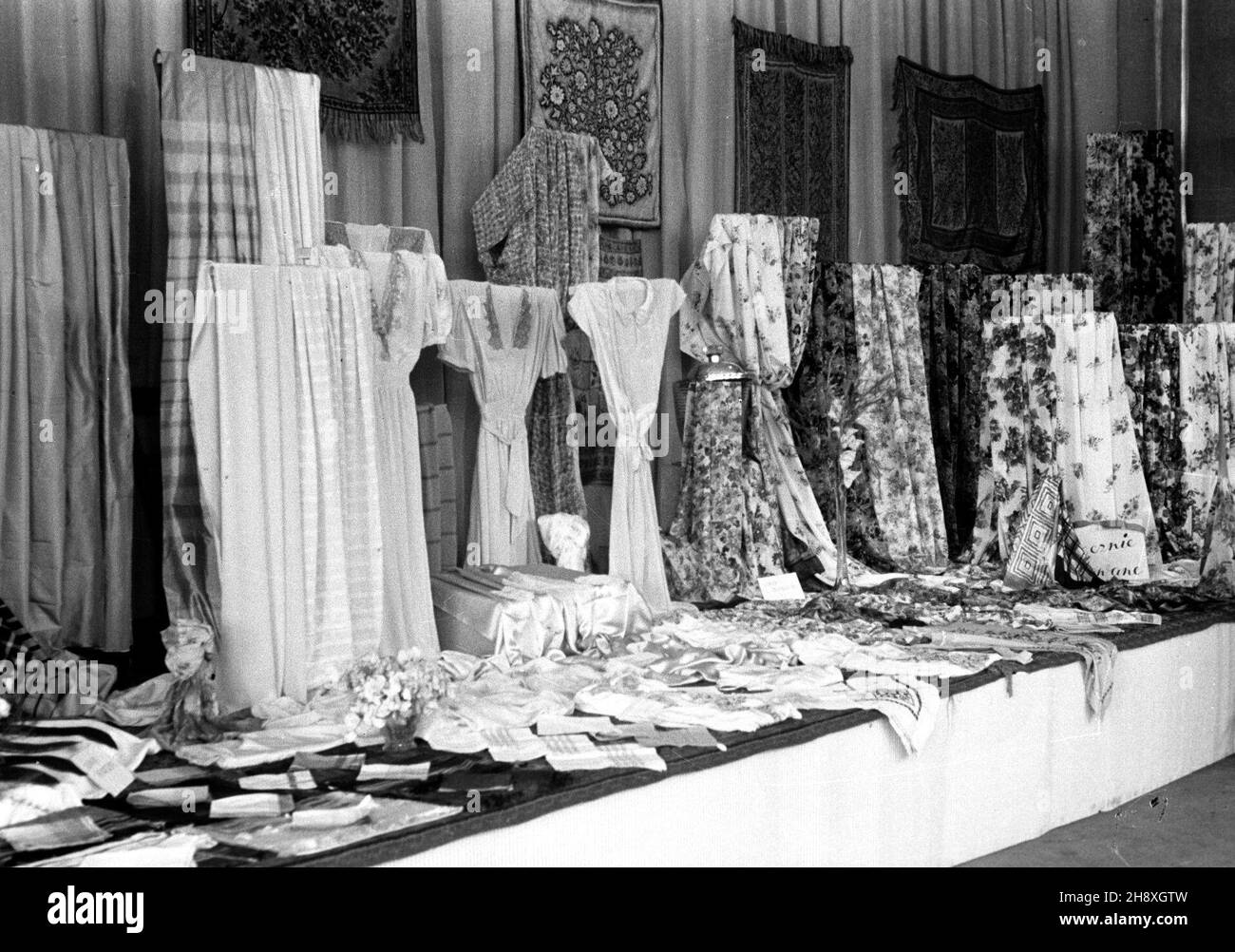 Milanówek, 1946. Centralna Doœwiadczalna Stacja Jedwabnicza. Zak³ad zajmowa³ siê hodowl¹ jedwabników i produkcj¹ tkanin. Za³o¿ony w 1924 r. przez Henryka i Stanis³awê Witaczków, po wojnie znacjonalizowany.Nz. wystawa artyku³ów z jedwabiu prawdziwego. gr PAP/Stanis³aw D¹browiecki Dok³adny miesi¹c i dzieñ wydarzenia nieustalone. Milanowek, 1946. Central Experimental Sericulture Station. The plant was engaged in silkworm breeding and silk production. Established in 1924 by Henryk and Stanislawa Witczak, it was nationalised after the war. Pictured: a silk product display. gr PAP/Stanisl Stock Photohttps://www.alamy.com/image-license-details/?v=1https://www.alamy.com/milanwek-1946-centralna-dowiadczalna-stacja-jedwabnicza-zakad-zajmowa-si-hodowl-jedwabnikw-i-produkcj-tkanin-zaoony-w-1924-r-przez-henryka-i-stanisaw-witaczkw-po-wojnie-znacjonalizowanynz-wystawa-artykuw-z-jedwabiu-prawdziwego-gr-papstanisaw-dbrowiecki-dokadny-miesic-i-dzie-wydarzenia-nieustalone-milanowek-1946-central-experimental-sericulture-station-the-plant-was-engaged-in-silkworm-breeding-and-silk-production-established-in-1924-by-henryk-and-stanislawa-witczak-it-was-nationalised-after-the-war-pictured-a-silk-product-display-gr-papstanisl-image452970809.html
Milanówek, 1946. Centralna Doœwiadczalna Stacja Jedwabnicza. Zak³ad zajmowa³ siê hodowl¹ jedwabników i produkcj¹ tkanin. Za³o¿ony w 1924 r. przez Henryka i Stanis³awê Witaczków, po wojnie znacjonalizowany.Nz. wystawa artyku³ów z jedwabiu prawdziwego. gr PAP/Stanis³aw D¹browiecki Dok³adny miesi¹c i dzieñ wydarzenia nieustalone. Milanowek, 1946. Central Experimental Sericulture Station. The plant was engaged in silkworm breeding and silk production. Established in 1924 by Henryk and Stanislawa Witczak, it was nationalised after the war. Pictured: a silk product display. gr PAP/Stanisl Stock Photohttps://www.alamy.com/image-license-details/?v=1https://www.alamy.com/milanwek-1946-centralna-dowiadczalna-stacja-jedwabnicza-zakad-zajmowa-si-hodowl-jedwabnikw-i-produkcj-tkanin-zaoony-w-1924-r-przez-henryka-i-stanisaw-witaczkw-po-wojnie-znacjonalizowanynz-wystawa-artykuw-z-jedwabiu-prawdziwego-gr-papstanisaw-dbrowiecki-dokadny-miesic-i-dzie-wydarzenia-nieustalone-milanowek-1946-central-experimental-sericulture-station-the-plant-was-engaged-in-silkworm-breeding-and-silk-production-established-in-1924-by-henryk-and-stanislawa-witczak-it-was-nationalised-after-the-war-pictured-a-silk-product-display-gr-papstanisl-image452970809.htmlRM2H8XGTW–Milanówek, 1946. Centralna Doœwiadczalna Stacja Jedwabnicza. Zak³ad zajmowa³ siê hodowl¹ jedwabników i produkcj¹ tkanin. Za³o¿ony w 1924 r. przez Henryka i Stanis³awê Witaczków, po wojnie znacjonalizowany.Nz. wystawa artyku³ów z jedwabiu prawdziwego. gr PAP/Stanis³aw D¹browiecki Dok³adny miesi¹c i dzieñ wydarzenia nieustalone. Milanowek, 1946. Central Experimental Sericulture Station. The plant was engaged in silkworm breeding and silk production. Established in 1924 by Henryk and Stanislawa Witczak, it was nationalised after the war. Pictured: a silk product display. gr PAP/Stanisl
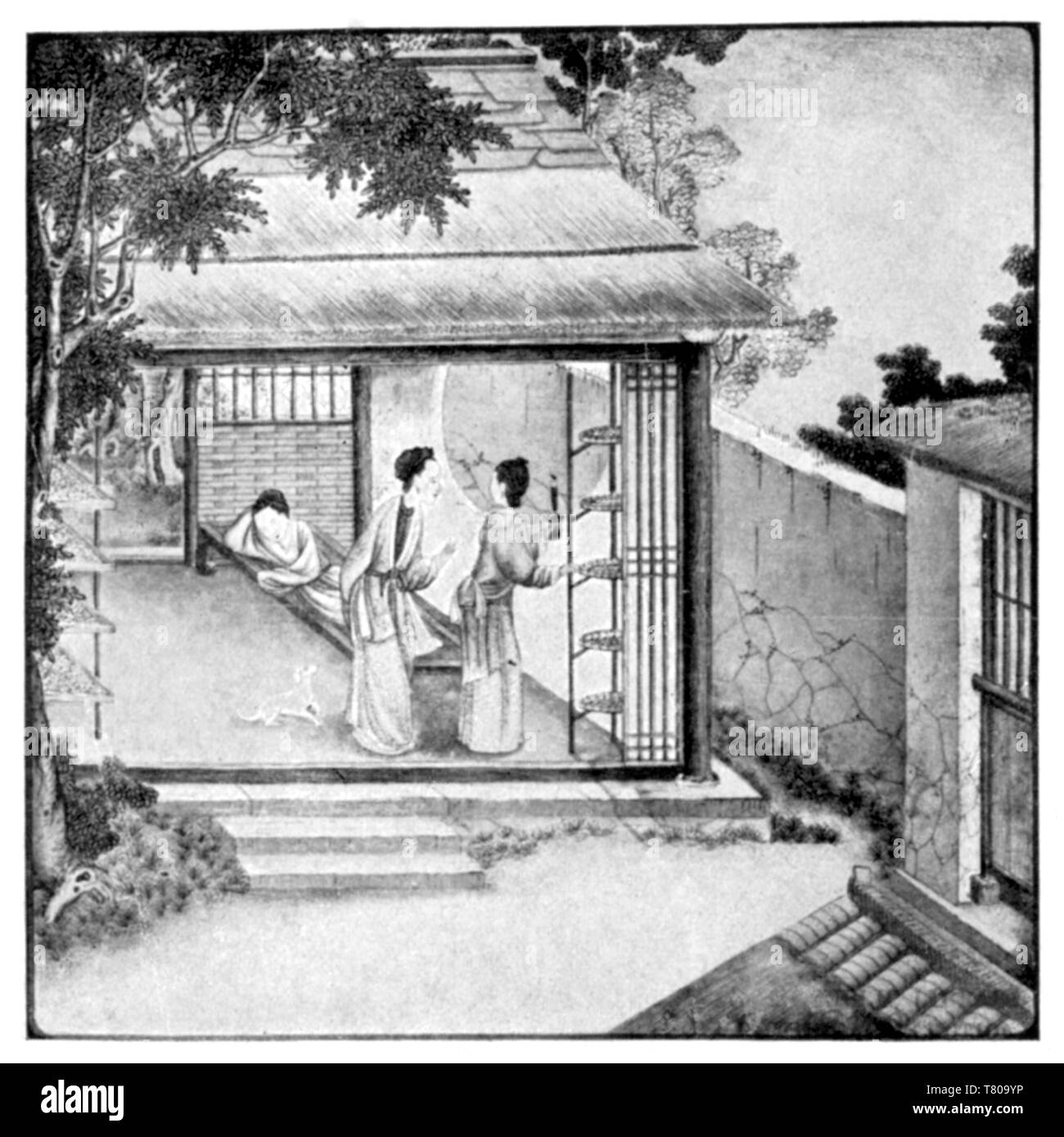 Feeding the Silkworms, Silk Making in China Stock Photohttps://www.alamy.com/image-license-details/?v=1https://www.alamy.com/feeding-the-silkworms-silk-making-in-china-image245870234.html
Feeding the Silkworms, Silk Making in China Stock Photohttps://www.alamy.com/image-license-details/?v=1https://www.alamy.com/feeding-the-silkworms-silk-making-in-china-image245870234.htmlRMT809YP–Feeding the Silkworms, Silk Making in China
RF2WKBCR5–waste silk isometric icon vector illustration
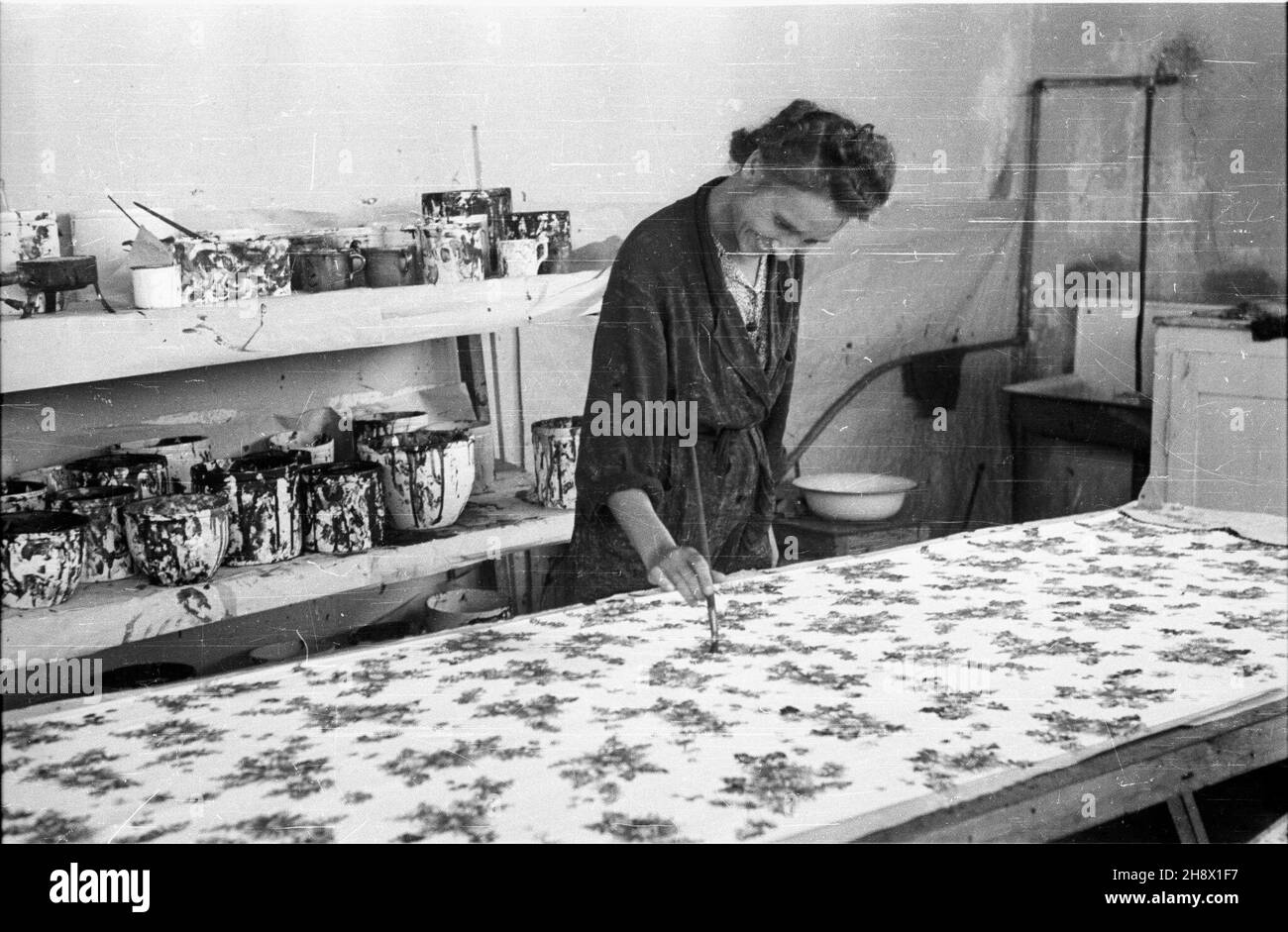 Milanówek, 1946. Centralna Doœwiadczalna Stacja Jedwabnicza. Zak³ad zajmowa³ siê hodowl¹ jedwabników i produkcj¹ tkanin. Za³o¿ony w 1924 r. przez Henryka i Stanis³awê Witaczków, po wojnie znacjonalizowany.Nz. rêczne malowanie na jedwabiu naturalnym. gr PAP/Stanis³aw D¹browiecki Dok³adny miesi¹c i dzieñ wydarzenia nieustalone. Milanowek, 1946. Central Experimental Sericulture Station. The plant was engaged in silkworm breeding and silk production. Established in 1924 by Henryk and Stanislawa Witczak, it was nationalised after the war. Pictured: hand painting on silk. gr PAP/Stanislaw Stock Photohttps://www.alamy.com/image-license-details/?v=1https://www.alamy.com/milanwek-1946-centralna-dowiadczalna-stacja-jedwabnicza-zakad-zajmowa-si-hodowl-jedwabnikw-i-produkcj-tkanin-zaoony-w-1924-r-przez-henryka-i-stanisaw-witaczkw-po-wojnie-znacjonalizowanynz-rczne-malowanie-na-jedwabiu-naturalnym-gr-papstanisaw-dbrowiecki-dokadny-miesic-i-dzie-wydarzenia-nieustalone-milanowek-1946-central-experimental-sericulture-station-the-plant-was-engaged-in-silkworm-breeding-and-silk-production-established-in-1924-by-henryk-and-stanislawa-witczak-it-was-nationalised-after-the-war-pictured-hand-painting-on-silk-gr-papstanislaw-image452958779.html
Milanówek, 1946. Centralna Doœwiadczalna Stacja Jedwabnicza. Zak³ad zajmowa³ siê hodowl¹ jedwabników i produkcj¹ tkanin. Za³o¿ony w 1924 r. przez Henryka i Stanis³awê Witaczków, po wojnie znacjonalizowany.Nz. rêczne malowanie na jedwabiu naturalnym. gr PAP/Stanis³aw D¹browiecki Dok³adny miesi¹c i dzieñ wydarzenia nieustalone. Milanowek, 1946. Central Experimental Sericulture Station. The plant was engaged in silkworm breeding and silk production. Established in 1924 by Henryk and Stanislawa Witczak, it was nationalised after the war. Pictured: hand painting on silk. gr PAP/Stanislaw Stock Photohttps://www.alamy.com/image-license-details/?v=1https://www.alamy.com/milanwek-1946-centralna-dowiadczalna-stacja-jedwabnicza-zakad-zajmowa-si-hodowl-jedwabnikw-i-produkcj-tkanin-zaoony-w-1924-r-przez-henryka-i-stanisaw-witaczkw-po-wojnie-znacjonalizowanynz-rczne-malowanie-na-jedwabiu-naturalnym-gr-papstanisaw-dbrowiecki-dokadny-miesic-i-dzie-wydarzenia-nieustalone-milanowek-1946-central-experimental-sericulture-station-the-plant-was-engaged-in-silkworm-breeding-and-silk-production-established-in-1924-by-henryk-and-stanislawa-witczak-it-was-nationalised-after-the-war-pictured-hand-painting-on-silk-gr-papstanislaw-image452958779.htmlRM2H8X1F7–Milanówek, 1946. Centralna Doœwiadczalna Stacja Jedwabnicza. Zak³ad zajmowa³ siê hodowl¹ jedwabników i produkcj¹ tkanin. Za³o¿ony w 1924 r. przez Henryka i Stanis³awê Witaczków, po wojnie znacjonalizowany.Nz. rêczne malowanie na jedwabiu naturalnym. gr PAP/Stanis³aw D¹browiecki Dok³adny miesi¹c i dzieñ wydarzenia nieustalone. Milanowek, 1946. Central Experimental Sericulture Station. The plant was engaged in silkworm breeding and silk production. Established in 1924 by Henryk and Stanislawa Witczak, it was nationalised after the war. Pictured: hand painting on silk. gr PAP/Stanislaw
RF2WKBDN4–silk thread isometric icon vector illustration
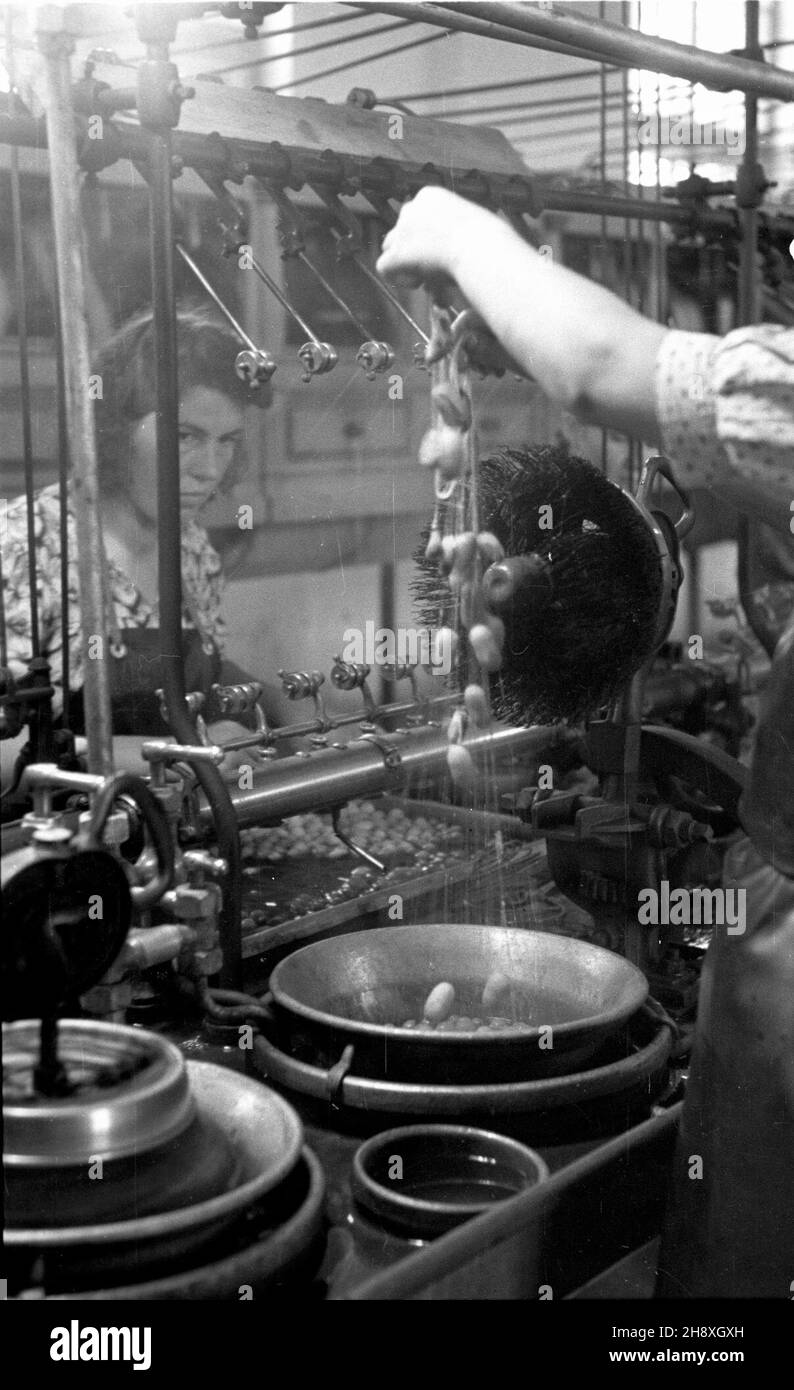 Milanówek, 1946. Centralna Doœwiadczalna Stacja Jedwabnicza. Zak³ad zajmowa³ siê hodowl¹ jedwabników i produkcj¹ tkanin. Za³o¿ony w 1924 r. przez Henryka i Stanis³awê Witaczków, po wojnie znacjonalizowany.Nz. hodowcy umieszczaj¹ kokony w wysokiej temperaturze, w której poczwarki zamieraj¹, a zostaj¹ jedwabne oprzêdy. Z tych mocno skrêconych kokonów-k³êbuszków, uzyskuje siê – po namoczeniu i rozwiniêciu – jedwabn¹ nitkê. gr PAP/Stanis³aw D¹browiecki Dok³adny miesi¹c i dzieñ wydarzenia nieustalone. Milanowek, 1946. Central Experimental Sericulture Station. The plant was involved in silk Stock Photohttps://www.alamy.com/image-license-details/?v=1https://www.alamy.com/milanwek-1946-centralna-dowiadczalna-stacja-jedwabnicza-zakad-zajmowa-si-hodowl-jedwabnikw-i-produkcj-tkanin-zaoony-w-1924-r-przez-henryka-i-stanisaw-witaczkw-po-wojnie-znacjonalizowanynz-hodowcy-umieszczaj-kokony-w-wysokiej-temperaturze-w-ktrej-poczwarki-zamieraj-a-zostaj-jedwabne-oprzdy-z-tych-mocno-skrconych-kokonw-kbuszkw-uzyskuje-si-po-namoczeniu-i-rozwiniciu-jedwabn-nitk-gr-papstanisaw-dbrowiecki-dokadny-miesic-i-dzie-wydarzenia-nieustalone-milanowek-1946-central-experimental-sericulture-station-the-plant-was-involved-in-silk-image452970857.html
Milanówek, 1946. Centralna Doœwiadczalna Stacja Jedwabnicza. Zak³ad zajmowa³ siê hodowl¹ jedwabników i produkcj¹ tkanin. Za³o¿ony w 1924 r. przez Henryka i Stanis³awê Witaczków, po wojnie znacjonalizowany.Nz. hodowcy umieszczaj¹ kokony w wysokiej temperaturze, w której poczwarki zamieraj¹, a zostaj¹ jedwabne oprzêdy. Z tych mocno skrêconych kokonów-k³êbuszków, uzyskuje siê – po namoczeniu i rozwiniêciu – jedwabn¹ nitkê. gr PAP/Stanis³aw D¹browiecki Dok³adny miesi¹c i dzieñ wydarzenia nieustalone. Milanowek, 1946. Central Experimental Sericulture Station. The plant was involved in silk Stock Photohttps://www.alamy.com/image-license-details/?v=1https://www.alamy.com/milanwek-1946-centralna-dowiadczalna-stacja-jedwabnicza-zakad-zajmowa-si-hodowl-jedwabnikw-i-produkcj-tkanin-zaoony-w-1924-r-przez-henryka-i-stanisaw-witaczkw-po-wojnie-znacjonalizowanynz-hodowcy-umieszczaj-kokony-w-wysokiej-temperaturze-w-ktrej-poczwarki-zamieraj-a-zostaj-jedwabne-oprzdy-z-tych-mocno-skrconych-kokonw-kbuszkw-uzyskuje-si-po-namoczeniu-i-rozwiniciu-jedwabn-nitk-gr-papstanisaw-dbrowiecki-dokadny-miesic-i-dzie-wydarzenia-nieustalone-milanowek-1946-central-experimental-sericulture-station-the-plant-was-involved-in-silk-image452970857.htmlRM2H8XGXH–Milanówek, 1946. Centralna Doœwiadczalna Stacja Jedwabnicza. Zak³ad zajmowa³ siê hodowl¹ jedwabników i produkcj¹ tkanin. Za³o¿ony w 1924 r. przez Henryka i Stanis³awê Witaczków, po wojnie znacjonalizowany.Nz. hodowcy umieszczaj¹ kokony w wysokiej temperaturze, w której poczwarki zamieraj¹, a zostaj¹ jedwabne oprzêdy. Z tych mocno skrêconych kokonów-k³êbuszków, uzyskuje siê – po namoczeniu i rozwiniêciu – jedwabn¹ nitkê. gr PAP/Stanis³aw D¹browiecki Dok³adny miesi¹c i dzieñ wydarzenia nieustalone. Milanowek, 1946. Central Experimental Sericulture Station. The plant was involved in silk
RF2WKBD3Y–larvae silkworm isometric icon vector illustration
RF2WKBCC8–pillowcase silk isometric icon vector illustration
RF2WKBC0N–robe silk isometric icon vector illustration
RF2WKBCTD–eggs silkworm isometric icon vector illustration
RF2WKBCMC–fabric silk isometric icon vector illustration
RF2WKBD1W–hatchlings silkworm isometric icon vector illustration
RF2WKBC62–scrunchies silk isometric icon vector illustration
RF2HCERB6–waste silk color icon vector illustration
RF2WKBDP4–silk reel isometric icon vector illustration
RF2WKBCK7–silk reeling isometric icon vector illustration
RF2WKBCER–adult silkworm moths isometric icon vector illustration
RF2HCETC2–sheets silk bed color icon vector illustration
RF2WKBBRN–washing silkworm cocoon isometric icon vector illustration
RF2WKBC3J–pupa cocoon silkworm isometric icon vector illustration
RF2WKBCW3–sheets silk bed isometric icon vector illustration
RF2HPDNA6–sheets silk bed color icon vector illustration
RF2WKBCJY–neck scarf silk isometric icon vector illustration
RF2WKBCD9–bonnet for sleeping silk isometric icon vector illustration
RF2WKBD3W–thread fiber silk isometric icon vector illustration
RF2WKBE0M–sleep mask silk isometric icon vector illustration
RF2HTARHH–adult silkworm moths line icon vector illustration
RF2HT03D2–waste silk line icon vector illustration
RF2HCFKB0–pupa cocoon silkworm line icon vector illustration
RF2HPNCY6–fabric silk line icon vector illustration